Starbucks Project Management Structure
VerifiedAdded on 2020/06/06
|51
|16250
|119
AI Summary
This assignment requires you to evaluate the effectiveness of Starbucks' organizational structure and leadership style in managing projects. Analyze whether the current structure, including its matrix format, positively or negatively influences project outcomes. Consider the impact of leadership tactics employed by managers within projects. Additionally, explore alternative approaches that could enhance value addition within the existing structure and improve project management practices.
Contribute Materials
Your contribution can guide someone’s learning journey. Share your
documents today.
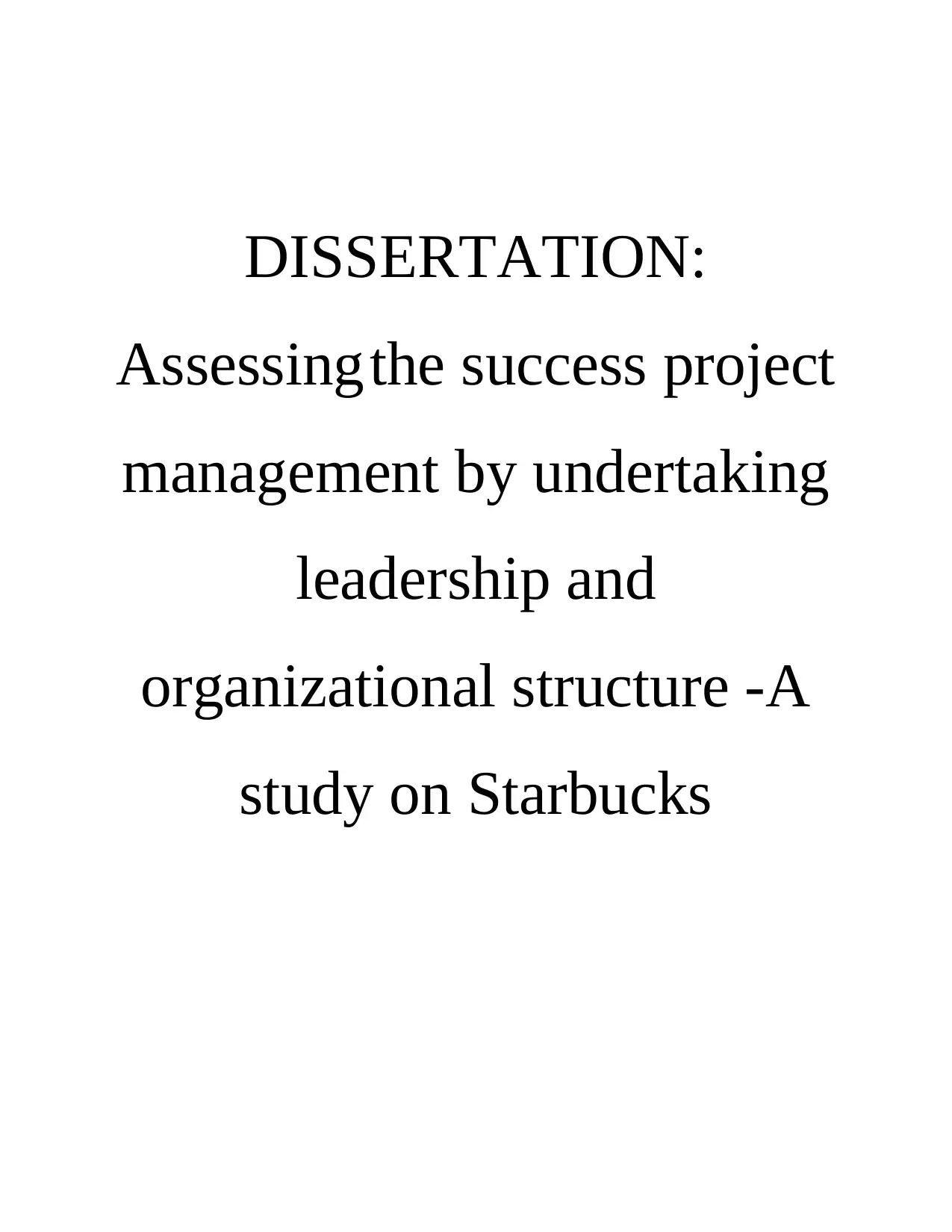
DISSERTATION:
Assessing the success project
management by undertaking
leadership and
organizational structure -A
study on Starbucks
Assessing the success project
management by undertaking
leadership and
organizational structure -A
study on Starbucks
Secure Best Marks with AI Grader
Need help grading? Try our AI Grader for instant feedback on your assignments.

Acknowledgement
I owe my sincere thanks to my mentor motivated and guided me to conduct this work
with full zest. His commitment towards work encouraged me to work hard and complete this
work in right manner. I extend my thanks to family and friends to provide immense support
throughout the research. I would also like to thank my colleagues and team members who
helped me in gathering data and make correct analysis of the study.
I owe my sincere thanks to my mentor motivated and guided me to conduct this work
with full zest. His commitment towards work encouraged me to work hard and complete this
work in right manner. I extend my thanks to family and friends to provide immense support
throughout the research. I would also like to thank my colleagues and team members who
helped me in gathering data and make correct analysis of the study.
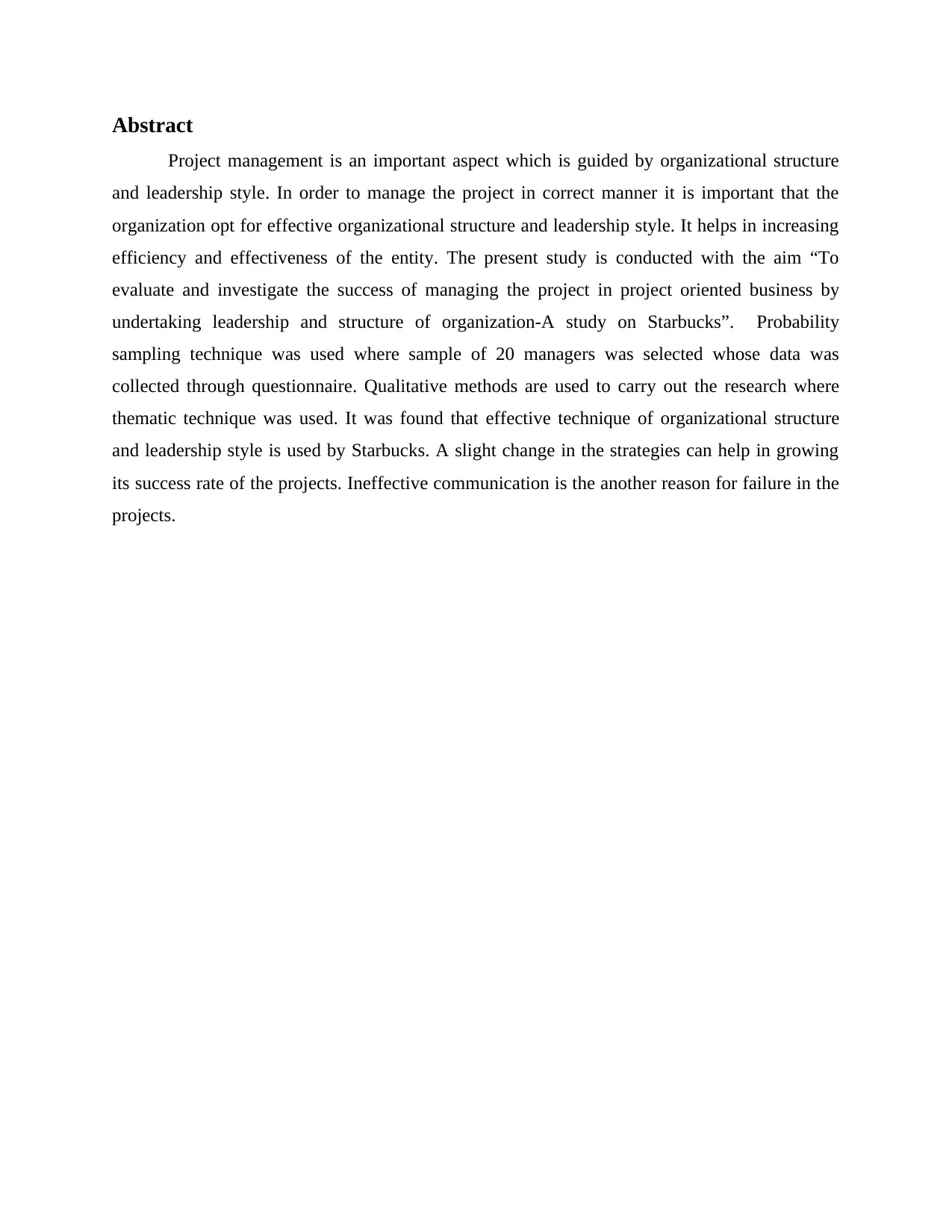
Abstract
Project management is an important aspect which is guided by organizational structure
and leadership style. In order to manage the project in correct manner it is important that the
organization opt for effective organizational structure and leadership style. It helps in increasing
efficiency and effectiveness of the entity. The present study is conducted with the aim “To
evaluate and investigate the success of managing the project in project oriented business by
undertaking leadership and structure of organization-A study on Starbucks”. Probability
sampling technique was used where sample of 20 managers was selected whose data was
collected through questionnaire. Qualitative methods are used to carry out the research where
thematic technique was used. It was found that effective technique of organizational structure
and leadership style is used by Starbucks. A slight change in the strategies can help in growing
its success rate of the projects. Ineffective communication is the another reason for failure in the
projects.
Project management is an important aspect which is guided by organizational structure
and leadership style. In order to manage the project in correct manner it is important that the
organization opt for effective organizational structure and leadership style. It helps in increasing
efficiency and effectiveness of the entity. The present study is conducted with the aim “To
evaluate and investigate the success of managing the project in project oriented business by
undertaking leadership and structure of organization-A study on Starbucks”. Probability
sampling technique was used where sample of 20 managers was selected whose data was
collected through questionnaire. Qualitative methods are used to carry out the research where
thematic technique was used. It was found that effective technique of organizational structure
and leadership style is used by Starbucks. A slight change in the strategies can help in growing
its success rate of the projects. Ineffective communication is the another reason for failure in the
projects.
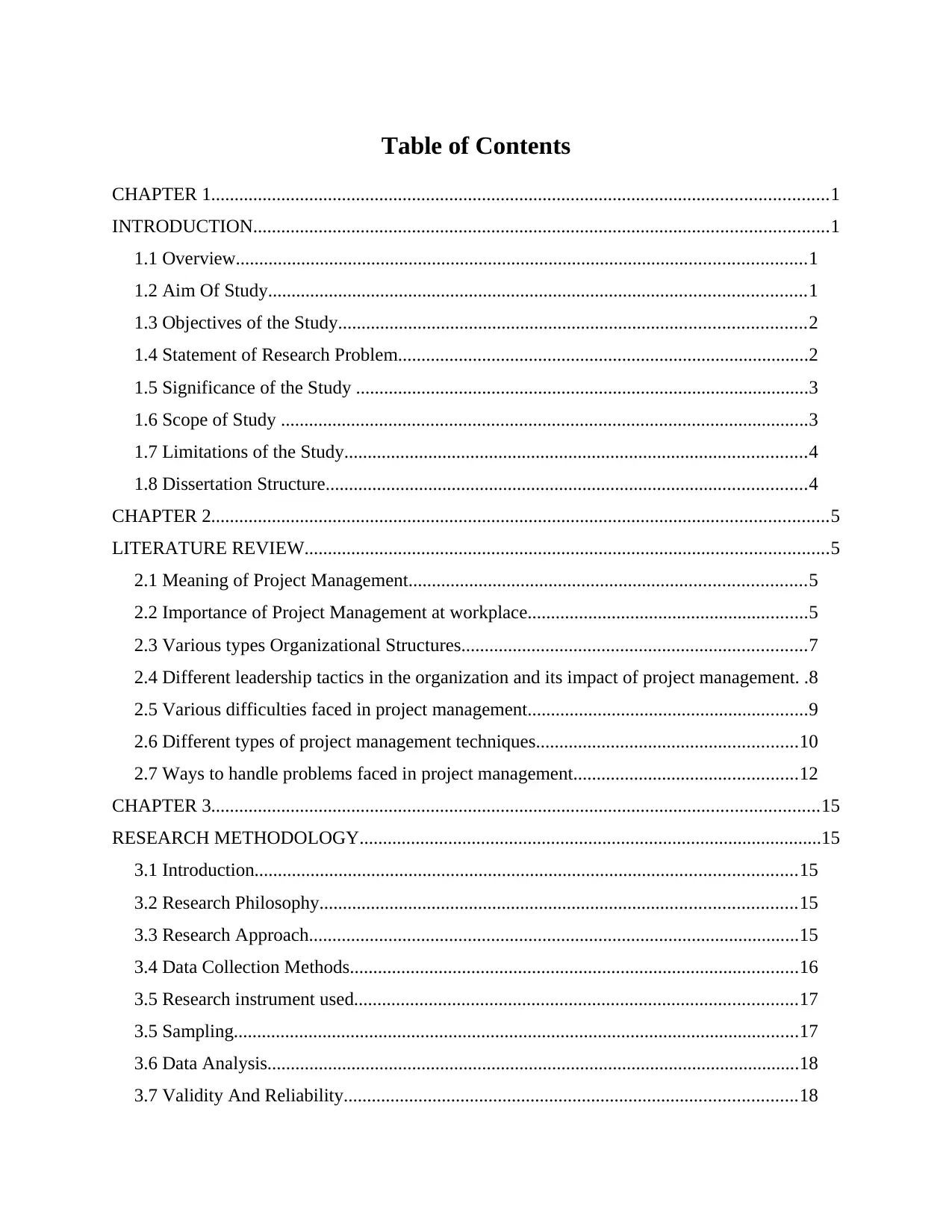
Table of Contents
CHAPTER 1....................................................................................................................................1
INTRODUCTION...........................................................................................................................1
1.1 Overview..........................................................................................................................1
1.2 Aim Of Study...................................................................................................................1
1.3 Objectives of the Study....................................................................................................2
1.4 Statement of Research Problem........................................................................................2
1.5 Significance of the Study .................................................................................................3
1.6 Scope of Study .................................................................................................................3
1.7 Limitations of the Study...................................................................................................4
1.8 Dissertation Structure.......................................................................................................4
CHAPTER 2....................................................................................................................................5
LITERATURE REVIEW................................................................................................................5
2.1 Meaning of Project Management.....................................................................................5
2.2 Importance of Project Management at workplace............................................................5
2.3 Various types Organizational Structures..........................................................................7
2.4 Different leadership tactics in the organization and its impact of project management. .8
2.5 Various difficulties faced in project management............................................................9
2.6 Different types of project management techniques........................................................10
2.7 Ways to handle problems faced in project management................................................12
CHAPTER 3..................................................................................................................................15
RESEARCH METHODOLOGY...................................................................................................15
3.1 Introduction....................................................................................................................15
3.2 Research Philosophy......................................................................................................15
3.3 Research Approach.........................................................................................................15
3.4 Data Collection Methods................................................................................................16
3.5 Research instrument used...............................................................................................17
3.5 Sampling.........................................................................................................................17
3.6 Data Analysis..................................................................................................................18
3.7 Validity And Reliability.................................................................................................18
CHAPTER 1....................................................................................................................................1
INTRODUCTION...........................................................................................................................1
1.1 Overview..........................................................................................................................1
1.2 Aim Of Study...................................................................................................................1
1.3 Objectives of the Study....................................................................................................2
1.4 Statement of Research Problem........................................................................................2
1.5 Significance of the Study .................................................................................................3
1.6 Scope of Study .................................................................................................................3
1.7 Limitations of the Study...................................................................................................4
1.8 Dissertation Structure.......................................................................................................4
CHAPTER 2....................................................................................................................................5
LITERATURE REVIEW................................................................................................................5
2.1 Meaning of Project Management.....................................................................................5
2.2 Importance of Project Management at workplace............................................................5
2.3 Various types Organizational Structures..........................................................................7
2.4 Different leadership tactics in the organization and its impact of project management. .8
2.5 Various difficulties faced in project management............................................................9
2.6 Different types of project management techniques........................................................10
2.7 Ways to handle problems faced in project management................................................12
CHAPTER 3..................................................................................................................................15
RESEARCH METHODOLOGY...................................................................................................15
3.1 Introduction....................................................................................................................15
3.2 Research Philosophy......................................................................................................15
3.3 Research Approach.........................................................................................................15
3.4 Data Collection Methods................................................................................................16
3.5 Research instrument used...............................................................................................17
3.5 Sampling.........................................................................................................................17
3.6 Data Analysis..................................................................................................................18
3.7 Validity And Reliability.................................................................................................18
Secure Best Marks with AI Grader
Need help grading? Try our AI Grader for instant feedback on your assignments.
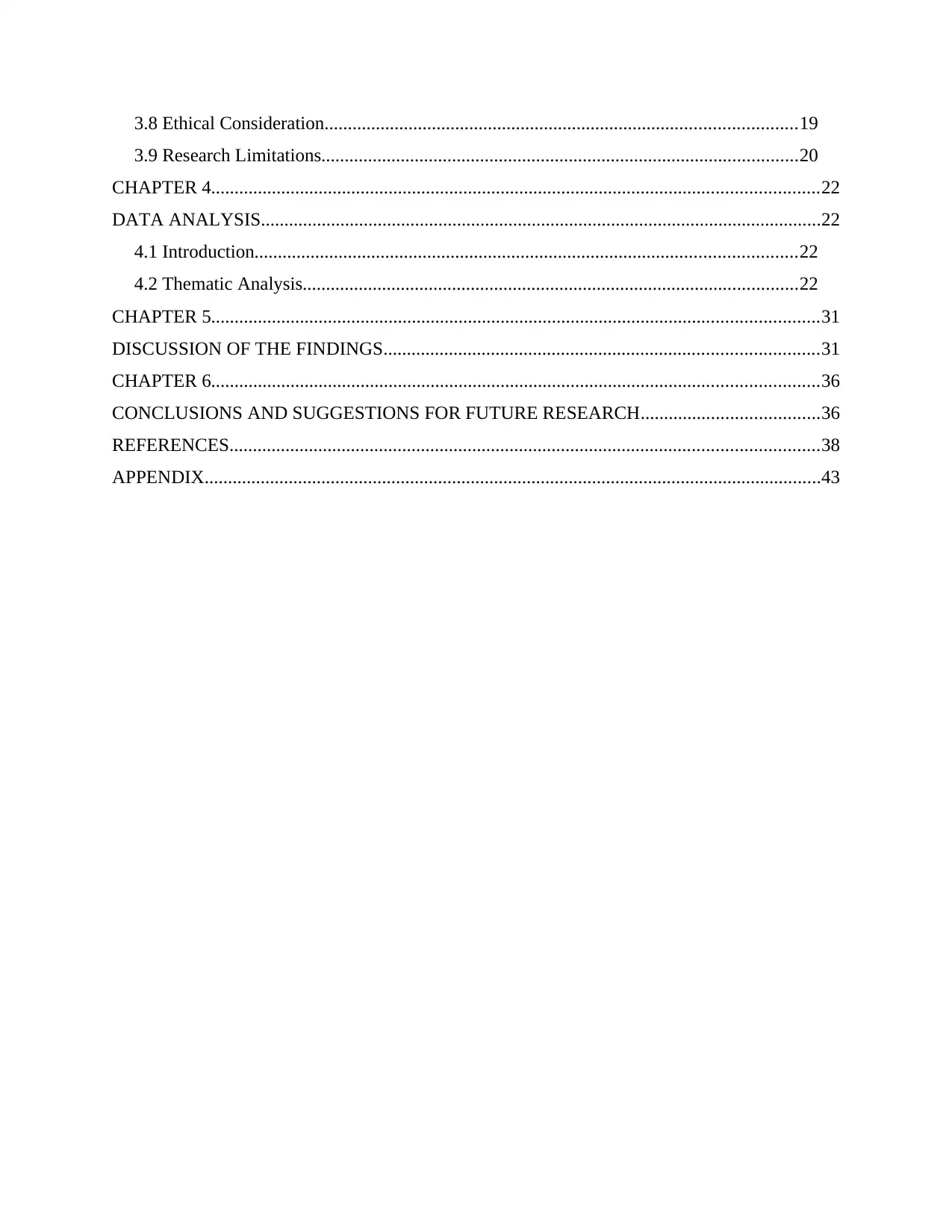
3.8 Ethical Consideration.....................................................................................................19
3.9 Research Limitations......................................................................................................20
CHAPTER 4..................................................................................................................................22
DATA ANALYSIS........................................................................................................................22
4.1 Introduction....................................................................................................................22
4.2 Thematic Analysis..........................................................................................................22
CHAPTER 5..................................................................................................................................31
DISCUSSION OF THE FINDINGS.............................................................................................31
CHAPTER 6..................................................................................................................................36
CONCLUSIONS AND SUGGESTIONS FOR FUTURE RESEARCH......................................36
REFERENCES..............................................................................................................................38
APPENDIX....................................................................................................................................43
3.9 Research Limitations......................................................................................................20
CHAPTER 4..................................................................................................................................22
DATA ANALYSIS........................................................................................................................22
4.1 Introduction....................................................................................................................22
4.2 Thematic Analysis..........................................................................................................22
CHAPTER 5..................................................................................................................................31
DISCUSSION OF THE FINDINGS.............................................................................................31
CHAPTER 6..................................................................................................................................36
CONCLUSIONS AND SUGGESTIONS FOR FUTURE RESEARCH......................................36
REFERENCES..............................................................................................................................38
APPENDIX....................................................................................................................................43
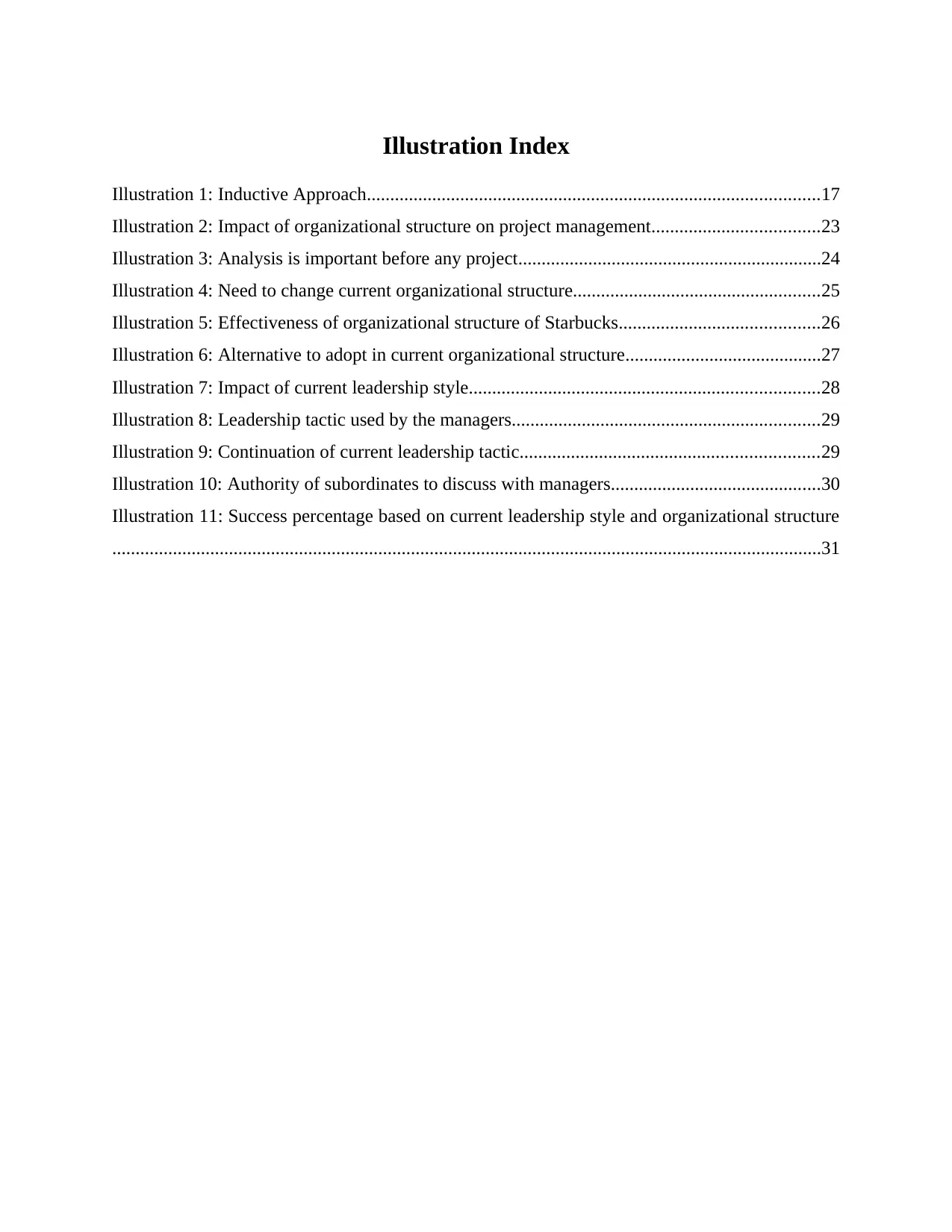
Illustration Index
Illustration 1: Inductive Approach.................................................................................................17
Illustration 2: Impact of organizational structure on project management....................................23
Illustration 3: Analysis is important before any project.................................................................24
Illustration 4: Need to change current organizational structure.....................................................25
Illustration 5: Effectiveness of organizational structure of Starbucks...........................................26
Illustration 6: Alternative to adopt in current organizational structure..........................................27
Illustration 7: Impact of current leadership style...........................................................................28
Illustration 8: Leadership tactic used by the managers..................................................................29
Illustration 9: Continuation of current leadership tactic................................................................29
Illustration 10: Authority of subordinates to discuss with managers.............................................30
Illustration 11: Success percentage based on current leadership style and organizational structure
........................................................................................................................................................31
Illustration 1: Inductive Approach.................................................................................................17
Illustration 2: Impact of organizational structure on project management....................................23
Illustration 3: Analysis is important before any project.................................................................24
Illustration 4: Need to change current organizational structure.....................................................25
Illustration 5: Effectiveness of organizational structure of Starbucks...........................................26
Illustration 6: Alternative to adopt in current organizational structure..........................................27
Illustration 7: Impact of current leadership style...........................................................................28
Illustration 8: Leadership tactic used by the managers..................................................................29
Illustration 9: Continuation of current leadership tactic................................................................29
Illustration 10: Authority of subordinates to discuss with managers.............................................30
Illustration 11: Success percentage based on current leadership style and organizational structure
........................................................................................................................................................31
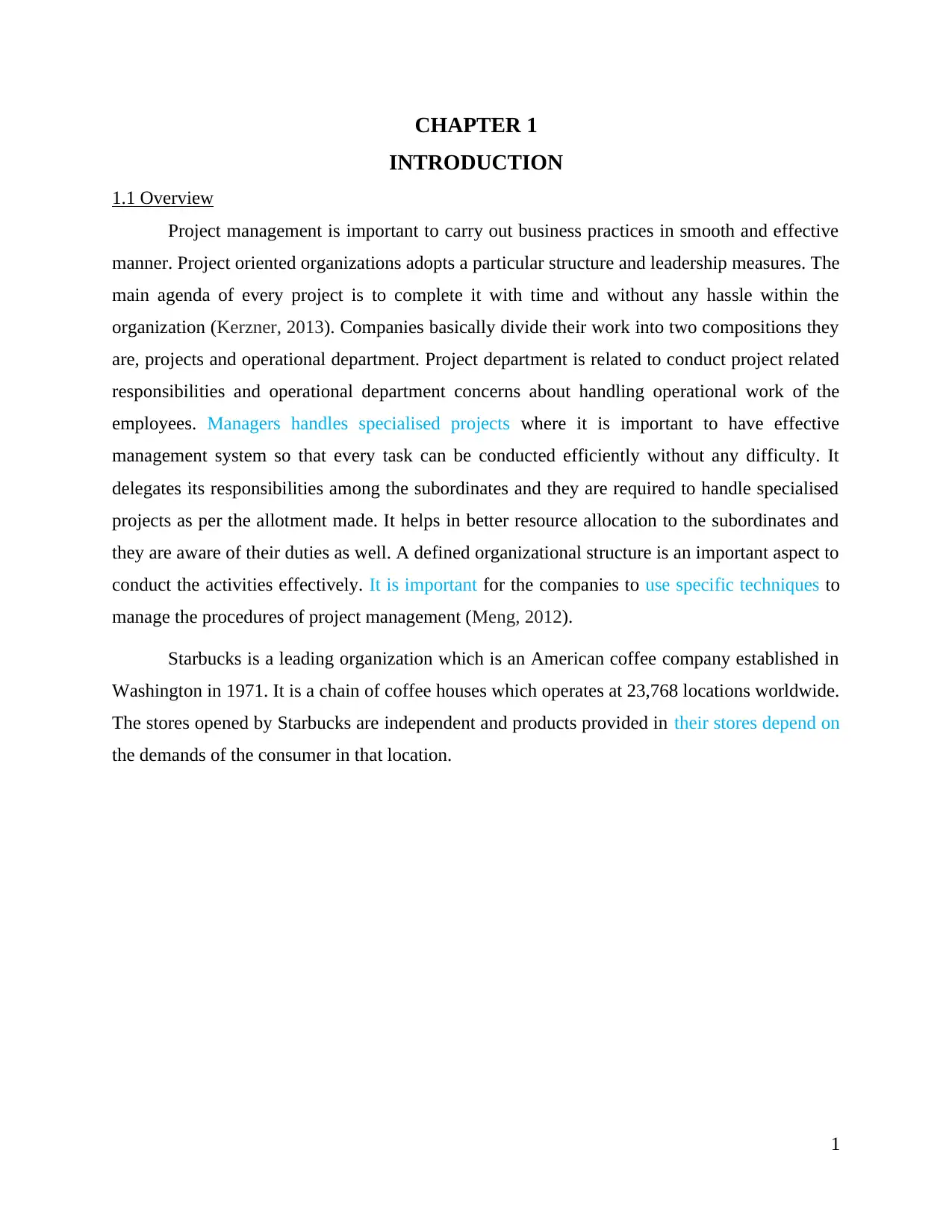
CHAPTER 1
INTRODUCTION
1.1 Overview
Project management is important to carry out business practices in smooth and effective
manner. Project oriented organizations adopts a particular structure and leadership measures. The
main agenda of every project is to complete it with time and without any hassle within the
organization (Kerzner, 2013). Companies basically divide their work into two compositions they
are, projects and operational department. Project department is related to conduct project related
responsibilities and operational department concerns about handling operational work of the
employees. Managers handles specialised projects where it is important to have effective
management system so that every task can be conducted efficiently without any difficulty. It
delegates its responsibilities among the subordinates and they are required to handle specialised
projects as per the allotment made. It helps in better resource allocation to the subordinates and
they are aware of their duties as well. A defined organizational structure is an important aspect to
conduct the activities effectively. It is important for the companies to use specific techniques to
manage the procedures of project management (Meng, 2012).
Starbucks is a leading organization which is an American coffee company established in
Washington in 1971. It is a chain of coffee houses which operates at 23,768 locations worldwide.
The stores opened by Starbucks are independent and products provided in their stores depend on
the demands of the consumer in that location.
1
INTRODUCTION
1.1 Overview
Project management is important to carry out business practices in smooth and effective
manner. Project oriented organizations adopts a particular structure and leadership measures. The
main agenda of every project is to complete it with time and without any hassle within the
organization (Kerzner, 2013). Companies basically divide their work into two compositions they
are, projects and operational department. Project department is related to conduct project related
responsibilities and operational department concerns about handling operational work of the
employees. Managers handles specialised projects where it is important to have effective
management system so that every task can be conducted efficiently without any difficulty. It
delegates its responsibilities among the subordinates and they are required to handle specialised
projects as per the allotment made. It helps in better resource allocation to the subordinates and
they are aware of their duties as well. A defined organizational structure is an important aspect to
conduct the activities effectively. It is important for the companies to use specific techniques to
manage the procedures of project management (Meng, 2012).
Starbucks is a leading organization which is an American coffee company established in
Washington in 1971. It is a chain of coffee houses which operates at 23,768 locations worldwide.
The stores opened by Starbucks are independent and products provided in their stores depend on
the demands of the consumer in that location.
1
Paraphrase This Document
Need a fresh take? Get an instant paraphrase of this document with our AI Paraphraser

1.2 Aim of Study
This report is conducted to carry out investigation for the success of project management
in a project oriented business according to leadership and structure of organization. It has been
determined that business oriented projects are usually made up of matrix organizational
structures. The current work is based on well recognized enterprise, Starbucks. The main aim of
this investigation is to critically investigate the success of project management in business
oriented projects of organization in terms of their undertaken structure and leadership of
organization (Mir and Pinnington, 2014). Its aim is to conduct a study on Starbucks. A specific
aim is not enough to carry out the full survey and some collective objectives are required for a
well-defined study. “To evaluate and investigate the success of managing the project in project
oriented business by undertaking leadership and structure of organization-A study on Starbucks”
1.3 Objectives of the Study
The main objectives of the research are:
To represent the major problems that are faced by the business oriented project such as
Starbucks in the management of their project with acknowledgement of their undertaken
structure and leadership tactics of organization.
To brings the ways in which the problems of the project are been handled by the
Starbucks by applying appropriate concepts of project management, techniques and
methods.
To evaluate and examine the various ways in which the problems are been handled by
applying proper concepts, tools and techniques of concepts of project management.
1.4 Statement of Research Problem
The structure of Starbucks is matrix organization. This type of structure represents
composition which generally consists of two elements such as project department and
operational department. The functional or operational department deals with the operational
work of employees by handling together all aspects of personnel resources. However, the project
department on the other hand consist of delegated project manager with particular
responsibilities of project and are needed to manage the specialised projects of the organization.
Such structure of organization can be beneficial for allocation of resources with the balanced
authorization of distributors whose task is to allot resources.
2
This report is conducted to carry out investigation for the success of project management
in a project oriented business according to leadership and structure of organization. It has been
determined that business oriented projects are usually made up of matrix organizational
structures. The current work is based on well recognized enterprise, Starbucks. The main aim of
this investigation is to critically investigate the success of project management in business
oriented projects of organization in terms of their undertaken structure and leadership of
organization (Mir and Pinnington, 2014). Its aim is to conduct a study on Starbucks. A specific
aim is not enough to carry out the full survey and some collective objectives are required for a
well-defined study. “To evaluate and investigate the success of managing the project in project
oriented business by undertaking leadership and structure of organization-A study on Starbucks”
1.3 Objectives of the Study
The main objectives of the research are:
To represent the major problems that are faced by the business oriented project such as
Starbucks in the management of their project with acknowledgement of their undertaken
structure and leadership tactics of organization.
To brings the ways in which the problems of the project are been handled by the
Starbucks by applying appropriate concepts of project management, techniques and
methods.
To evaluate and examine the various ways in which the problems are been handled by
applying proper concepts, tools and techniques of concepts of project management.
1.4 Statement of Research Problem
The structure of Starbucks is matrix organization. This type of structure represents
composition which generally consists of two elements such as project department and
operational department. The functional or operational department deals with the operational
work of employees by handling together all aspects of personnel resources. However, the project
department on the other hand consist of delegated project manager with particular
responsibilities of project and are needed to manage the specialised projects of the organization.
Such structure of organization can be beneficial for allocation of resources with the balanced
authorization of distributors whose task is to allot resources.
2
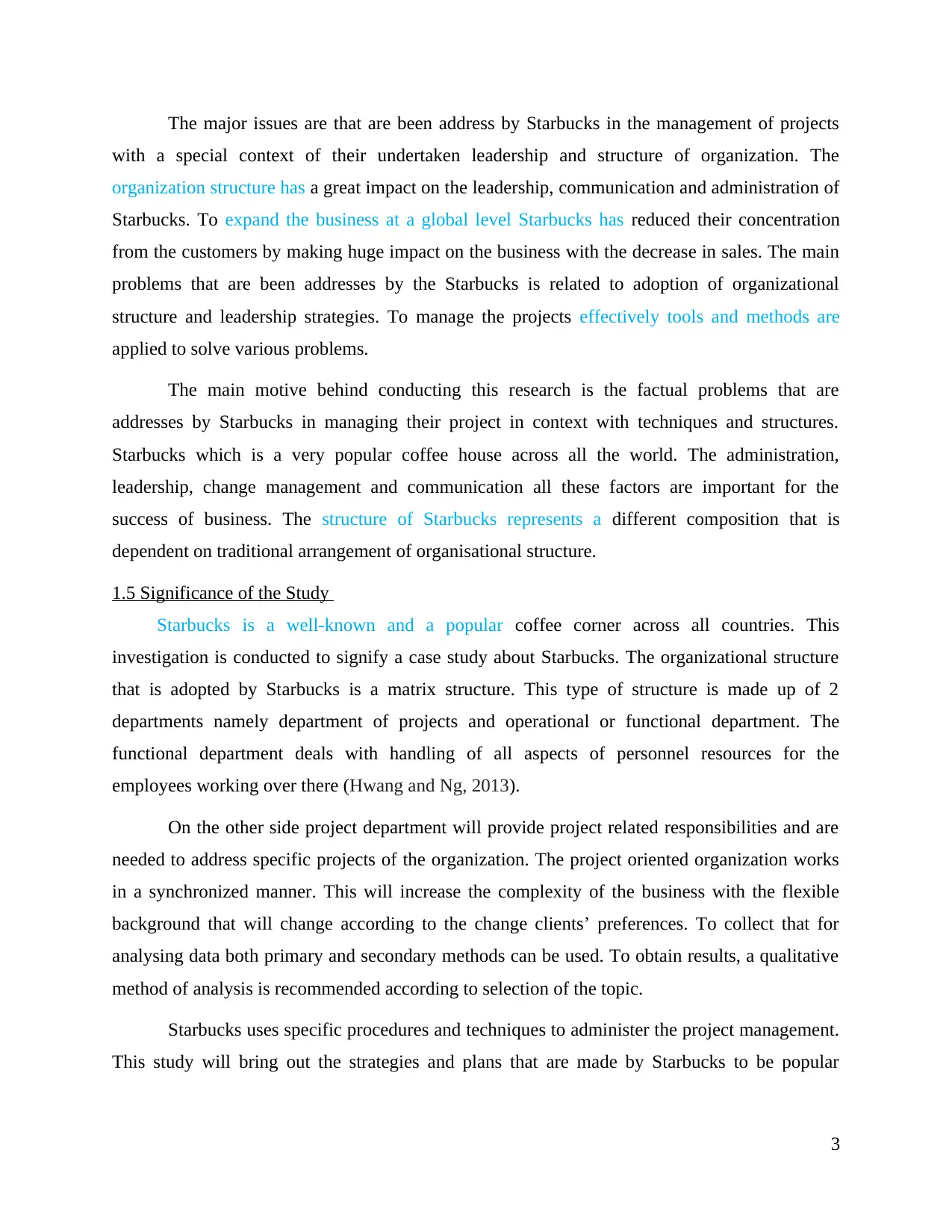
The major issues are that are been address by Starbucks in the management of projects
with a special context of their undertaken leadership and structure of organization. The
organization structure has a great impact on the leadership, communication and administration of
Starbucks. To expand the business at a global level Starbucks has reduced their concentration
from the customers by making huge impact on the business with the decrease in sales. The main
problems that are been addresses by the Starbucks is related to adoption of organizational
structure and leadership strategies. To manage the projects effectively tools and methods are
applied to solve various problems.
The main motive behind conducting this research is the factual problems that are
addresses by Starbucks in managing their project in context with techniques and structures.
Starbucks which is a very popular coffee house across all the world. The administration,
leadership, change management and communication all these factors are important for the
success of business. The structure of Starbucks represents a different composition that is
dependent on traditional arrangement of organisational structure.
1.5 Significance of the Study
Starbucks is a well-known and a popular coffee corner across all countries. This
investigation is conducted to signify a case study about Starbucks. The organizational structure
that is adopted by Starbucks is a matrix structure. This type of structure is made up of 2
departments namely department of projects and operational or functional department. The
functional department deals with handling of all aspects of personnel resources for the
employees working over there (Hwang and Ng, 2013).
On the other side project department will provide project related responsibilities and are
needed to address specific projects of the organization. The project oriented organization works
in a synchronized manner. This will increase the complexity of the business with the flexible
background that will change according to the change clients’ preferences. To collect that for
analysing data both primary and secondary methods can be used. To obtain results, a qualitative
method of analysis is recommended according to selection of the topic.
Starbucks uses specific procedures and techniques to administer the project management.
This study will bring out the strategies and plans that are made by Starbucks to be popular
3
with a special context of their undertaken leadership and structure of organization. The
organization structure has a great impact on the leadership, communication and administration of
Starbucks. To expand the business at a global level Starbucks has reduced their concentration
from the customers by making huge impact on the business with the decrease in sales. The main
problems that are been addresses by the Starbucks is related to adoption of organizational
structure and leadership strategies. To manage the projects effectively tools and methods are
applied to solve various problems.
The main motive behind conducting this research is the factual problems that are
addresses by Starbucks in managing their project in context with techniques and structures.
Starbucks which is a very popular coffee house across all the world. The administration,
leadership, change management and communication all these factors are important for the
success of business. The structure of Starbucks represents a different composition that is
dependent on traditional arrangement of organisational structure.
1.5 Significance of the Study
Starbucks is a well-known and a popular coffee corner across all countries. This
investigation is conducted to signify a case study about Starbucks. The organizational structure
that is adopted by Starbucks is a matrix structure. This type of structure is made up of 2
departments namely department of projects and operational or functional department. The
functional department deals with handling of all aspects of personnel resources for the
employees working over there (Hwang and Ng, 2013).
On the other side project department will provide project related responsibilities and are
needed to address specific projects of the organization. The project oriented organization works
in a synchronized manner. This will increase the complexity of the business with the flexible
background that will change according to the change clients’ preferences. To collect that for
analysing data both primary and secondary methods can be used. To obtain results, a qualitative
method of analysis is recommended according to selection of the topic.
Starbucks uses specific procedures and techniques to administer the project management.
This study will bring out the strategies and plans that are made by Starbucks to be popular
3

among the country. It will also specify the issues that are addresses by Starbucks in the
management of their projects (Martinelli and Milosevic, 2016).
1.6 Scope of Study
This study will be beneficial for examining the problems that occurred in Starbucks so
that efficient methods, tools and techniques can be used to overcome that issue efficiently. This
study will help to develop and use more appropriate organizational structures for Starbucks to
cope up the problems that are occurring in the management of projects. If in future any such
issue arises then the organization will be able to deal it in a more appropriate ways.
1.7 Limitations of the Study
This study is not able to represent the Starbucks tools and techniques that are used in
business properly. More detailed knowledge about the techniques and tools need to be given so
that proper knowledge can be gained from it (Turner, 2016).
1.8 Dissertation Structure Introduction- This research is carried out on project management and in this section of
the report components of the projects such as requirement of leadership skills are
discussed. Starbucks have been chosen as an organization to conduct the research on.
Hence, different techniques that are used by the company are also discussed. The aim and
objective of the research in also discussed to give a clear idea. Literature review- Literature review on project management is done in order to
understand past scenario as well as the researched that have already been conducted. On
that basis evaluation of literature this research is carried out by the researcher. It will help
to develop the better understanding of the topic and carry out further research based on it. Research methodology- In this part of report, data analysis techniques is analysed.
Further, it provides a clear idea regarding execution of the research project. Data analysis- In this section of the report, Data collected is analysed with the help of
various tools and techniques. It helps in studying the data collected and draw an overall
conclusion of the report. Discussion- After data analysis, it is evaluated to get an overview of the results of the
research. It helps in drawing the conclusion of the research as well.
4
management of their projects (Martinelli and Milosevic, 2016).
1.6 Scope of Study
This study will be beneficial for examining the problems that occurred in Starbucks so
that efficient methods, tools and techniques can be used to overcome that issue efficiently. This
study will help to develop and use more appropriate organizational structures for Starbucks to
cope up the problems that are occurring in the management of projects. If in future any such
issue arises then the organization will be able to deal it in a more appropriate ways.
1.7 Limitations of the Study
This study is not able to represent the Starbucks tools and techniques that are used in
business properly. More detailed knowledge about the techniques and tools need to be given so
that proper knowledge can be gained from it (Turner, 2016).
1.8 Dissertation Structure Introduction- This research is carried out on project management and in this section of
the report components of the projects such as requirement of leadership skills are
discussed. Starbucks have been chosen as an organization to conduct the research on.
Hence, different techniques that are used by the company are also discussed. The aim and
objective of the research in also discussed to give a clear idea. Literature review- Literature review on project management is done in order to
understand past scenario as well as the researched that have already been conducted. On
that basis evaluation of literature this research is carried out by the researcher. It will help
to develop the better understanding of the topic and carry out further research based on it. Research methodology- In this part of report, data analysis techniques is analysed.
Further, it provides a clear idea regarding execution of the research project. Data analysis- In this section of the report, Data collected is analysed with the help of
various tools and techniques. It helps in studying the data collected and draw an overall
conclusion of the report. Discussion- After data analysis, it is evaluated to get an overview of the results of the
research. It helps in drawing the conclusion of the research as well.
4
Secure Best Marks with AI Grader
Need help grading? Try our AI Grader for instant feedback on your assignments.
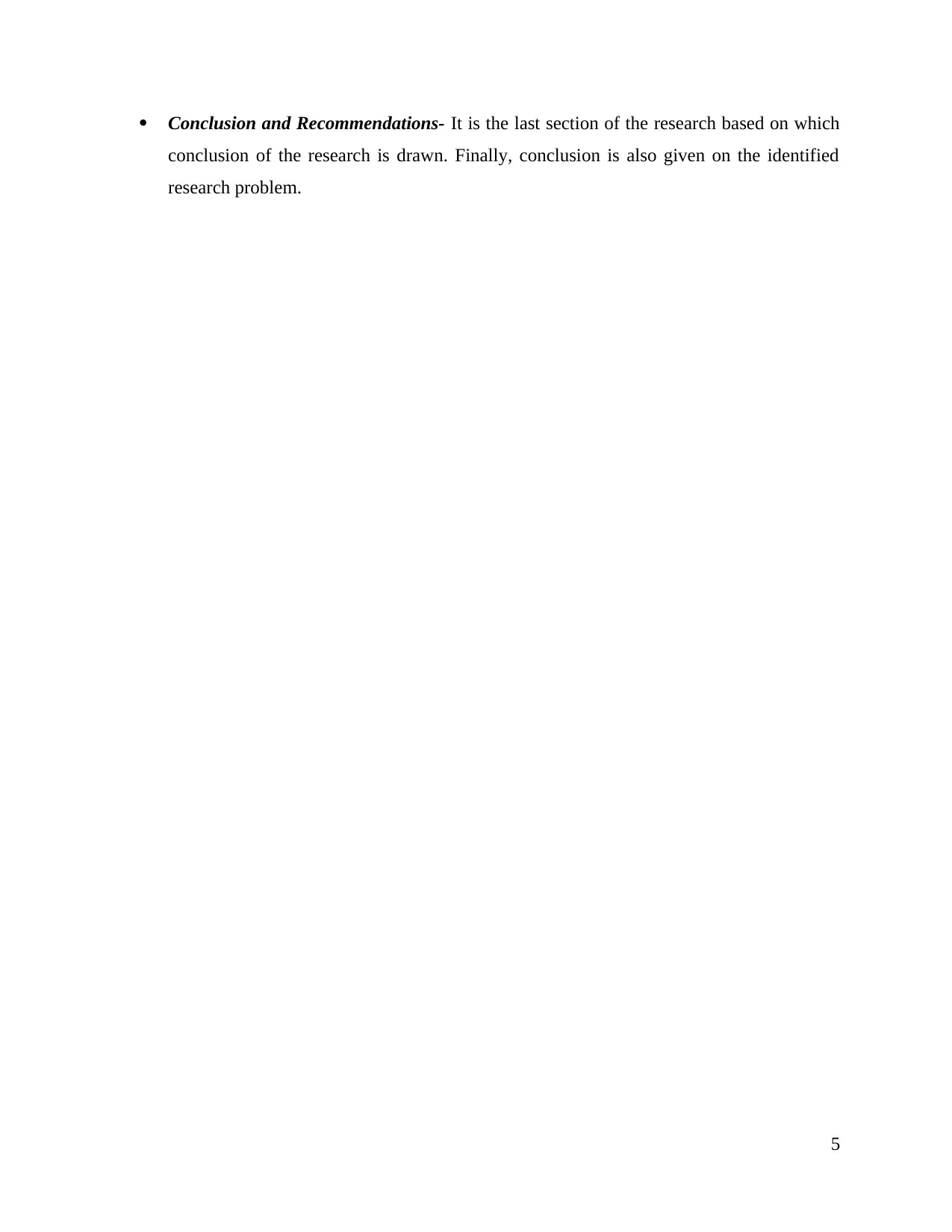
Conclusion and Recommendations- It is the last section of the research based on which
conclusion of the research is drawn. Finally, conclusion is also given on the identified
research problem.
5
conclusion of the research is drawn. Finally, conclusion is also given on the identified
research problem.
5

CHAPTER 2
LITERATURE REVIEW
2.1 Meaning of Project Management
According to Grefen, Pernici and Sánchez (2012), project management is a discipline to
initiate, plan, execute, control and close the work of the team in order to achieve organizational
goals. It helps in producing in the work in such a way as planned by the top level management of
the company. However, as per the views of Verzuh (2015), the main of project management is to
divide the work among the subordinates in such a way that it ensures success after a particular
duration. It is important for the plan to be effective enough so that the main objectives of the
entity can be fulfilled. According to Turner (2016), every plan is prepared with a time constraint
and allocation is performed based on it. If the fulfilment is not made within that time constraint
then it can lead to project failure. Another important things to be considered while developing a
plan are, time, scope, quality and budget. However, in the contrast to that, as per the views of
Nicholas and Steyn (2017), the major challenge is resource allocation and proper optimization. It
helps in applying the inputs in such a way that it in the end gets better outputs as planned by the
enterprise.
According to Martinelli and Milosevic (2016), project management ensures that the
deliverable will reach to the concerned person in specified time and the plan for handling the
project will be prepared in such a way that the probability of success is quite high. One of the
most important reason for failure of the project is that it must have not been managed in effective
manner. According to Heldman (2015), it helps in better planning and implementation of the
project. Project manager guides the project from beginning to the end with the ideal goal that it
will be delivered within time and budget.
2.2 Importance of Project Management at workplace
According to Rose (2013), project management ensures that the project gets completed
within time. Various companies tend to hire project manager which ensures all aspects of the
deliverables. It also ensures project management needs. However, in contrast to this, Unger and
et.al (2012) asserted that it is step down process which is required to be followed in the same
manner at the workplace. The steps of project management include:
Defining goals of the project
Outlining the steps that are required to be achieved in the goal.
6
LITERATURE REVIEW
2.1 Meaning of Project Management
According to Grefen, Pernici and Sánchez (2012), project management is a discipline to
initiate, plan, execute, control and close the work of the team in order to achieve organizational
goals. It helps in producing in the work in such a way as planned by the top level management of
the company. However, as per the views of Verzuh (2015), the main of project management is to
divide the work among the subordinates in such a way that it ensures success after a particular
duration. It is important for the plan to be effective enough so that the main objectives of the
entity can be fulfilled. According to Turner (2016), every plan is prepared with a time constraint
and allocation is performed based on it. If the fulfilment is not made within that time constraint
then it can lead to project failure. Another important things to be considered while developing a
plan are, time, scope, quality and budget. However, in the contrast to that, as per the views of
Nicholas and Steyn (2017), the major challenge is resource allocation and proper optimization. It
helps in applying the inputs in such a way that it in the end gets better outputs as planned by the
enterprise.
According to Martinelli and Milosevic (2016), project management ensures that the
deliverable will reach to the concerned person in specified time and the plan for handling the
project will be prepared in such a way that the probability of success is quite high. One of the
most important reason for failure of the project is that it must have not been managed in effective
manner. According to Heldman (2015), it helps in better planning and implementation of the
project. Project manager guides the project from beginning to the end with the ideal goal that it
will be delivered within time and budget.
2.2 Importance of Project Management at workplace
According to Rose (2013), project management ensures that the project gets completed
within time. Various companies tend to hire project manager which ensures all aspects of the
deliverables. It also ensures project management needs. However, in contrast to this, Unger and
et.al (2012) asserted that it is step down process which is required to be followed in the same
manner at the workplace. The steps of project management include:
Defining goals of the project
Outlining the steps that are required to be achieved in the goal.
6
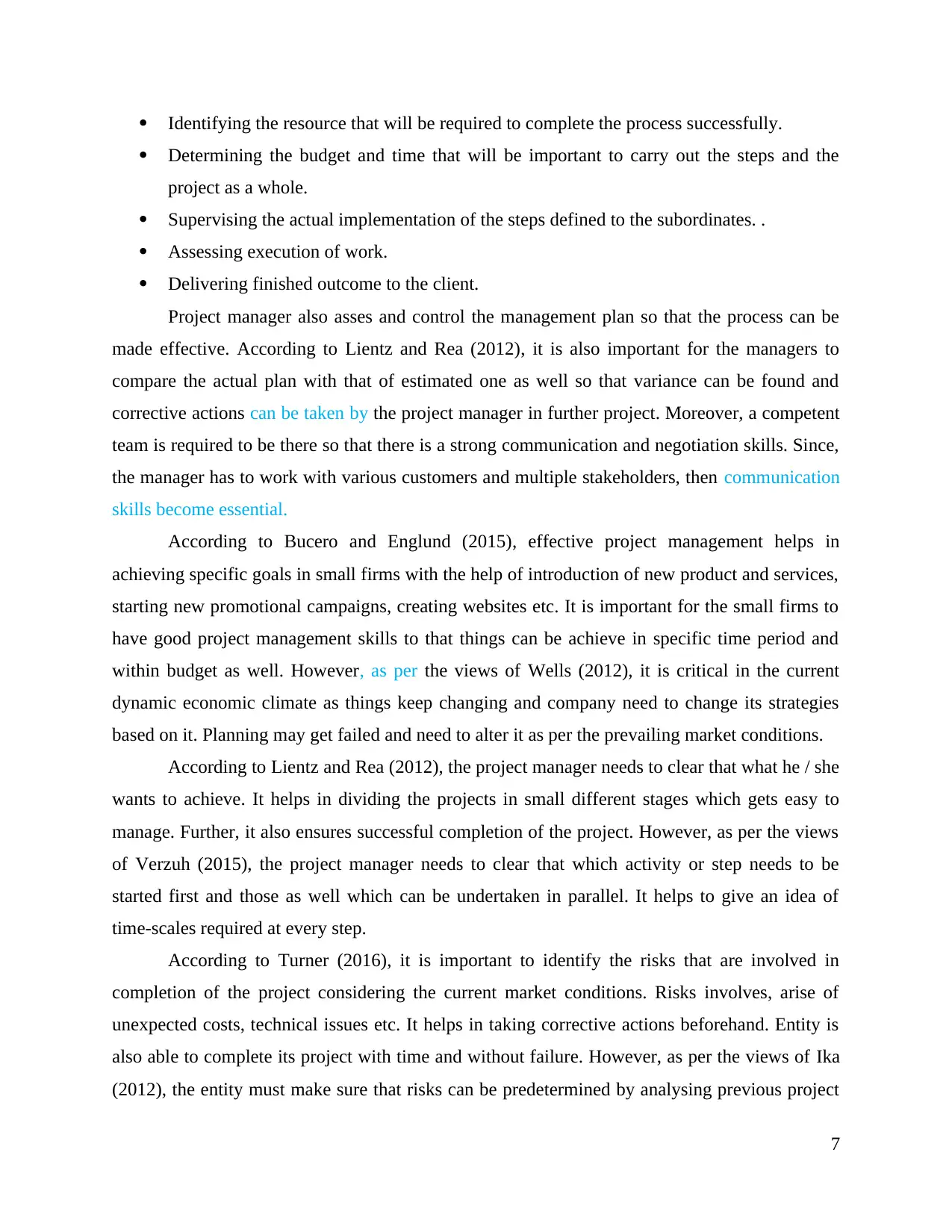
Identifying the resource that will be required to complete the process successfully.
Determining the budget and time that will be important to carry out the steps and the
project as a whole.
Supervising the actual implementation of the steps defined to the subordinates. .
Assessing execution of work.
Delivering finished outcome to the client.
Project manager also asses and control the management plan so that the process can be
made effective. According to Lientz and Rea (2012), it is also important for the managers to
compare the actual plan with that of estimated one as well so that variance can be found and
corrective actions can be taken by the project manager in further project. Moreover, a competent
team is required to be there so that there is a strong communication and negotiation skills. Since,
the manager has to work with various customers and multiple stakeholders, then communication
skills become essential.
According to Bucero and Englund (2015), effective project management helps in
achieving specific goals in small firms with the help of introduction of new product and services,
starting new promotional campaigns, creating websites etc. It is important for the small firms to
have good project management skills to that things can be achieve in specific time period and
within budget as well. However, as per the views of Wells (2012), it is critical in the current
dynamic economic climate as things keep changing and company need to change its strategies
based on it. Planning may get failed and need to alter it as per the prevailing market conditions.
According to Lientz and Rea (2012), the project manager needs to clear that what he / she
wants to achieve. It helps in dividing the projects in small different stages which gets easy to
manage. Further, it also ensures successful completion of the project. However, as per the views
of Verzuh (2015), the project manager needs to clear that which activity or step needs to be
started first and those as well which can be undertaken in parallel. It helps to give an idea of
time-scales required at every step.
According to Turner (2016), it is important to identify the risks that are involved in
completion of the project considering the current market conditions. Risks involves, arise of
unexpected costs, technical issues etc. It helps in taking corrective actions beforehand. Entity is
also able to complete its project with time and without failure. However, as per the views of Ika
(2012), the entity must make sure that risks can be predetermined by analysing previous project
7
Determining the budget and time that will be important to carry out the steps and the
project as a whole.
Supervising the actual implementation of the steps defined to the subordinates. .
Assessing execution of work.
Delivering finished outcome to the client.
Project manager also asses and control the management plan so that the process can be
made effective. According to Lientz and Rea (2012), it is also important for the managers to
compare the actual plan with that of estimated one as well so that variance can be found and
corrective actions can be taken by the project manager in further project. Moreover, a competent
team is required to be there so that there is a strong communication and negotiation skills. Since,
the manager has to work with various customers and multiple stakeholders, then communication
skills become essential.
According to Bucero and Englund (2015), effective project management helps in
achieving specific goals in small firms with the help of introduction of new product and services,
starting new promotional campaigns, creating websites etc. It is important for the small firms to
have good project management skills to that things can be achieve in specific time period and
within budget as well. However, as per the views of Wells (2012), it is critical in the current
dynamic economic climate as things keep changing and company need to change its strategies
based on it. Planning may get failed and need to alter it as per the prevailing market conditions.
According to Lientz and Rea (2012), the project manager needs to clear that what he / she
wants to achieve. It helps in dividing the projects in small different stages which gets easy to
manage. Further, it also ensures successful completion of the project. However, as per the views
of Verzuh (2015), the project manager needs to clear that which activity or step needs to be
started first and those as well which can be undertaken in parallel. It helps to give an idea of
time-scales required at every step.
According to Turner (2016), it is important to identify the risks that are involved in
completion of the project considering the current market conditions. Risks involves, arise of
unexpected costs, technical issues etc. It helps in taking corrective actions beforehand. Entity is
also able to complete its project with time and without failure. However, as per the views of Ika
(2012), the entity must make sure that risks can be predetermined by analysing previous project
7
Paraphrase This Document
Need a fresh take? Get an instant paraphrase of this document with our AI Paraphraser
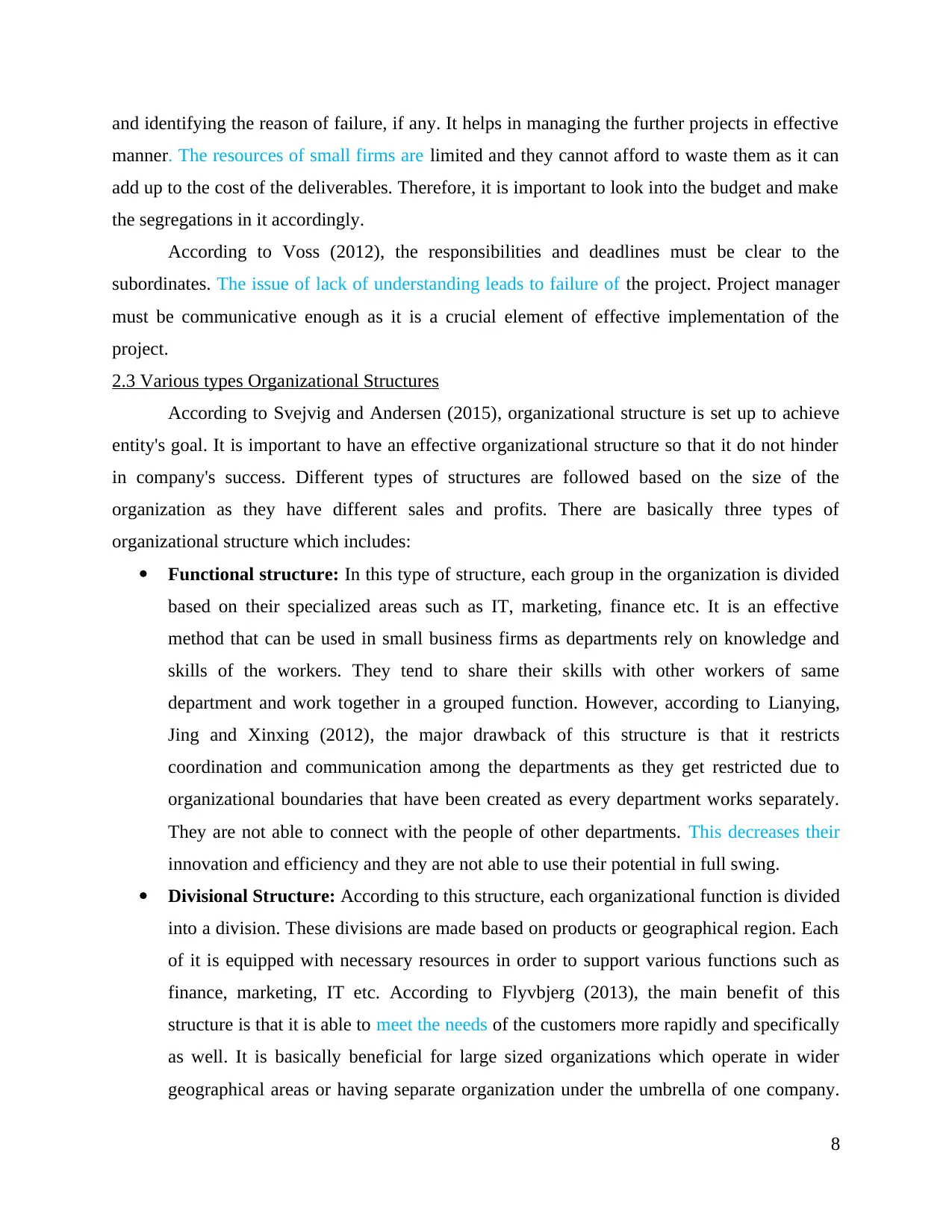
and identifying the reason of failure, if any. It helps in managing the further projects in effective
manner. The resources of small firms are limited and they cannot afford to waste them as it can
add up to the cost of the deliverables. Therefore, it is important to look into the budget and make
the segregations in it accordingly.
According to Voss (2012), the responsibilities and deadlines must be clear to the
subordinates. The issue of lack of understanding leads to failure of the project. Project manager
must be communicative enough as it is a crucial element of effective implementation of the
project.
2.3 Various types Organizational Structures
According to Svejvig and Andersen (2015), organizational structure is set up to achieve
entity's goal. It is important to have an effective organizational structure so that it do not hinder
in company's success. Different types of structures are followed based on the size of the
organization as they have different sales and profits. There are basically three types of
organizational structure which includes:
Functional structure: In this type of structure, each group in the organization is divided
based on their specialized areas such as IT, marketing, finance etc. It is an effective
method that can be used in small business firms as departments rely on knowledge and
skills of the workers. They tend to share their skills with other workers of same
department and work together in a grouped function. However, according to Lianying,
Jing and Xinxing (2012), the major drawback of this structure is that it restricts
coordination and communication among the departments as they get restricted due to
organizational boundaries that have been created as every department works separately.
They are not able to connect with the people of other departments. This decreases their
innovation and efficiency and they are not able to use their potential in full swing.
Divisional Structure: According to this structure, each organizational function is divided
into a division. These divisions are made based on products or geographical region. Each
of it is equipped with necessary resources in order to support various functions such as
finance, marketing, IT etc. According to Flyvbjerg (2013), the main benefit of this
structure is that it is able to meet the needs of the customers more rapidly and specifically
as well. It is basically beneficial for large sized organizations which operate in wider
geographical areas or having separate organization under the umbrella of one company.
8
manner. The resources of small firms are limited and they cannot afford to waste them as it can
add up to the cost of the deliverables. Therefore, it is important to look into the budget and make
the segregations in it accordingly.
According to Voss (2012), the responsibilities and deadlines must be clear to the
subordinates. The issue of lack of understanding leads to failure of the project. Project manager
must be communicative enough as it is a crucial element of effective implementation of the
project.
2.3 Various types Organizational Structures
According to Svejvig and Andersen (2015), organizational structure is set up to achieve
entity's goal. It is important to have an effective organizational structure so that it do not hinder
in company's success. Different types of structures are followed based on the size of the
organization as they have different sales and profits. There are basically three types of
organizational structure which includes:
Functional structure: In this type of structure, each group in the organization is divided
based on their specialized areas such as IT, marketing, finance etc. It is an effective
method that can be used in small business firms as departments rely on knowledge and
skills of the workers. They tend to share their skills with other workers of same
department and work together in a grouped function. However, according to Lianying,
Jing and Xinxing (2012), the major drawback of this structure is that it restricts
coordination and communication among the departments as they get restricted due to
organizational boundaries that have been created as every department works separately.
They are not able to connect with the people of other departments. This decreases their
innovation and efficiency and they are not able to use their potential in full swing.
Divisional Structure: According to this structure, each organizational function is divided
into a division. These divisions are made based on products or geographical region. Each
of it is equipped with necessary resources in order to support various functions such as
finance, marketing, IT etc. According to Flyvbjerg (2013), the main benefit of this
structure is that it is able to meet the needs of the customers more rapidly and specifically
as well. It is basically beneficial for large sized organizations which operate in wider
geographical areas or having separate organization under the umbrella of one company.
8

These divisions don't work together but they tend to fall under one enterprise only It is
useful as failure of one division does not impact the success of the others. In contrast to
this, as per the views of Ika (2012), the main disadvantage of divisional structure is that
inefficient operations due to separate specialized function. It also increases accounting ad
taxes as the parent company is responsible for all the entities that falls under that
umbrella.
Matrix Structure: It is basically a hybrid of functional and divisional structure which is
typically used by large multinational organizations. In this, individuals are grouped in
two different perspectives at the same time. According to Marcelino-Sádaba and et.al.
(2014), it is more dynamic as compared to that of functional management. It helps in
sharing the information among the individuals across the boundaries of the tasks. It also
helps the employees to share their knowledge and work more effectively. As it is
complex structure to handle it is suitable for the functioning of larger organizations only.
However, in contract to this, as per the views of Hornstein (2015), it is a complex
structure and it creates hindrance in the chain of command which further increases
manager to work ratio and creates conflicts in the employee's loyalty.
2.4 Different leadership tactics in the organization and its impact of project management
According to Bucero and Englund (2015), leadership is an ability to of management of
the company to achieve goals of the organization which are challenging. It helps in taking swift
decisions and actions where required. It involves establishing a clear vision, sharing it in order to
understand their point of view, provide information and knowledge, coordinate and balance
conflicting interests between the subordinates. However, as per the views of Joslin and Müller
(2015), the personality of a leader and a worker may not match which can encourage conflicts in
the organization. It may be effective if the leader is able to carry out the task effectively and able
to increase the productivity of the employees. It boosts the morale of subordinates in order to
work efficiently and enjoy what they are doing.
According to Besner and Hobbs (2013), there are various leadership tactics that are used
by the leaders in order to complete the work effectively. Some of them are mentioned below:
Direction: It is an authoritative technique where orders are directly given to the
subordinates. This technique can be used only when it possesses that power. Attempting
9
useful as failure of one division does not impact the success of the others. In contrast to
this, as per the views of Ika (2012), the main disadvantage of divisional structure is that
inefficient operations due to separate specialized function. It also increases accounting ad
taxes as the parent company is responsible for all the entities that falls under that
umbrella.
Matrix Structure: It is basically a hybrid of functional and divisional structure which is
typically used by large multinational organizations. In this, individuals are grouped in
two different perspectives at the same time. According to Marcelino-Sádaba and et.al.
(2014), it is more dynamic as compared to that of functional management. It helps in
sharing the information among the individuals across the boundaries of the tasks. It also
helps the employees to share their knowledge and work more effectively. As it is
complex structure to handle it is suitable for the functioning of larger organizations only.
However, in contract to this, as per the views of Hornstein (2015), it is a complex
structure and it creates hindrance in the chain of command which further increases
manager to work ratio and creates conflicts in the employee's loyalty.
2.4 Different leadership tactics in the organization and its impact of project management
According to Bucero and Englund (2015), leadership is an ability to of management of
the company to achieve goals of the organization which are challenging. It helps in taking swift
decisions and actions where required. It involves establishing a clear vision, sharing it in order to
understand their point of view, provide information and knowledge, coordinate and balance
conflicting interests between the subordinates. However, as per the views of Joslin and Müller
(2015), the personality of a leader and a worker may not match which can encourage conflicts in
the organization. It may be effective if the leader is able to carry out the task effectively and able
to increase the productivity of the employees. It boosts the morale of subordinates in order to
work efficiently and enjoy what they are doing.
According to Besner and Hobbs (2013), there are various leadership tactics that are used
by the leaders in order to complete the work effectively. Some of them are mentioned below:
Direction: It is an authoritative technique where orders are directly given to the
subordinates. This technique can be used only when it possesses that power. Attempting
9
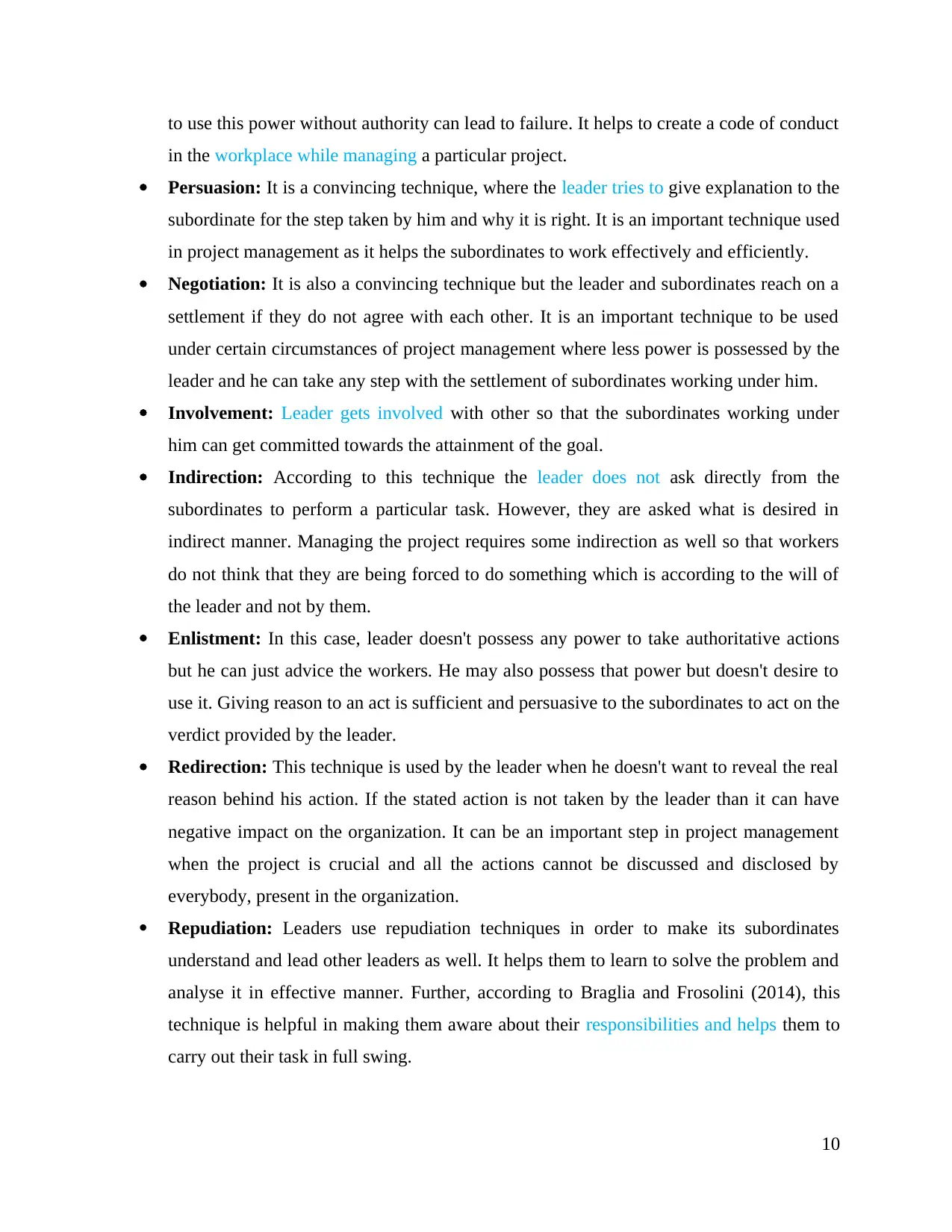
to use this power without authority can lead to failure. It helps to create a code of conduct
in the workplace while managing a particular project.
Persuasion: It is a convincing technique, where the leader tries to give explanation to the
subordinate for the step taken by him and why it is right. It is an important technique used
in project management as it helps the subordinates to work effectively and efficiently.
Negotiation: It is also a convincing technique but the leader and subordinates reach on a
settlement if they do not agree with each other. It is an important technique to be used
under certain circumstances of project management where less power is possessed by the
leader and he can take any step with the settlement of subordinates working under him.
Involvement: Leader gets involved with other so that the subordinates working under
him can get committed towards the attainment of the goal.
Indirection: According to this technique the leader does not ask directly from the
subordinates to perform a particular task. However, they are asked what is desired in
indirect manner. Managing the project requires some indirection as well so that workers
do not think that they are being forced to do something which is according to the will of
the leader and not by them.
Enlistment: In this case, leader doesn't possess any power to take authoritative actions
but he can just advice the workers. He may also possess that power but doesn't desire to
use it. Giving reason to an act is sufficient and persuasive to the subordinates to act on the
verdict provided by the leader.
Redirection: This technique is used by the leader when he doesn't want to reveal the real
reason behind his action. If the stated action is not taken by the leader than it can have
negative impact on the organization. It can be an important step in project management
when the project is crucial and all the actions cannot be discussed and disclosed by
everybody, present in the organization.
Repudiation: Leaders use repudiation techniques in order to make its subordinates
understand and lead other leaders as well. It helps them to learn to solve the problem and
analyse it in effective manner. Further, according to Braglia and Frosolini (2014), this
technique is helpful in making them aware about their responsibilities and helps them to
carry out their task in full swing.
10
in the workplace while managing a particular project.
Persuasion: It is a convincing technique, where the leader tries to give explanation to the
subordinate for the step taken by him and why it is right. It is an important technique used
in project management as it helps the subordinates to work effectively and efficiently.
Negotiation: It is also a convincing technique but the leader and subordinates reach on a
settlement if they do not agree with each other. It is an important technique to be used
under certain circumstances of project management where less power is possessed by the
leader and he can take any step with the settlement of subordinates working under him.
Involvement: Leader gets involved with other so that the subordinates working under
him can get committed towards the attainment of the goal.
Indirection: According to this technique the leader does not ask directly from the
subordinates to perform a particular task. However, they are asked what is desired in
indirect manner. Managing the project requires some indirection as well so that workers
do not think that they are being forced to do something which is according to the will of
the leader and not by them.
Enlistment: In this case, leader doesn't possess any power to take authoritative actions
but he can just advice the workers. He may also possess that power but doesn't desire to
use it. Giving reason to an act is sufficient and persuasive to the subordinates to act on the
verdict provided by the leader.
Redirection: This technique is used by the leader when he doesn't want to reveal the real
reason behind his action. If the stated action is not taken by the leader than it can have
negative impact on the organization. It can be an important step in project management
when the project is crucial and all the actions cannot be discussed and disclosed by
everybody, present in the organization.
Repudiation: Leaders use repudiation techniques in order to make its subordinates
understand and lead other leaders as well. It helps them to learn to solve the problem and
analyse it in effective manner. Further, according to Braglia and Frosolini (2014), this
technique is helpful in making them aware about their responsibilities and helps them to
carry out their task in full swing.
10
Secure Best Marks with AI Grader
Need help grading? Try our AI Grader for instant feedback on your assignments.
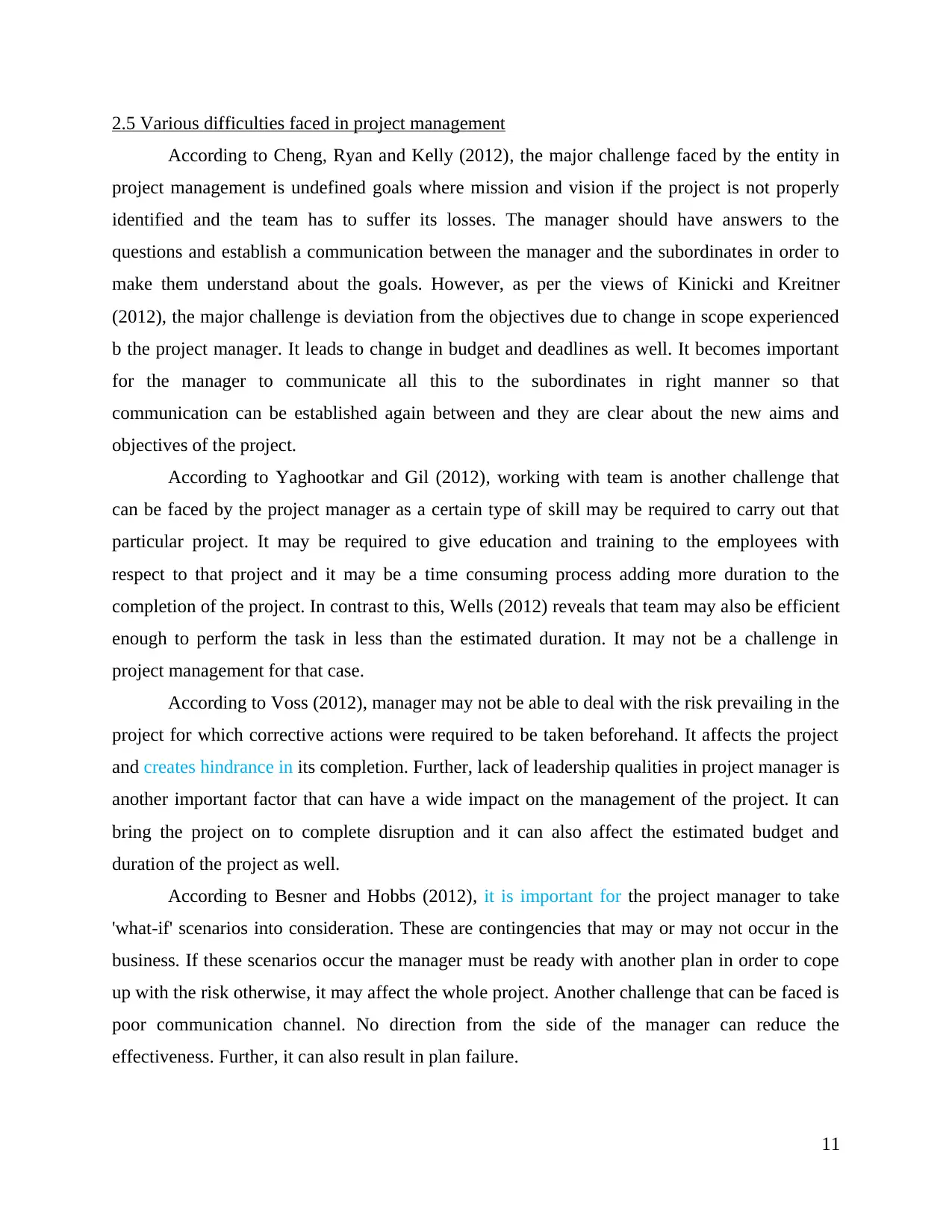
2.5 Various difficulties faced in project management
According to Cheng, Ryan and Kelly (2012), the major challenge faced by the entity in
project management is undefined goals where mission and vision if the project is not properly
identified and the team has to suffer its losses. The manager should have answers to the
questions and establish a communication between the manager and the subordinates in order to
make them understand about the goals. However, as per the views of Kinicki and Kreitner
(2012), the major challenge is deviation from the objectives due to change in scope experienced
b the project manager. It leads to change in budget and deadlines as well. It becomes important
for the manager to communicate all this to the subordinates in right manner so that
communication can be established again between and they are clear about the new aims and
objectives of the project.
According to Yaghootkar and Gil (2012), working with team is another challenge that
can be faced by the project manager as a certain type of skill may be required to carry out that
particular project. It may be required to give education and training to the employees with
respect to that project and it may be a time consuming process adding more duration to the
completion of the project. In contrast to this, Wells (2012) reveals that team may also be efficient
enough to perform the task in less than the estimated duration. It may not be a challenge in
project management for that case.
According to Voss (2012), manager may not be able to deal with the risk prevailing in the
project for which corrective actions were required to be taken beforehand. It affects the project
and creates hindrance in its completion. Further, lack of leadership qualities in project manager is
another important factor that can have a wide impact on the management of the project. It can
bring the project on to complete disruption and it can also affect the estimated budget and
duration of the project as well.
According to Besner and Hobbs (2012), it is important for the project manager to take
'what-if' scenarios into consideration. These are contingencies that may or may not occur in the
business. If these scenarios occur the manager must be ready with another plan in order to cope
up with the risk otherwise, it may affect the whole project. Another challenge that can be faced is
poor communication channel. No direction from the side of the manager can reduce the
effectiveness. Further, it can also result in plan failure.
11
According to Cheng, Ryan and Kelly (2012), the major challenge faced by the entity in
project management is undefined goals where mission and vision if the project is not properly
identified and the team has to suffer its losses. The manager should have answers to the
questions and establish a communication between the manager and the subordinates in order to
make them understand about the goals. However, as per the views of Kinicki and Kreitner
(2012), the major challenge is deviation from the objectives due to change in scope experienced
b the project manager. It leads to change in budget and deadlines as well. It becomes important
for the manager to communicate all this to the subordinates in right manner so that
communication can be established again between and they are clear about the new aims and
objectives of the project.
According to Yaghootkar and Gil (2012), working with team is another challenge that
can be faced by the project manager as a certain type of skill may be required to carry out that
particular project. It may be required to give education and training to the employees with
respect to that project and it may be a time consuming process adding more duration to the
completion of the project. In contrast to this, Wells (2012) reveals that team may also be efficient
enough to perform the task in less than the estimated duration. It may not be a challenge in
project management for that case.
According to Voss (2012), manager may not be able to deal with the risk prevailing in the
project for which corrective actions were required to be taken beforehand. It affects the project
and creates hindrance in its completion. Further, lack of leadership qualities in project manager is
another important factor that can have a wide impact on the management of the project. It can
bring the project on to complete disruption and it can also affect the estimated budget and
duration of the project as well.
According to Besner and Hobbs (2012), it is important for the project manager to take
'what-if' scenarios into consideration. These are contingencies that may or may not occur in the
business. If these scenarios occur the manager must be ready with another plan in order to cope
up with the risk otherwise, it may affect the whole project. Another challenge that can be faced is
poor communication channel. No direction from the side of the manager can reduce the
effectiveness. Further, it can also result in plan failure.
11

2.6 Different types of project management techniques
Through decades of though and practice by professional project managers several
sophisticated methods for managing project have been developed. The various types of project
management techniques are as follows:
Waterfall model
According to Müller, Zhain and Wang, (2017). This model comes under linear approach.
It handles the things in a sequential manner .There requirements of the project are determined in
the starting. This model is used for development of large scale software. The main drawback of
this model is that changes are not possible. This model can be used in project when the
requirements are well known, clear and fixed. The communication with customer is very less
during the development of product. Only it can be demoed to end users once the product is
ready.
Agile project management
This approach represents a version of project that is completed enough to potentially
implement. To evaluate the latest version of the project and make suggestions for improvement
team members attend “scrum” meeting. With the suggested changes the project developers then
develop a second version and present it as shown by Hensel and Mitchell, (2017) .This process is
repeated through four or more versions till the process of scrum has met all the requirements.
Six sigma
This method works well for projects that can be measured precisely. From the absolute
perfection it will look for any deviations and will address the cause of those deviations. To
achieve the results with little variation one has to define, measure, analyse, improve and control
the project throughout its development and implementation. For an instance a project to develop
a software system that identifies non-business uses of employees’ computers can benefit from
the six sigma approach. As stated by Ramanayaka and Sutrisna, (2017), each personal use of
business computer will be detected by absolute perfection. The system can be tested and refine
so that there are not more than 3.4 defect per million opportunities.
Critical chain
12
Through decades of though and practice by professional project managers several
sophisticated methods for managing project have been developed. The various types of project
management techniques are as follows:
Waterfall model
According to Müller, Zhain and Wang, (2017). This model comes under linear approach.
It handles the things in a sequential manner .There requirements of the project are determined in
the starting. This model is used for development of large scale software. The main drawback of
this model is that changes are not possible. This model can be used in project when the
requirements are well known, clear and fixed. The communication with customer is very less
during the development of product. Only it can be demoed to end users once the product is
ready.
Agile project management
This approach represents a version of project that is completed enough to potentially
implement. To evaluate the latest version of the project and make suggestions for improvement
team members attend “scrum” meeting. With the suggested changes the project developers then
develop a second version and present it as shown by Hensel and Mitchell, (2017) .This process is
repeated through four or more versions till the process of scrum has met all the requirements.
Six sigma
This method works well for projects that can be measured precisely. From the absolute
perfection it will look for any deviations and will address the cause of those deviations. To
achieve the results with little variation one has to define, measure, analyse, improve and control
the project throughout its development and implementation. For an instance a project to develop
a software system that identifies non-business uses of employees’ computers can benefit from
the six sigma approach. As stated by Ramanayaka and Sutrisna, (2017), each personal use of
business computer will be detected by absolute perfection. The system can be tested and refine
so that there are not more than 3.4 defect per million opportunities.
Critical chain
12
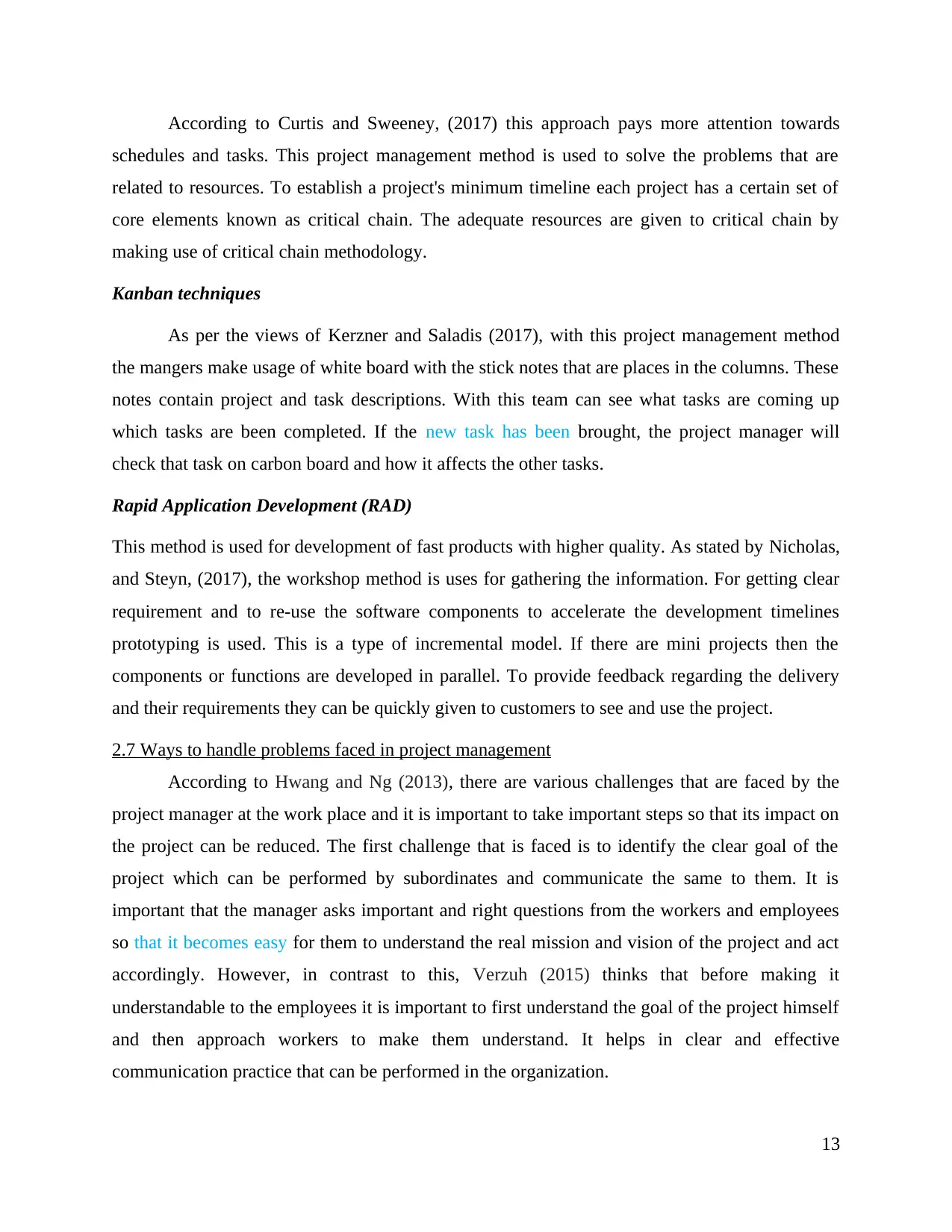
According to Curtis and Sweeney, (2017) this approach pays more attention towards
schedules and tasks. This project management method is used to solve the problems that are
related to resources. To establish a project's minimum timeline each project has a certain set of
core elements known as critical chain. The adequate resources are given to critical chain by
making use of critical chain methodology.
Kanban techniques
As per the views of Kerzner and Saladis (2017), with this project management method
the mangers make usage of white board with the stick notes that are places in the columns. These
notes contain project and task descriptions. With this team can see what tasks are coming up
which tasks are been completed. If the new task has been brought, the project manager will
check that task on carbon board and how it affects the other tasks.
Rapid Application Development (RAD)
This method is used for development of fast products with higher quality. As stated by Nicholas,
and Steyn, (2017), the workshop method is uses for gathering the information. For getting clear
requirement and to re-use the software components to accelerate the development timelines
prototyping is used. This is a type of incremental model. If there are mini projects then the
components or functions are developed in parallel. To provide feedback regarding the delivery
and their requirements they can be quickly given to customers to see and use the project.
2.7 Ways to handle problems faced in project management
According to Hwang and Ng (2013), there are various challenges that are faced by the
project manager at the work place and it is important to take important steps so that its impact on
the project can be reduced. The first challenge that is faced is to identify the clear goal of the
project which can be performed by subordinates and communicate the same to them. It is
important that the manager asks important and right questions from the workers and employees
so that it becomes easy for them to understand the real mission and vision of the project and act
accordingly. However, in contrast to this, Verzuh (2015) thinks that before making it
understandable to the employees it is important to first understand the goal of the project himself
and then approach workers to make them understand. It helps in clear and effective
communication practice that can be performed in the organization.
13
schedules and tasks. This project management method is used to solve the problems that are
related to resources. To establish a project's minimum timeline each project has a certain set of
core elements known as critical chain. The adequate resources are given to critical chain by
making use of critical chain methodology.
Kanban techniques
As per the views of Kerzner and Saladis (2017), with this project management method
the mangers make usage of white board with the stick notes that are places in the columns. These
notes contain project and task descriptions. With this team can see what tasks are coming up
which tasks are been completed. If the new task has been brought, the project manager will
check that task on carbon board and how it affects the other tasks.
Rapid Application Development (RAD)
This method is used for development of fast products with higher quality. As stated by Nicholas,
and Steyn, (2017), the workshop method is uses for gathering the information. For getting clear
requirement and to re-use the software components to accelerate the development timelines
prototyping is used. This is a type of incremental model. If there are mini projects then the
components or functions are developed in parallel. To provide feedback regarding the delivery
and their requirements they can be quickly given to customers to see and use the project.
2.7 Ways to handle problems faced in project management
According to Hwang and Ng (2013), there are various challenges that are faced by the
project manager at the work place and it is important to take important steps so that its impact on
the project can be reduced. The first challenge that is faced is to identify the clear goal of the
project which can be performed by subordinates and communicate the same to them. It is
important that the manager asks important and right questions from the workers and employees
so that it becomes easy for them to understand the real mission and vision of the project and act
accordingly. However, in contrast to this, Verzuh (2015) thinks that before making it
understandable to the employees it is important to first understand the goal of the project himself
and then approach workers to make them understand. It helps in clear and effective
communication practice that can be performed in the organization.
13
Paraphrase This Document
Need a fresh take? Get an instant paraphrase of this document with our AI Paraphraser
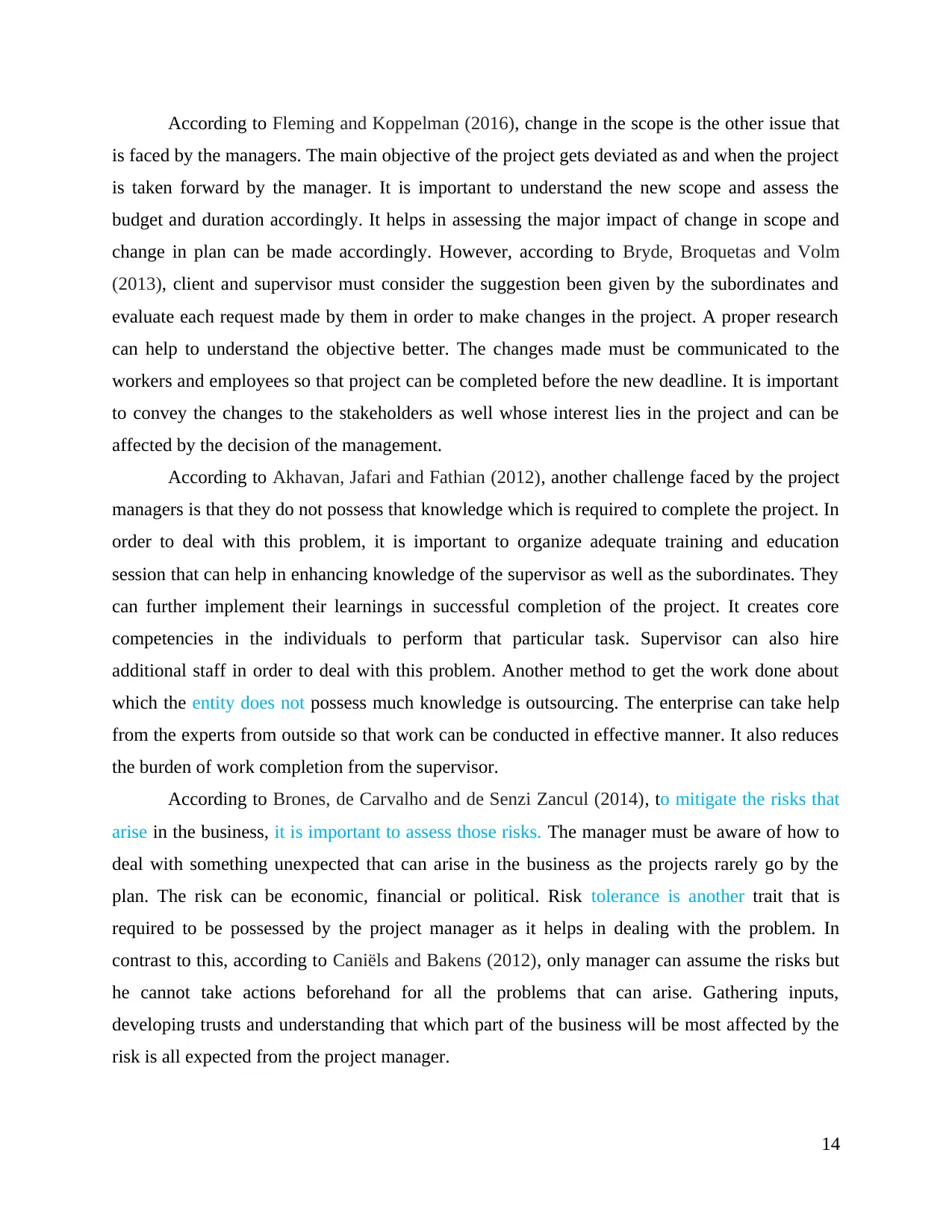
According to Fleming and Koppelman (2016), change in the scope is the other issue that
is faced by the managers. The main objective of the project gets deviated as and when the project
is taken forward by the manager. It is important to understand the new scope and assess the
budget and duration accordingly. It helps in assessing the major impact of change in scope and
change in plan can be made accordingly. However, according to Bryde, Broquetas and Volm
(2013), client and supervisor must consider the suggestion been given by the subordinates and
evaluate each request made by them in order to make changes in the project. A proper research
can help to understand the objective better. The changes made must be communicated to the
workers and employees so that project can be completed before the new deadline. It is important
to convey the changes to the stakeholders as well whose interest lies in the project and can be
affected by the decision of the management.
According to Akhavan, Jafari and Fathian (2012), another challenge faced by the project
managers is that they do not possess that knowledge which is required to complete the project. In
order to deal with this problem, it is important to organize adequate training and education
session that can help in enhancing knowledge of the supervisor as well as the subordinates. They
can further implement their learnings in successful completion of the project. It creates core
competencies in the individuals to perform that particular task. Supervisor can also hire
additional staff in order to deal with this problem. Another method to get the work done about
which the entity does not possess much knowledge is outsourcing. The enterprise can take help
from the experts from outside so that work can be conducted in effective manner. It also reduces
the burden of work completion from the supervisor.
According to Brones, de Carvalho and de Senzi Zancul (2014), to mitigate the risks that
arise in the business, it is important to assess those risks. The manager must be aware of how to
deal with something unexpected that can arise in the business as the projects rarely go by the
plan. The risk can be economic, financial or political. Risk tolerance is another trait that is
required to be possessed by the project manager as it helps in dealing with the problem. In
contrast to this, according to Caniëls and Bakens (2012), only manager can assume the risks but
he cannot take actions beforehand for all the problems that can arise. Gathering inputs,
developing trusts and understanding that which part of the business will be most affected by the
risk is all expected from the project manager.
14
is faced by the managers. The main objective of the project gets deviated as and when the project
is taken forward by the manager. It is important to understand the new scope and assess the
budget and duration accordingly. It helps in assessing the major impact of change in scope and
change in plan can be made accordingly. However, according to Bryde, Broquetas and Volm
(2013), client and supervisor must consider the suggestion been given by the subordinates and
evaluate each request made by them in order to make changes in the project. A proper research
can help to understand the objective better. The changes made must be communicated to the
workers and employees so that project can be completed before the new deadline. It is important
to convey the changes to the stakeholders as well whose interest lies in the project and can be
affected by the decision of the management.
According to Akhavan, Jafari and Fathian (2012), another challenge faced by the project
managers is that they do not possess that knowledge which is required to complete the project. In
order to deal with this problem, it is important to organize adequate training and education
session that can help in enhancing knowledge of the supervisor as well as the subordinates. They
can further implement their learnings in successful completion of the project. It creates core
competencies in the individuals to perform that particular task. Supervisor can also hire
additional staff in order to deal with this problem. Another method to get the work done about
which the entity does not possess much knowledge is outsourcing. The enterprise can take help
from the experts from outside so that work can be conducted in effective manner. It also reduces
the burden of work completion from the supervisor.
According to Brones, de Carvalho and de Senzi Zancul (2014), to mitigate the risks that
arise in the business, it is important to assess those risks. The manager must be aware of how to
deal with something unexpected that can arise in the business as the projects rarely go by the
plan. The risk can be economic, financial or political. Risk tolerance is another trait that is
required to be possessed by the project manager as it helps in dealing with the problem. In
contrast to this, according to Caniëls and Bakens (2012), only manager can assume the risks but
he cannot take actions beforehand for all the problems that can arise. Gathering inputs,
developing trusts and understanding that which part of the business will be most affected by the
risk is all expected from the project manager.
14

According to Walker (2015), poor communication is another factor that can affect the
functioning of the project. It is important for the managers to have a proper channel of
communication to be followed so that effective communication can be managed in the
organization. It is a crucial part to be performed in the entity for successful completion of the
project. The manager should emphasise on written and oral communication skills so that the
actual words can be transmitted and decoded. Effective communication can help in increasing
the morale of the employees by establishing clear expectations from the project. Good team leads
and project supervisors help in keeping proper flow of communication and feedback between top
management and team leaders.
According to Pemsel and Wiewiora (2013), it is important to have effective management
skills as it helps in developing quality in the project. Manager can also go through quality project
management problems in order to enhance these skills. It helps in conducting the project in such
a manner that the quality standards of the project essentials are not compromised. However, as
per the views of Angelsen and et.al. (2012), the manager should have set policies and procedures
that re relevant to maintain the quality benchmark for every project. It will help to provide the
project deliverables as per the requirements of the client.
According to Martinelli and Milosevic (2016), the bigger the project is the riskier it will
be. In order to manage larger and complex projects which are technically challenging it is
important to find the right experts who have adequate knowledge about the project as they will
be able to handle the project in better manner. The process of completion of the project may
require new technology, material, different type of design and techniques. Experts help in
optimum utilization of the resources and helps in reducing the cost to the minimum. However,
according to Alhawari and et.al. (2012), the project manager must possess appropriate leadership
skills so that it can manage the workers and employees working for that project. It is important
the team is led by an encouraging and inspiring team leader who can help in attaining the goals.
He must work as per the interest of the employees and can adopt different leadership tactics as
per the prevailing condition in the project management. Moreover, better decision making and
appropriate guidance to the subordinates can help in achieving the goals in the duration as
estimated by the manager in the beginning.
15
functioning of the project. It is important for the managers to have a proper channel of
communication to be followed so that effective communication can be managed in the
organization. It is a crucial part to be performed in the entity for successful completion of the
project. The manager should emphasise on written and oral communication skills so that the
actual words can be transmitted and decoded. Effective communication can help in increasing
the morale of the employees by establishing clear expectations from the project. Good team leads
and project supervisors help in keeping proper flow of communication and feedback between top
management and team leaders.
According to Pemsel and Wiewiora (2013), it is important to have effective management
skills as it helps in developing quality in the project. Manager can also go through quality project
management problems in order to enhance these skills. It helps in conducting the project in such
a manner that the quality standards of the project essentials are not compromised. However, as
per the views of Angelsen and et.al. (2012), the manager should have set policies and procedures
that re relevant to maintain the quality benchmark for every project. It will help to provide the
project deliverables as per the requirements of the client.
According to Martinelli and Milosevic (2016), the bigger the project is the riskier it will
be. In order to manage larger and complex projects which are technically challenging it is
important to find the right experts who have adequate knowledge about the project as they will
be able to handle the project in better manner. The process of completion of the project may
require new technology, material, different type of design and techniques. Experts help in
optimum utilization of the resources and helps in reducing the cost to the minimum. However,
according to Alhawari and et.al. (2012), the project manager must possess appropriate leadership
skills so that it can manage the workers and employees working for that project. It is important
the team is led by an encouraging and inspiring team leader who can help in attaining the goals.
He must work as per the interest of the employees and can adopt different leadership tactics as
per the prevailing condition in the project management. Moreover, better decision making and
appropriate guidance to the subordinates can help in achieving the goals in the duration as
estimated by the manager in the beginning.
15
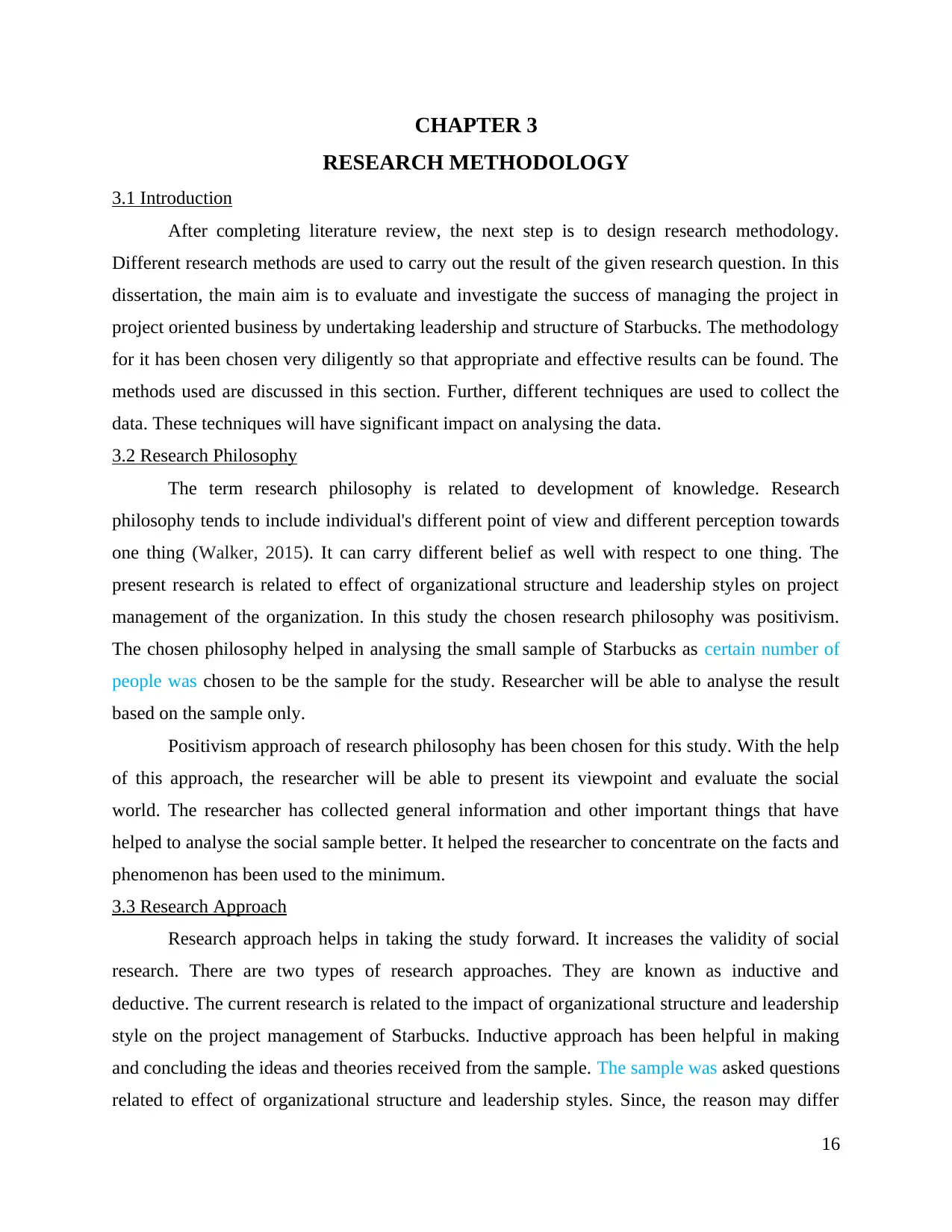
CHAPTER 3
RESEARCH METHODOLOGY
3.1 Introduction
After completing literature review, the next step is to design research methodology.
Different research methods are used to carry out the result of the given research question. In this
dissertation, the main aim is to evaluate and investigate the success of managing the project in
project oriented business by undertaking leadership and structure of Starbucks. The methodology
for it has been chosen very diligently so that appropriate and effective results can be found. The
methods used are discussed in this section. Further, different techniques are used to collect the
data. These techniques will have significant impact on analysing the data.
3.2 Research Philosophy
The term research philosophy is related to development of knowledge. Research
philosophy tends to include individual's different point of view and different perception towards
one thing (Walker, 2015). It can carry different belief as well with respect to one thing. The
present research is related to effect of organizational structure and leadership styles on project
management of the organization. In this study the chosen research philosophy was positivism.
The chosen philosophy helped in analysing the small sample of Starbucks as certain number of
people was chosen to be the sample for the study. Researcher will be able to analyse the result
based on the sample only.
Positivism approach of research philosophy has been chosen for this study. With the help
of this approach, the researcher will be able to present its viewpoint and evaluate the social
world. The researcher has collected general information and other important things that have
helped to analyse the social sample better. It helped the researcher to concentrate on the facts and
phenomenon has been used to the minimum.
3.3 Research Approach
Research approach helps in taking the study forward. It increases the validity of social
research. There are two types of research approaches. They are known as inductive and
deductive. The current research is related to the impact of organizational structure and leadership
style on the project management of Starbucks. Inductive approach has been helpful in making
and concluding the ideas and theories received from the sample. The sample was asked questions
related to effect of organizational structure and leadership styles. Since, the reason may differ
16
RESEARCH METHODOLOGY
3.1 Introduction
After completing literature review, the next step is to design research methodology.
Different research methods are used to carry out the result of the given research question. In this
dissertation, the main aim is to evaluate and investigate the success of managing the project in
project oriented business by undertaking leadership and structure of Starbucks. The methodology
for it has been chosen very diligently so that appropriate and effective results can be found. The
methods used are discussed in this section. Further, different techniques are used to collect the
data. These techniques will have significant impact on analysing the data.
3.2 Research Philosophy
The term research philosophy is related to development of knowledge. Research
philosophy tends to include individual's different point of view and different perception towards
one thing (Walker, 2015). It can carry different belief as well with respect to one thing. The
present research is related to effect of organizational structure and leadership styles on project
management of the organization. In this study the chosen research philosophy was positivism.
The chosen philosophy helped in analysing the small sample of Starbucks as certain number of
people was chosen to be the sample for the study. Researcher will be able to analyse the result
based on the sample only.
Positivism approach of research philosophy has been chosen for this study. With the help
of this approach, the researcher will be able to present its viewpoint and evaluate the social
world. The researcher has collected general information and other important things that have
helped to analyse the social sample better. It helped the researcher to concentrate on the facts and
phenomenon has been used to the minimum.
3.3 Research Approach
Research approach helps in taking the study forward. It increases the validity of social
research. There are two types of research approaches. They are known as inductive and
deductive. The current research is related to the impact of organizational structure and leadership
style on the project management of Starbucks. Inductive approach has been helpful in making
and concluding the ideas and theories received from the sample. The sample was asked questions
related to effect of organizational structure and leadership styles. Since, the reason may differ
16
Secure Best Marks with AI Grader
Need help grading? Try our AI Grader for instant feedback on your assignments.
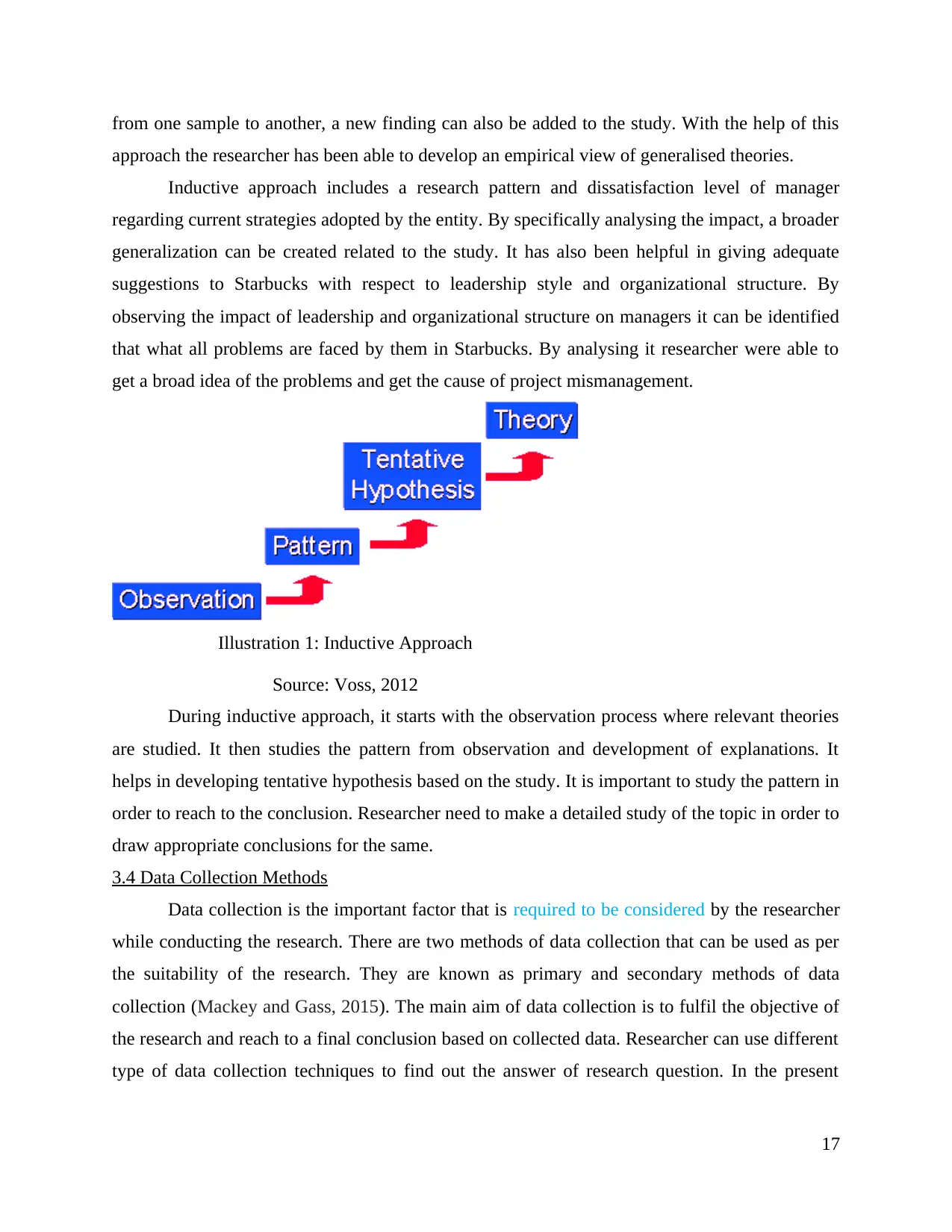
from one sample to another, a new finding can also be added to the study. With the help of this
approach the researcher has been able to develop an empirical view of generalised theories.
Inductive approach includes a research pattern and dissatisfaction level of manager
regarding current strategies adopted by the entity. By specifically analysing the impact, a broader
generalization can be created related to the study. It has also been helpful in giving adequate
suggestions to Starbucks with respect to leadership style and organizational structure. By
observing the impact of leadership and organizational structure on managers it can be identified
that what all problems are faced by them in Starbucks. By analysing it researcher were able to
get a broad idea of the problems and get the cause of project mismanagement.
Illustration 1: Inductive Approach
Source: Voss, 2012
During inductive approach, it starts with the observation process where relevant theories
are studied. It then studies the pattern from observation and development of explanations. It
helps in developing tentative hypothesis based on the study. It is important to study the pattern in
order to reach to the conclusion. Researcher need to make a detailed study of the topic in order to
draw appropriate conclusions for the same.
3.4 Data Collection Methods
Data collection is the important factor that is required to be considered by the researcher
while conducting the research. There are two methods of data collection that can be used as per
the suitability of the research. They are known as primary and secondary methods of data
collection (Mackey and Gass, 2015). The main aim of data collection is to fulfil the objective of
the research and reach to a final conclusion based on collected data. Researcher can use different
type of data collection techniques to find out the answer of research question. In the present
17
approach the researcher has been able to develop an empirical view of generalised theories.
Inductive approach includes a research pattern and dissatisfaction level of manager
regarding current strategies adopted by the entity. By specifically analysing the impact, a broader
generalization can be created related to the study. It has also been helpful in giving adequate
suggestions to Starbucks with respect to leadership style and organizational structure. By
observing the impact of leadership and organizational structure on managers it can be identified
that what all problems are faced by them in Starbucks. By analysing it researcher were able to
get a broad idea of the problems and get the cause of project mismanagement.
Illustration 1: Inductive Approach
Source: Voss, 2012
During inductive approach, it starts with the observation process where relevant theories
are studied. It then studies the pattern from observation and development of explanations. It
helps in developing tentative hypothesis based on the study. It is important to study the pattern in
order to reach to the conclusion. Researcher need to make a detailed study of the topic in order to
draw appropriate conclusions for the same.
3.4 Data Collection Methods
Data collection is the important factor that is required to be considered by the researcher
while conducting the research. There are two methods of data collection that can be used as per
the suitability of the research. They are known as primary and secondary methods of data
collection (Mackey and Gass, 2015). The main aim of data collection is to fulfil the objective of
the research and reach to a final conclusion based on collected data. Researcher can use different
type of data collection techniques to find out the answer of research question. In the present
17
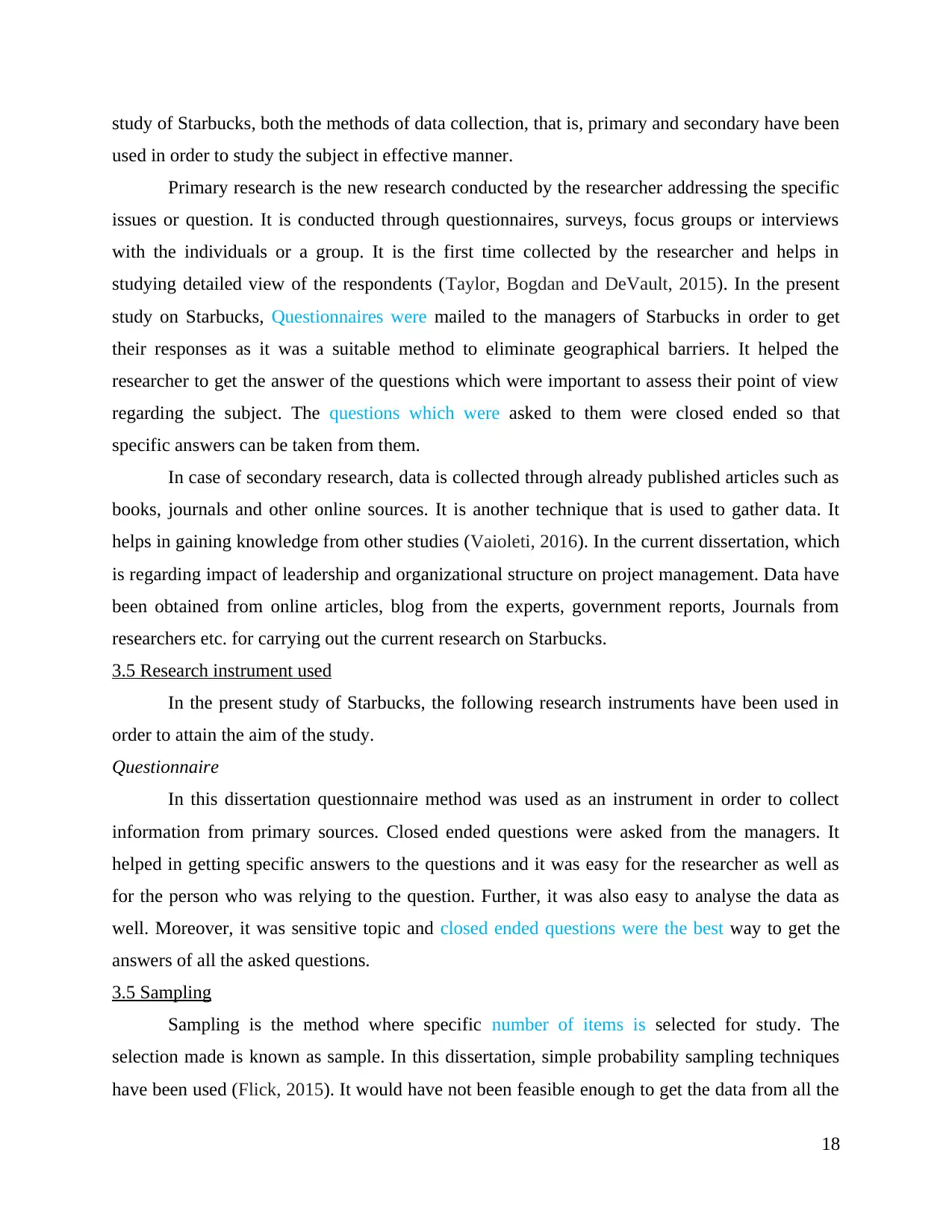
study of Starbucks, both the methods of data collection, that is, primary and secondary have been
used in order to study the subject in effective manner.
Primary research is the new research conducted by the researcher addressing the specific
issues or question. It is conducted through questionnaires, surveys, focus groups or interviews
with the individuals or a group. It is the first time collected by the researcher and helps in
studying detailed view of the respondents (Taylor, Bogdan and DeVault, 2015). In the present
study on Starbucks, Questionnaires were mailed to the managers of Starbucks in order to get
their responses as it was a suitable method to eliminate geographical barriers. It helped the
researcher to get the answer of the questions which were important to assess their point of view
regarding the subject. The questions which were asked to them were closed ended so that
specific answers can be taken from them.
In case of secondary research, data is collected through already published articles such as
books, journals and other online sources. It is another technique that is used to gather data. It
helps in gaining knowledge from other studies (Vaioleti, 2016). In the current dissertation, which
is regarding impact of leadership and organizational structure on project management. Data have
been obtained from online articles, blog from the experts, government reports, Journals from
researchers etc. for carrying out the current research on Starbucks.
3.5 Research instrument used
In the present study of Starbucks, the following research instruments have been used in
order to attain the aim of the study.
Questionnaire
In this dissertation questionnaire method was used as an instrument in order to collect
information from primary sources. Closed ended questions were asked from the managers. It
helped in getting specific answers to the questions and it was easy for the researcher as well as
for the person who was relying to the question. Further, it was also easy to analyse the data as
well. Moreover, it was sensitive topic and closed ended questions were the best way to get the
answers of all the asked questions.
3.5 Sampling
Sampling is the method where specific number of items is selected for study. The
selection made is known as sample. In this dissertation, simple probability sampling techniques
have been used (Flick, 2015). It would have not been feasible enough to get the data from all the
18
used in order to study the subject in effective manner.
Primary research is the new research conducted by the researcher addressing the specific
issues or question. It is conducted through questionnaires, surveys, focus groups or interviews
with the individuals or a group. It is the first time collected by the researcher and helps in
studying detailed view of the respondents (Taylor, Bogdan and DeVault, 2015). In the present
study on Starbucks, Questionnaires were mailed to the managers of Starbucks in order to get
their responses as it was a suitable method to eliminate geographical barriers. It helped the
researcher to get the answer of the questions which were important to assess their point of view
regarding the subject. The questions which were asked to them were closed ended so that
specific answers can be taken from them.
In case of secondary research, data is collected through already published articles such as
books, journals and other online sources. It is another technique that is used to gather data. It
helps in gaining knowledge from other studies (Vaioleti, 2016). In the current dissertation, which
is regarding impact of leadership and organizational structure on project management. Data have
been obtained from online articles, blog from the experts, government reports, Journals from
researchers etc. for carrying out the current research on Starbucks.
3.5 Research instrument used
In the present study of Starbucks, the following research instruments have been used in
order to attain the aim of the study.
Questionnaire
In this dissertation questionnaire method was used as an instrument in order to collect
information from primary sources. Closed ended questions were asked from the managers. It
helped in getting specific answers to the questions and it was easy for the researcher as well as
for the person who was relying to the question. Further, it was also easy to analyse the data as
well. Moreover, it was sensitive topic and closed ended questions were the best way to get the
answers of all the asked questions.
3.5 Sampling
Sampling is the method where specific number of items is selected for study. The
selection made is known as sample. In this dissertation, simple probability sampling techniques
have been used (Flick, 2015). It would have not been feasible enough to get the data from all the
18
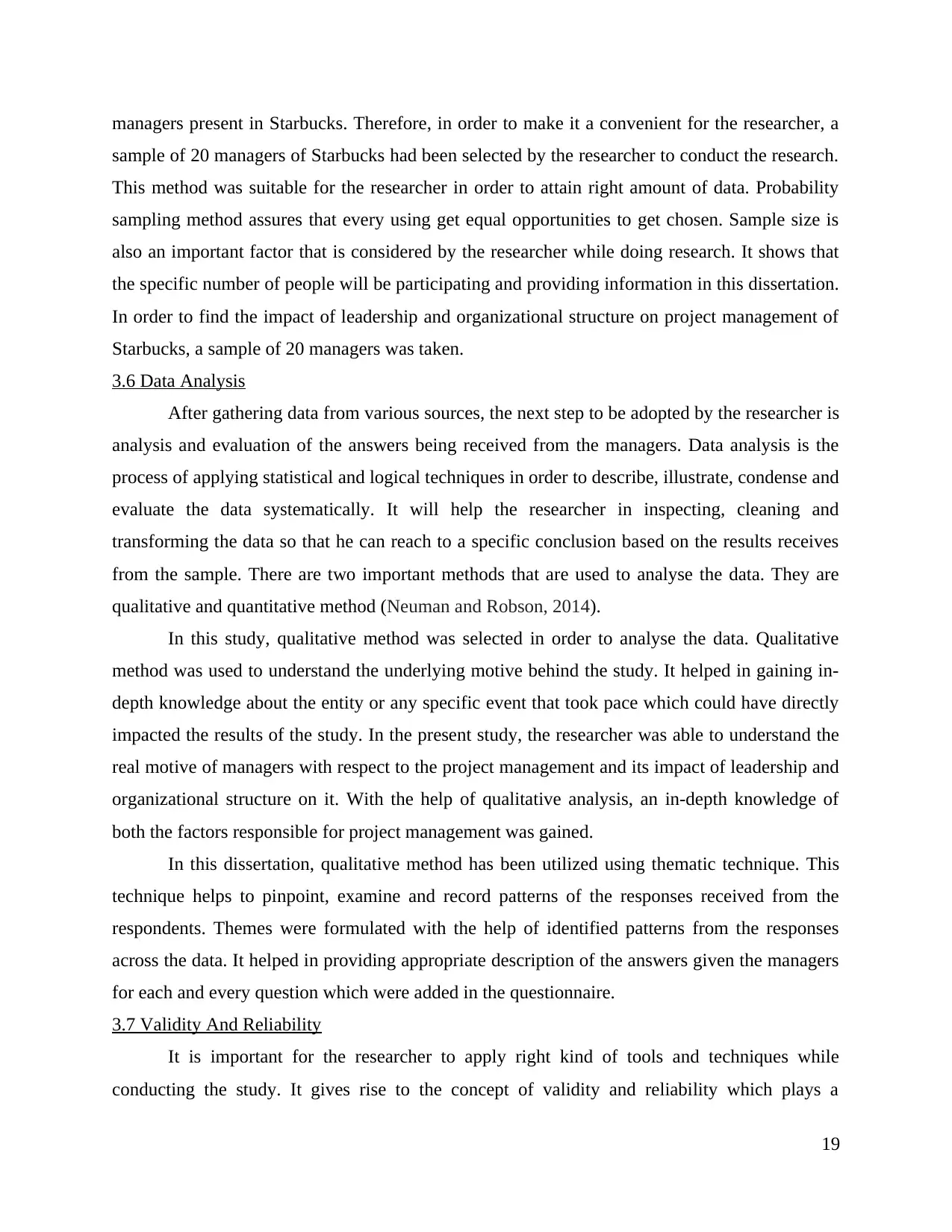
managers present in Starbucks. Therefore, in order to make it a convenient for the researcher, a
sample of 20 managers of Starbucks had been selected by the researcher to conduct the research.
This method was suitable for the researcher in order to attain right amount of data. Probability
sampling method assures that every using get equal opportunities to get chosen. Sample size is
also an important factor that is considered by the researcher while doing research. It shows that
the specific number of people will be participating and providing information in this dissertation.
In order to find the impact of leadership and organizational structure on project management of
Starbucks, a sample of 20 managers was taken.
3.6 Data Analysis
After gathering data from various sources, the next step to be adopted by the researcher is
analysis and evaluation of the answers being received from the managers. Data analysis is the
process of applying statistical and logical techniques in order to describe, illustrate, condense and
evaluate the data systematically. It will help the researcher in inspecting, cleaning and
transforming the data so that he can reach to a specific conclusion based on the results receives
from the sample. There are two important methods that are used to analyse the data. They are
qualitative and quantitative method (Neuman and Robson, 2014).
In this study, qualitative method was selected in order to analyse the data. Qualitative
method was used to understand the underlying motive behind the study. It helped in gaining in-
depth knowledge about the entity or any specific event that took pace which could have directly
impacted the results of the study. In the present study, the researcher was able to understand the
real motive of managers with respect to the project management and its impact of leadership and
organizational structure on it. With the help of qualitative analysis, an in-depth knowledge of
both the factors responsible for project management was gained.
In this dissertation, qualitative method has been utilized using thematic technique. This
technique helps to pinpoint, examine and record patterns of the responses received from the
respondents. Themes were formulated with the help of identified patterns from the responses
across the data. It helped in providing appropriate description of the answers given the managers
for each and every question which were added in the questionnaire.
3.7 Validity And Reliability
It is important for the researcher to apply right kind of tools and techniques while
conducting the study. It gives rise to the concept of validity and reliability which plays a
19
sample of 20 managers of Starbucks had been selected by the researcher to conduct the research.
This method was suitable for the researcher in order to attain right amount of data. Probability
sampling method assures that every using get equal opportunities to get chosen. Sample size is
also an important factor that is considered by the researcher while doing research. It shows that
the specific number of people will be participating and providing information in this dissertation.
In order to find the impact of leadership and organizational structure on project management of
Starbucks, a sample of 20 managers was taken.
3.6 Data Analysis
After gathering data from various sources, the next step to be adopted by the researcher is
analysis and evaluation of the answers being received from the managers. Data analysis is the
process of applying statistical and logical techniques in order to describe, illustrate, condense and
evaluate the data systematically. It will help the researcher in inspecting, cleaning and
transforming the data so that he can reach to a specific conclusion based on the results receives
from the sample. There are two important methods that are used to analyse the data. They are
qualitative and quantitative method (Neuman and Robson, 2014).
In this study, qualitative method was selected in order to analyse the data. Qualitative
method was used to understand the underlying motive behind the study. It helped in gaining in-
depth knowledge about the entity or any specific event that took pace which could have directly
impacted the results of the study. In the present study, the researcher was able to understand the
real motive of managers with respect to the project management and its impact of leadership and
organizational structure on it. With the help of qualitative analysis, an in-depth knowledge of
both the factors responsible for project management was gained.
In this dissertation, qualitative method has been utilized using thematic technique. This
technique helps to pinpoint, examine and record patterns of the responses received from the
respondents. Themes were formulated with the help of identified patterns from the responses
across the data. It helped in providing appropriate description of the answers given the managers
for each and every question which were added in the questionnaire.
3.7 Validity And Reliability
It is important for the researcher to apply right kind of tools and techniques while
conducting the study. It gives rise to the concept of validity and reliability which plays a
19
Paraphrase This Document
Need a fresh take? Get an instant paraphrase of this document with our AI Paraphraser
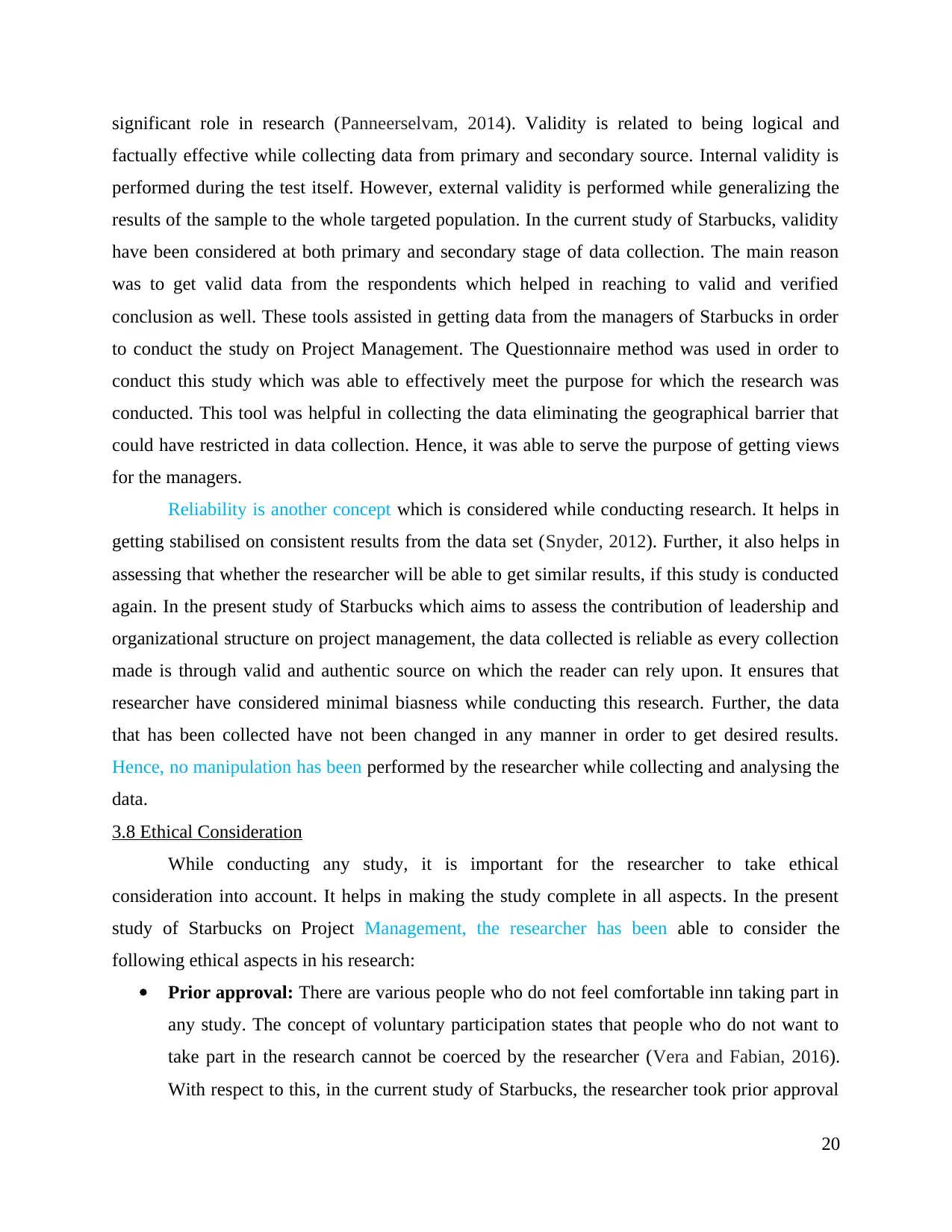
significant role in research (Panneerselvam, 2014). Validity is related to being logical and
factually effective while collecting data from primary and secondary source. Internal validity is
performed during the test itself. However, external validity is performed while generalizing the
results of the sample to the whole targeted population. In the current study of Starbucks, validity
have been considered at both primary and secondary stage of data collection. The main reason
was to get valid data from the respondents which helped in reaching to valid and verified
conclusion as well. These tools assisted in getting data from the managers of Starbucks in order
to conduct the study on Project Management. The Questionnaire method was used in order to
conduct this study which was able to effectively meet the purpose for which the research was
conducted. This tool was helpful in collecting the data eliminating the geographical barrier that
could have restricted in data collection. Hence, it was able to serve the purpose of getting views
for the managers.
Reliability is another concept which is considered while conducting research. It helps in
getting stabilised on consistent results from the data set (Snyder, 2012). Further, it also helps in
assessing that whether the researcher will be able to get similar results, if this study is conducted
again. In the present study of Starbucks which aims to assess the contribution of leadership and
organizational structure on project management, the data collected is reliable as every collection
made is through valid and authentic source on which the reader can rely upon. It ensures that
researcher have considered minimal biasness while conducting this research. Further, the data
that has been collected have not been changed in any manner in order to get desired results.
Hence, no manipulation has been performed by the researcher while collecting and analysing the
data.
3.8 Ethical Consideration
While conducting any study, it is important for the researcher to take ethical
consideration into account. It helps in making the study complete in all aspects. In the present
study of Starbucks on Project Management, the researcher has been able to consider the
following ethical aspects in his research:
Prior approval: There are various people who do not feel comfortable inn taking part in
any study. The concept of voluntary participation states that people who do not want to
take part in the research cannot be coerced by the researcher (Vera and Fabian, 2016).
With respect to this, in the current study of Starbucks, the researcher took prior approval
20
factually effective while collecting data from primary and secondary source. Internal validity is
performed during the test itself. However, external validity is performed while generalizing the
results of the sample to the whole targeted population. In the current study of Starbucks, validity
have been considered at both primary and secondary stage of data collection. The main reason
was to get valid data from the respondents which helped in reaching to valid and verified
conclusion as well. These tools assisted in getting data from the managers of Starbucks in order
to conduct the study on Project Management. The Questionnaire method was used in order to
conduct this study which was able to effectively meet the purpose for which the research was
conducted. This tool was helpful in collecting the data eliminating the geographical barrier that
could have restricted in data collection. Hence, it was able to serve the purpose of getting views
for the managers.
Reliability is another concept which is considered while conducting research. It helps in
getting stabilised on consistent results from the data set (Snyder, 2012). Further, it also helps in
assessing that whether the researcher will be able to get similar results, if this study is conducted
again. In the present study of Starbucks which aims to assess the contribution of leadership and
organizational structure on project management, the data collected is reliable as every collection
made is through valid and authentic source on which the reader can rely upon. It ensures that
researcher have considered minimal biasness while conducting this research. Further, the data
that has been collected have not been changed in any manner in order to get desired results.
Hence, no manipulation has been performed by the researcher while collecting and analysing the
data.
3.8 Ethical Consideration
While conducting any study, it is important for the researcher to take ethical
consideration into account. It helps in making the study complete in all aspects. In the present
study of Starbucks on Project Management, the researcher has been able to consider the
following ethical aspects in his research:
Prior approval: There are various people who do not feel comfortable inn taking part in
any study. The concept of voluntary participation states that people who do not want to
take part in the research cannot be coerced by the researcher (Vera and Fabian, 2016).
With respect to this, in the current study of Starbucks, the researcher took prior approval
20

from the managers from whom he wanted to collect data who were working in Starbucks.
The data has not been collected forcefully by any of the managers. The purpose of the
study was also explained to the sample of the present study. Moreover, they were also
informed about the method of research and procedures involved in the study.
Confidentiality: The research of the present study ensured that the identity of the
participants will not be revealed to anybody. By following anonymity principle, it was
assured that the participants of the sample remain anonymous and no personal
information of people is shared with anybody (Roberts, 2013). A greater degree of
privacy was assured while collecting the data from the managers. The information
provided by them was not shared with anybody and was utilised purely for the purpose of
data analysis and finding out the results of the research question.
Restricted Access: In the present study of Starbucks, various secondary sources were
used to collect the data. It included study on similar topics that were conducted by other
researchers which can be accessed from various sites. Many of them are not open for all
and cannot be accessed without the permission of the researcher. Hence, prior permission
was taken from the researcher in order to use this site and was accessed only when it was
granted.
Citing the work: It is an important activity which needs to be conducted by the
researcher. There are various studies that have already been conducted by different
people. Hence, in order to take ethical consideration into account, it important to properly
cite work if any of the data have been used. In the present study, the researcher has cited
the work of various researcher who have already conducted research on similar topic.
Proper citation of this work has been considered. No content have been exactly copy
pasted rather rephrasing activity have been taken into account and researcher have written
it in his own words. It helped to save itself from plagiarism law prevailing in the country.
3.9 Research Limitations
The whole process of conducting research is a challenging task and there are various
problems that are present in front of the researcher. Hence, there are various limitations that a
researcher face while conducting the study. In the present study of Starbucks, the under
mentioned limitations are faced by the researcher:
21
The data has not been collected forcefully by any of the managers. The purpose of the
study was also explained to the sample of the present study. Moreover, they were also
informed about the method of research and procedures involved in the study.
Confidentiality: The research of the present study ensured that the identity of the
participants will not be revealed to anybody. By following anonymity principle, it was
assured that the participants of the sample remain anonymous and no personal
information of people is shared with anybody (Roberts, 2013). A greater degree of
privacy was assured while collecting the data from the managers. The information
provided by them was not shared with anybody and was utilised purely for the purpose of
data analysis and finding out the results of the research question.
Restricted Access: In the present study of Starbucks, various secondary sources were
used to collect the data. It included study on similar topics that were conducted by other
researchers which can be accessed from various sites. Many of them are not open for all
and cannot be accessed without the permission of the researcher. Hence, prior permission
was taken from the researcher in order to use this site and was accessed only when it was
granted.
Citing the work: It is an important activity which needs to be conducted by the
researcher. There are various studies that have already been conducted by different
people. Hence, in order to take ethical consideration into account, it important to properly
cite work if any of the data have been used. In the present study, the researcher has cited
the work of various researcher who have already conducted research on similar topic.
Proper citation of this work has been considered. No content have been exactly copy
pasted rather rephrasing activity have been taken into account and researcher have written
it in his own words. It helped to save itself from plagiarism law prevailing in the country.
3.9 Research Limitations
The whole process of conducting research is a challenging task and there are various
problems that are present in front of the researcher. Hence, there are various limitations that a
researcher face while conducting the study. In the present study of Starbucks, the under
mentioned limitations are faced by the researcher:
21
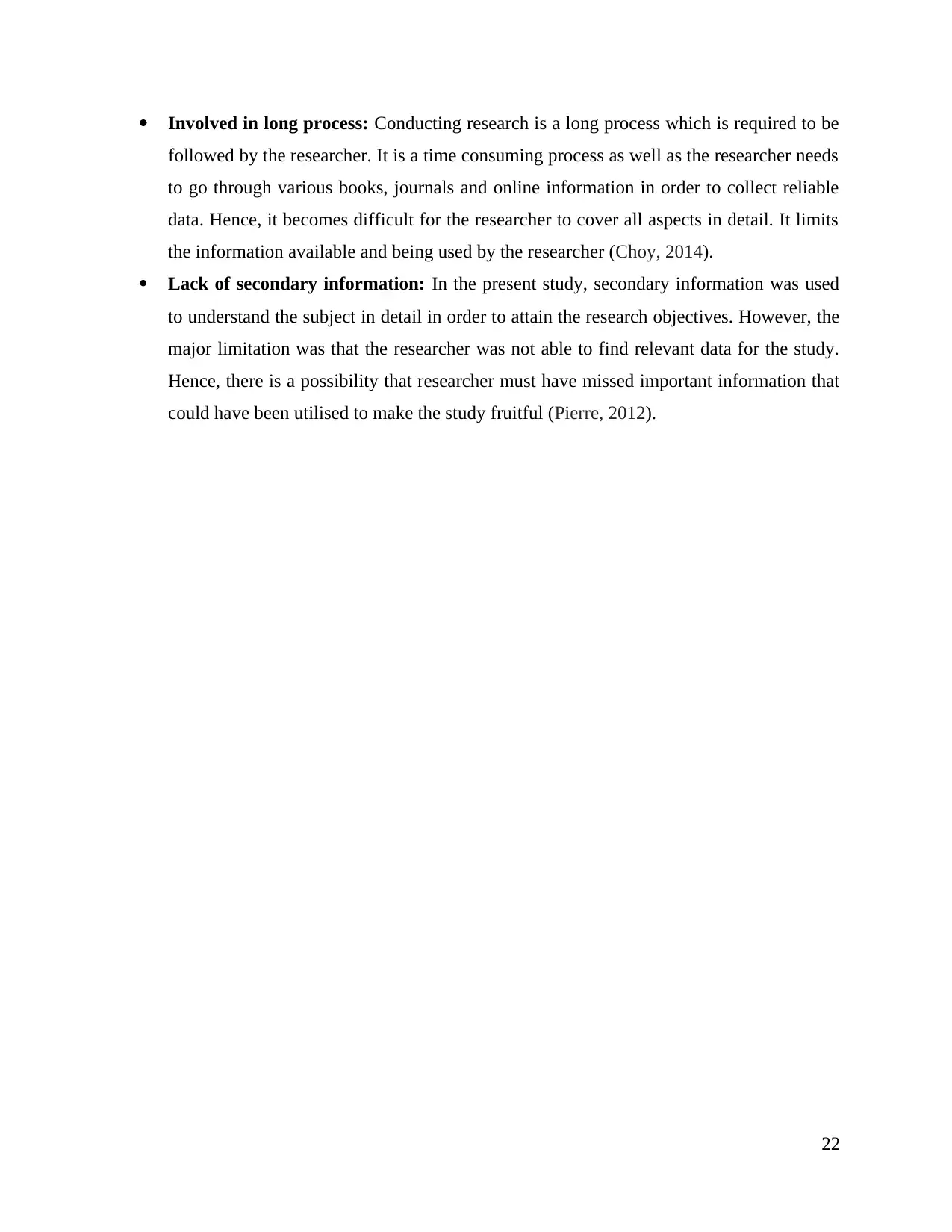
Involved in long process: Conducting research is a long process which is required to be
followed by the researcher. It is a time consuming process as well as the researcher needs
to go through various books, journals and online information in order to collect reliable
data. Hence, it becomes difficult for the researcher to cover all aspects in detail. It limits
the information available and being used by the researcher (Choy, 2014).
Lack of secondary information: In the present study, secondary information was used
to understand the subject in detail in order to attain the research objectives. However, the
major limitation was that the researcher was not able to find relevant data for the study.
Hence, there is a possibility that researcher must have missed important information that
could have been utilised to make the study fruitful (Pierre, 2012).
22
followed by the researcher. It is a time consuming process as well as the researcher needs
to go through various books, journals and online information in order to collect reliable
data. Hence, it becomes difficult for the researcher to cover all aspects in detail. It limits
the information available and being used by the researcher (Choy, 2014).
Lack of secondary information: In the present study, secondary information was used
to understand the subject in detail in order to attain the research objectives. However, the
major limitation was that the researcher was not able to find relevant data for the study.
Hence, there is a possibility that researcher must have missed important information that
could have been utilised to make the study fruitful (Pierre, 2012).
22
Secure Best Marks with AI Grader
Need help grading? Try our AI Grader for instant feedback on your assignments.
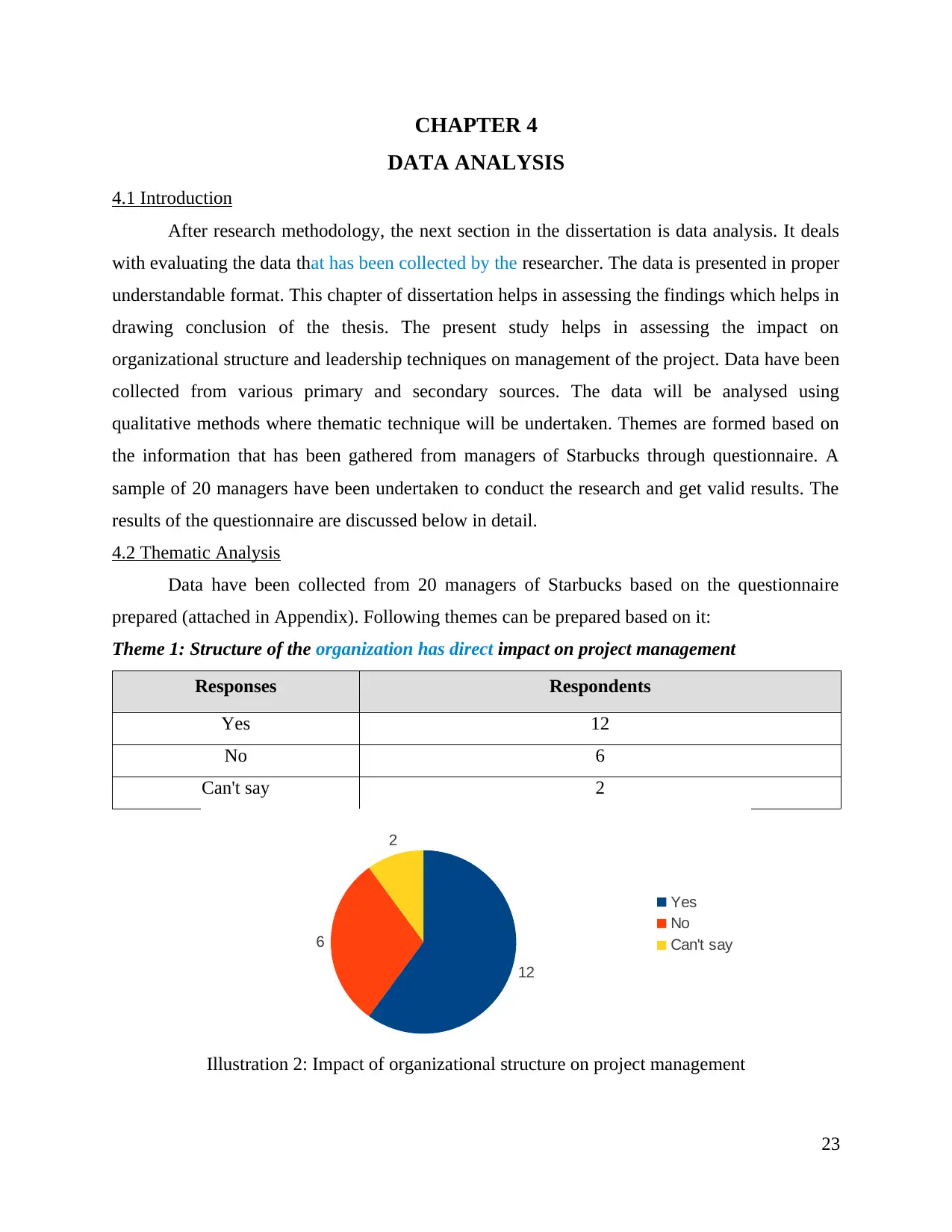
CHAPTER 4
DATA ANALYSIS
4.1 Introduction
After research methodology, the next section in the dissertation is data analysis. It deals
with evaluating the data that has been collected by the researcher. The data is presented in proper
understandable format. This chapter of dissertation helps in assessing the findings which helps in
drawing conclusion of the thesis. The present study helps in assessing the impact on
organizational structure and leadership techniques on management of the project. Data have been
collected from various primary and secondary sources. The data will be analysed using
qualitative methods where thematic technique will be undertaken. Themes are formed based on
the information that has been gathered from managers of Starbucks through questionnaire. A
sample of 20 managers have been undertaken to conduct the research and get valid results. The
results of the questionnaire are discussed below in detail.
4.2 Thematic Analysis
Data have been collected from 20 managers of Starbucks based on the questionnaire
prepared (attached in Appendix). Following themes can be prepared based on it:
Theme 1: Structure of the organization has direct impact on project management
Responses Respondents
Yes 12
No 6
Can't say 2
23
12
6
2
Yes
No
Can't say
Illustration 2: Impact of organizational structure on project management
DATA ANALYSIS
4.1 Introduction
After research methodology, the next section in the dissertation is data analysis. It deals
with evaluating the data that has been collected by the researcher. The data is presented in proper
understandable format. This chapter of dissertation helps in assessing the findings which helps in
drawing conclusion of the thesis. The present study helps in assessing the impact on
organizational structure and leadership techniques on management of the project. Data have been
collected from various primary and secondary sources. The data will be analysed using
qualitative methods where thematic technique will be undertaken. Themes are formed based on
the information that has been gathered from managers of Starbucks through questionnaire. A
sample of 20 managers have been undertaken to conduct the research and get valid results. The
results of the questionnaire are discussed below in detail.
4.2 Thematic Analysis
Data have been collected from 20 managers of Starbucks based on the questionnaire
prepared (attached in Appendix). Following themes can be prepared based on it:
Theme 1: Structure of the organization has direct impact on project management
Responses Respondents
Yes 12
No 6
Can't say 2
23
12
6
2
Yes
No
Can't say
Illustration 2: Impact of organizational structure on project management

Findings and interpretation: From the above responses, it can be interpreted that
organizational structure that has been adopted by the company plays an important role in
management of the project. Out of 20 managers, 12 think that it is essential that the entity adopt
for effective organizational structure otherwise it may result to project failure. However, 6
managers of them do not think so and states that there is no important role played by the type of
organizational structure adopted by the entity. In the end, only 2 of the 20 managers have no idea
about the adoption of organizational and didn't share any of the views about it. Hence, it can be
concluded that there is a significant impact of organizational structure adopted by the
organizational and it should be chosen wisely by the top managers of the enterprise.
Theme 2: Firms must analyse the structure before carrying out any project
Responses Respondents
Strongly agree 8
Agree 7
Neutral 1
Disagree 3
Strongly Disagree 1
Findings and interpretation: From the above graph, it can be concluded that before carrying out
any project it is important for the managers to decide that what kind of organizational structure is
24
8
7
1
3
1
Strongly agree
Agree
Neutral
Disagree
Strongly Disagree
Illustration 3: Analysis is important before any project
organizational structure that has been adopted by the company plays an important role in
management of the project. Out of 20 managers, 12 think that it is essential that the entity adopt
for effective organizational structure otherwise it may result to project failure. However, 6
managers of them do not think so and states that there is no important role played by the type of
organizational structure adopted by the entity. In the end, only 2 of the 20 managers have no idea
about the adoption of organizational and didn't share any of the views about it. Hence, it can be
concluded that there is a significant impact of organizational structure adopted by the
organizational and it should be chosen wisely by the top managers of the enterprise.
Theme 2: Firms must analyse the structure before carrying out any project
Responses Respondents
Strongly agree 8
Agree 7
Neutral 1
Disagree 3
Strongly Disagree 1
Findings and interpretation: From the above graph, it can be concluded that before carrying out
any project it is important for the managers to decide that what kind of organizational structure is
24
8
7
1
3
1
Strongly agree
Agree
Neutral
Disagree
Strongly Disagree
Illustration 3: Analysis is important before any project
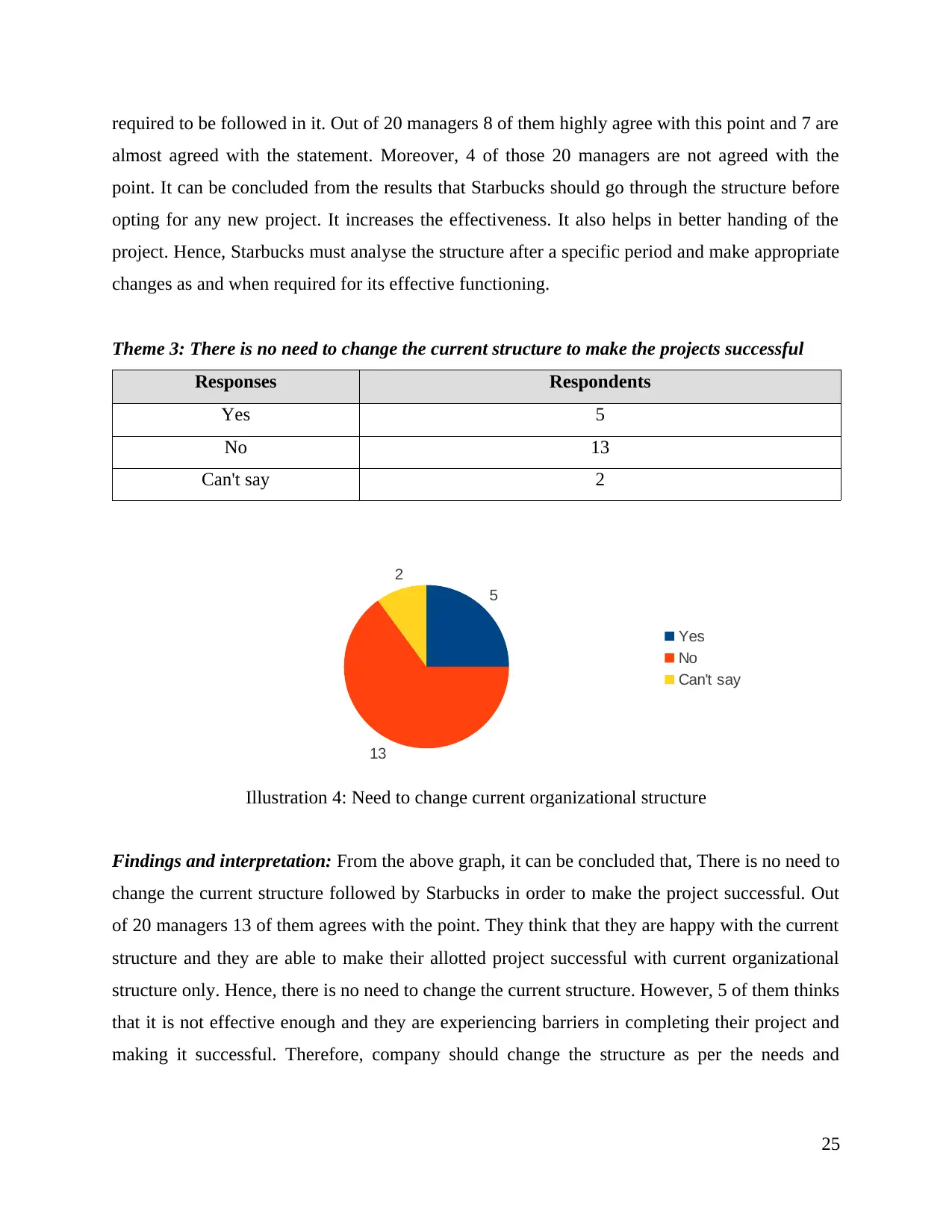
required to be followed in it. Out of 20 managers 8 of them highly agree with this point and 7 are
almost agreed with the statement. Moreover, 4 of those 20 managers are not agreed with the
point. It can be concluded from the results that Starbucks should go through the structure before
opting for any new project. It increases the effectiveness. It also helps in better handing of the
project. Hence, Starbucks must analyse the structure after a specific period and make appropriate
changes as and when required for its effective functioning.
Theme 3: There is no need to change the current structure to make the projects successful
Responses Respondents
Yes 5
No 13
Can't say 2
Findings and interpretation: From the above graph, it can be concluded that, There is no need to
change the current structure followed by Starbucks in order to make the project successful. Out
of 20 managers 13 of them agrees with the point. They think that they are happy with the current
structure and they are able to make their allotted project successful with current organizational
structure only. Hence, there is no need to change the current structure. However, 5 of them thinks
that it is not effective enough and they are experiencing barriers in completing their project and
making it successful. Therefore, company should change the structure as per the needs and
25
5
13
2
Yes
No
Can't say
Illustration 4: Need to change current organizational structure
almost agreed with the statement. Moreover, 4 of those 20 managers are not agreed with the
point. It can be concluded from the results that Starbucks should go through the structure before
opting for any new project. It increases the effectiveness. It also helps in better handing of the
project. Hence, Starbucks must analyse the structure after a specific period and make appropriate
changes as and when required for its effective functioning.
Theme 3: There is no need to change the current structure to make the projects successful
Responses Respondents
Yes 5
No 13
Can't say 2
Findings and interpretation: From the above graph, it can be concluded that, There is no need to
change the current structure followed by Starbucks in order to make the project successful. Out
of 20 managers 13 of them agrees with the point. They think that they are happy with the current
structure and they are able to make their allotted project successful with current organizational
structure only. Hence, there is no need to change the current structure. However, 5 of them thinks
that it is not effective enough and they are experiencing barriers in completing their project and
making it successful. Therefore, company should change the structure as per the needs and
25
5
13
2
Yes
No
Can't say
Illustration 4: Need to change current organizational structure
Paraphrase This Document
Need a fresh take? Get an instant paraphrase of this document with our AI Paraphraser
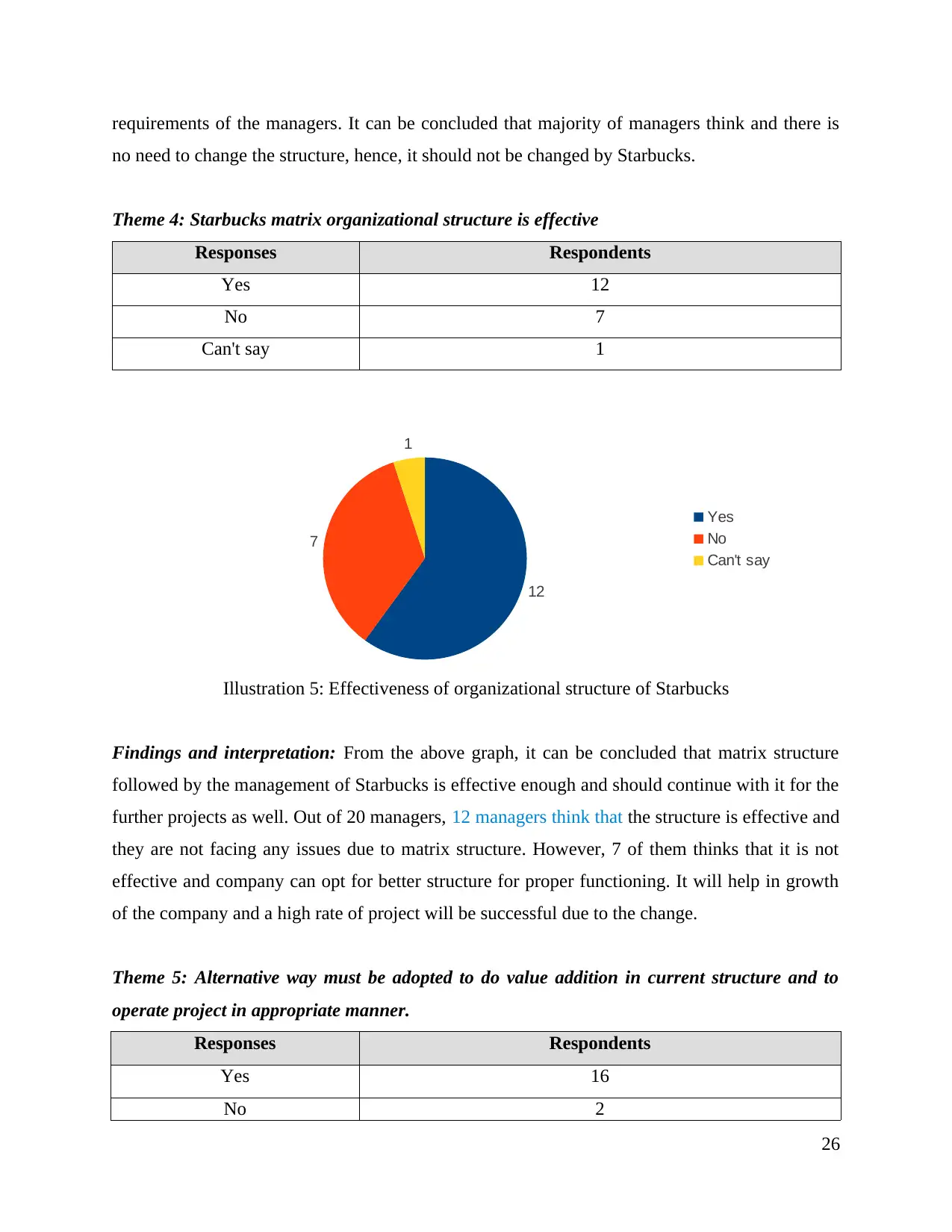
requirements of the managers. It can be concluded that majority of managers think and there is
no need to change the structure, hence, it should not be changed by Starbucks.
Theme 4: Starbucks matrix organizational structure is effective
Responses Respondents
Yes 12
No 7
Can't say 1
Findings and interpretation: From the above graph, it can be concluded that matrix structure
followed by the management of Starbucks is effective enough and should continue with it for the
further projects as well. Out of 20 managers, 12 managers think that the structure is effective and
they are not facing any issues due to matrix structure. However, 7 of them thinks that it is not
effective and company can opt for better structure for proper functioning. It will help in growth
of the company and a high rate of project will be successful due to the change.
Theme 5: Alternative way must be adopted to do value addition in current structure and to
operate project in appropriate manner.
Responses Respondents
Yes 16
No 2
26
12
7
1
Yes
No
Can't say
Illustration 5: Effectiveness of organizational structure of Starbucks
no need to change the structure, hence, it should not be changed by Starbucks.
Theme 4: Starbucks matrix organizational structure is effective
Responses Respondents
Yes 12
No 7
Can't say 1
Findings and interpretation: From the above graph, it can be concluded that matrix structure
followed by the management of Starbucks is effective enough and should continue with it for the
further projects as well. Out of 20 managers, 12 managers think that the structure is effective and
they are not facing any issues due to matrix structure. However, 7 of them thinks that it is not
effective and company can opt for better structure for proper functioning. It will help in growth
of the company and a high rate of project will be successful due to the change.
Theme 5: Alternative way must be adopted to do value addition in current structure and to
operate project in appropriate manner.
Responses Respondents
Yes 16
No 2
26
12
7
1
Yes
No
Can't say
Illustration 5: Effectiveness of organizational structure of Starbucks
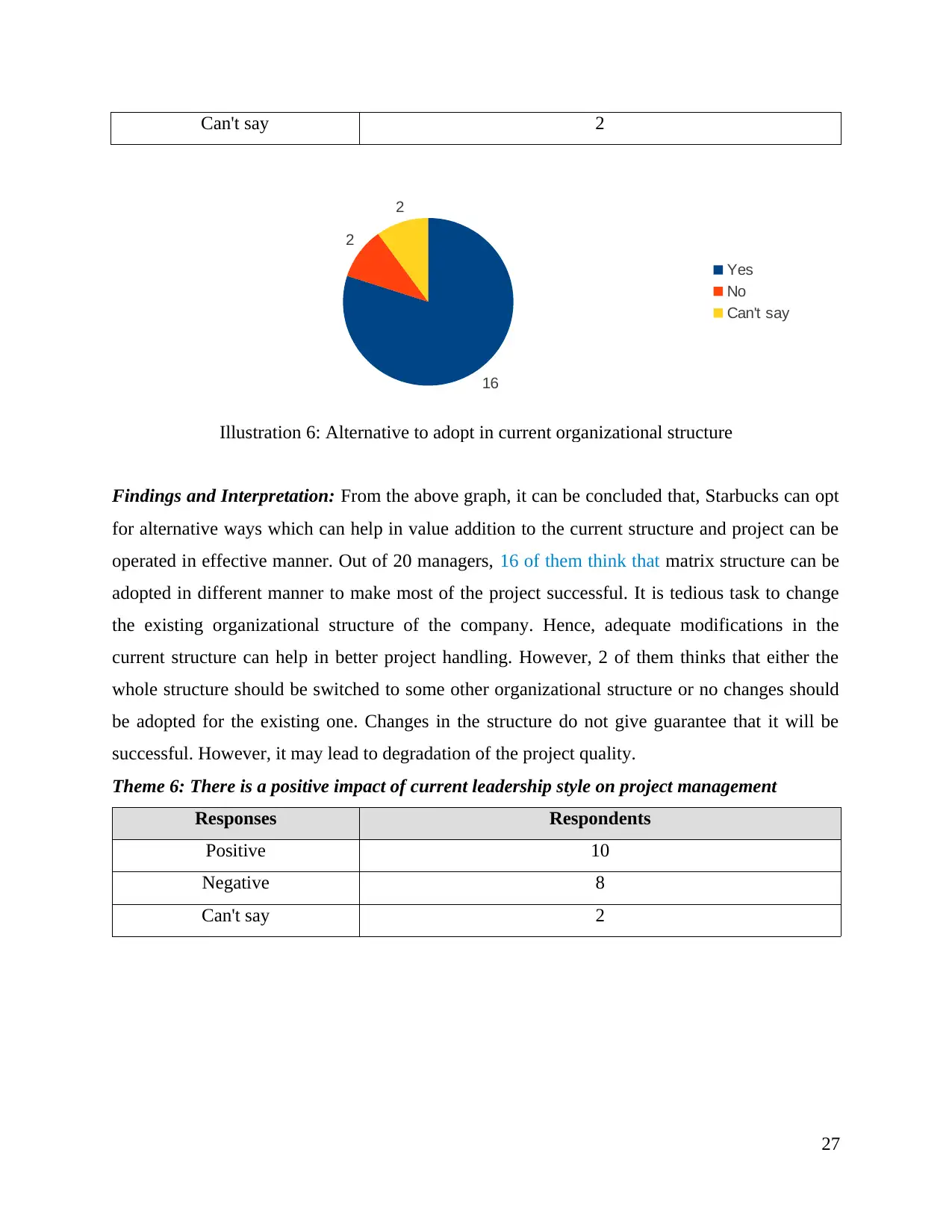
Can't say 2
Findings and Interpretation: From the above graph, it can be concluded that, Starbucks can opt
for alternative ways which can help in value addition to the current structure and project can be
operated in effective manner. Out of 20 managers, 16 of them think that matrix structure can be
adopted in different manner to make most of the project successful. It is tedious task to change
the existing organizational structure of the company. Hence, adequate modifications in the
current structure can help in better project handling. However, 2 of them thinks that either the
whole structure should be switched to some other organizational structure or no changes should
be adopted for the existing one. Changes in the structure do not give guarantee that it will be
successful. However, it may lead to degradation of the project quality.
Theme 6: There is a positive impact of current leadership style on project management
Responses Respondents
Positive 10
Negative 8
Can't say 2
27
16
2
2
Yes
No
Can't say
Illustration 6: Alternative to adopt in current organizational structure
Findings and Interpretation: From the above graph, it can be concluded that, Starbucks can opt
for alternative ways which can help in value addition to the current structure and project can be
operated in effective manner. Out of 20 managers, 16 of them think that matrix structure can be
adopted in different manner to make most of the project successful. It is tedious task to change
the existing organizational structure of the company. Hence, adequate modifications in the
current structure can help in better project handling. However, 2 of them thinks that either the
whole structure should be switched to some other organizational structure or no changes should
be adopted for the existing one. Changes in the structure do not give guarantee that it will be
successful. However, it may lead to degradation of the project quality.
Theme 6: There is a positive impact of current leadership style on project management
Responses Respondents
Positive 10
Negative 8
Can't say 2
27
16
2
2
Yes
No
Can't say
Illustration 6: Alternative to adopt in current organizational structure
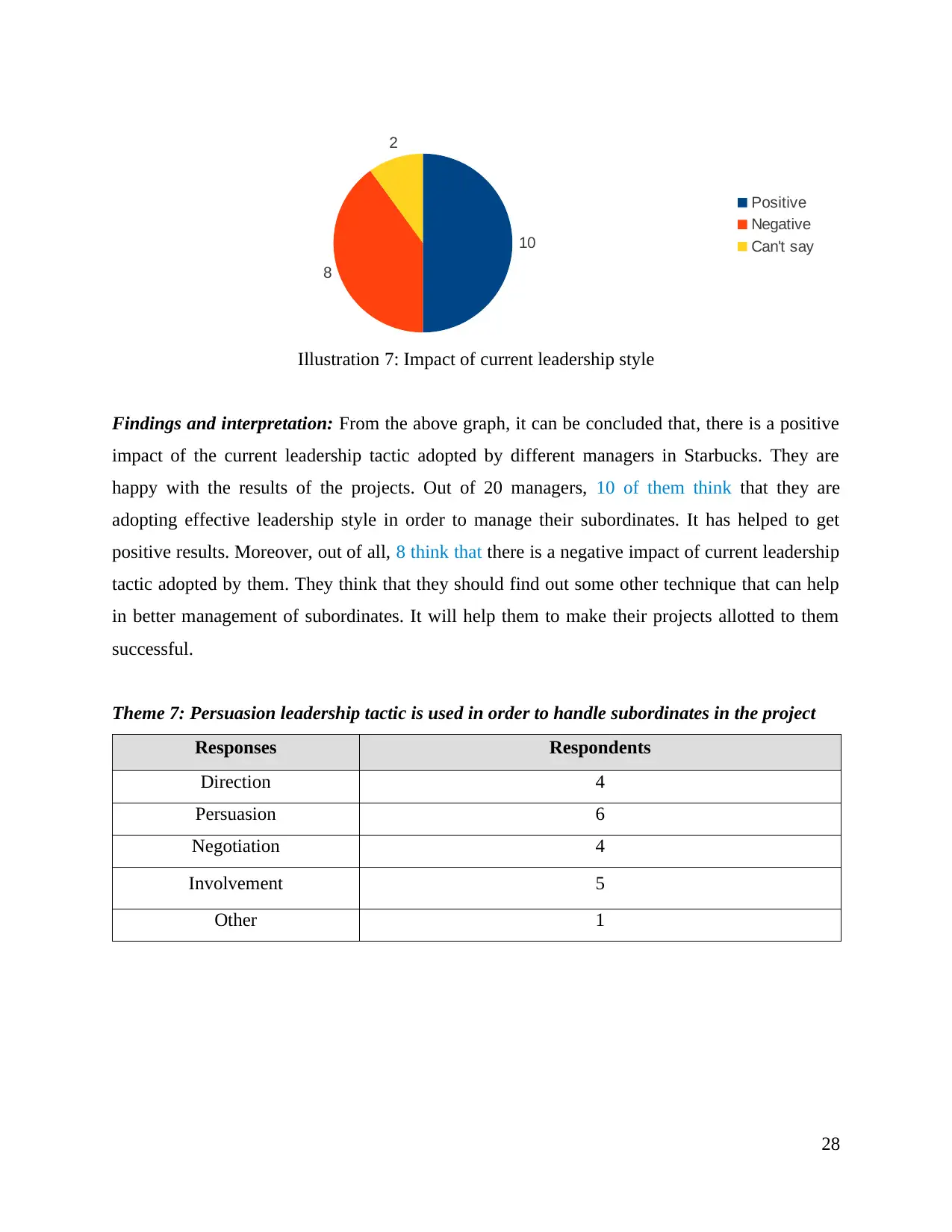
Findings and interpretation: From the above graph, it can be concluded that, there is a positive
impact of the current leadership tactic adopted by different managers in Starbucks. They are
happy with the results of the projects. Out of 20 managers, 10 of them think that they are
adopting effective leadership style in order to manage their subordinates. It has helped to get
positive results. Moreover, out of all, 8 think that there is a negative impact of current leadership
tactic adopted by them. They think that they should find out some other technique that can help
in better management of subordinates. It will help them to make their projects allotted to them
successful.
Theme 7: Persuasion leadership tactic is used in order to handle subordinates in the project
Responses Respondents
Direction 4
Persuasion 6
Negotiation 4
Involvement 5
Other 1
28
10
8
2
Positive
Negative
Can't say
Illustration 7: Impact of current leadership style
impact of the current leadership tactic adopted by different managers in Starbucks. They are
happy with the results of the projects. Out of 20 managers, 10 of them think that they are
adopting effective leadership style in order to manage their subordinates. It has helped to get
positive results. Moreover, out of all, 8 think that there is a negative impact of current leadership
tactic adopted by them. They think that they should find out some other technique that can help
in better management of subordinates. It will help them to make their projects allotted to them
successful.
Theme 7: Persuasion leadership tactic is used in order to handle subordinates in the project
Responses Respondents
Direction 4
Persuasion 6
Negotiation 4
Involvement 5
Other 1
28
10
8
2
Positive
Negative
Can't say
Illustration 7: Impact of current leadership style
Secure Best Marks with AI Grader
Need help grading? Try our AI Grader for instant feedback on your assignments.
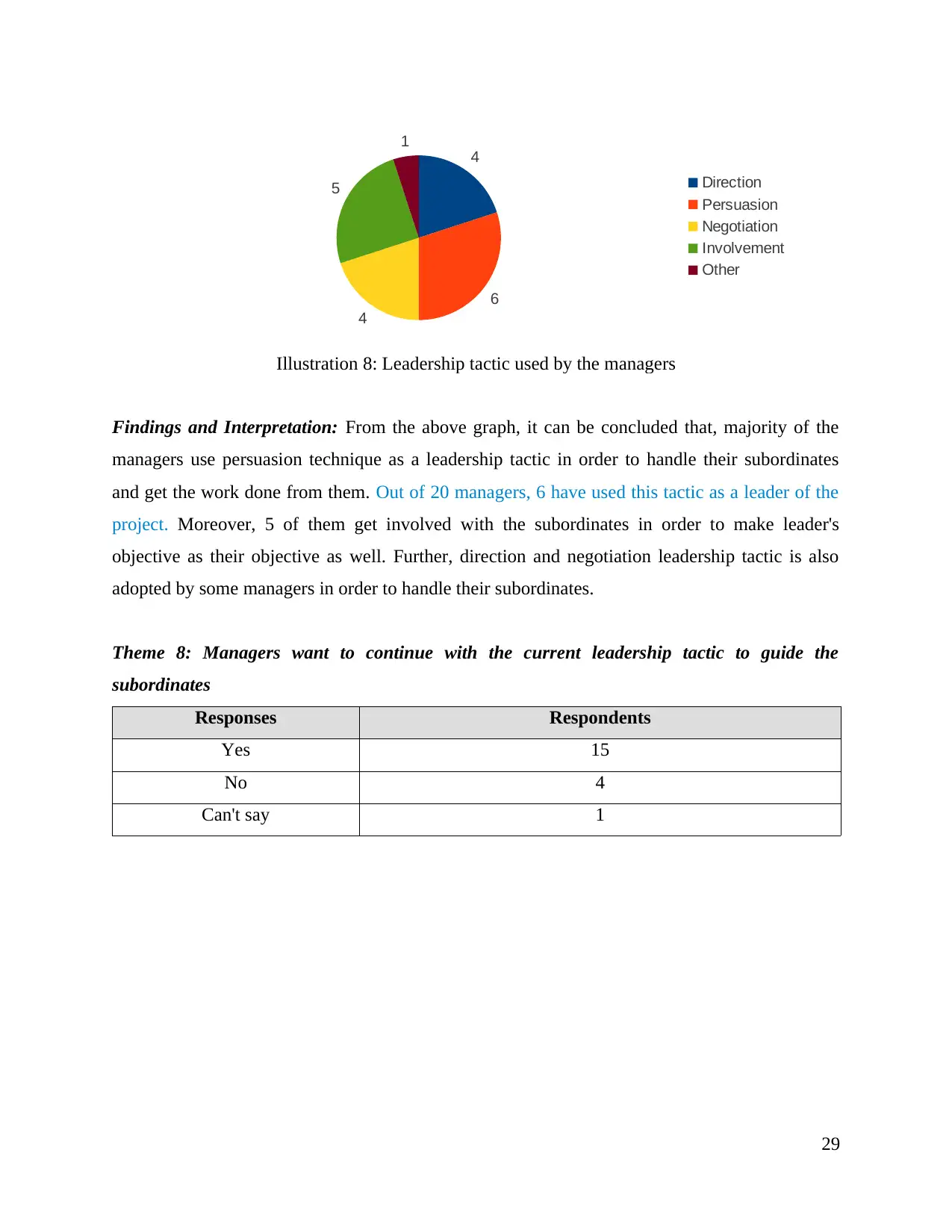
Findings and Interpretation: From the above graph, it can be concluded that, majority of the
managers use persuasion technique as a leadership tactic in order to handle their subordinates
and get the work done from them. Out of 20 managers, 6 have used this tactic as a leader of the
project. Moreover, 5 of them get involved with the subordinates in order to make leader's
objective as their objective as well. Further, direction and negotiation leadership tactic is also
adopted by some managers in order to handle their subordinates.
Theme 8: Managers want to continue with the current leadership tactic to guide the
subordinates
Responses Respondents
Yes 15
No 4
Can't say 1
29
4
6
4
5
1
Direction
Persuasion
Negotiation
Involvement
Other
Illustration 8: Leadership tactic used by the managers
managers use persuasion technique as a leadership tactic in order to handle their subordinates
and get the work done from them. Out of 20 managers, 6 have used this tactic as a leader of the
project. Moreover, 5 of them get involved with the subordinates in order to make leader's
objective as their objective as well. Further, direction and negotiation leadership tactic is also
adopted by some managers in order to handle their subordinates.
Theme 8: Managers want to continue with the current leadership tactic to guide the
subordinates
Responses Respondents
Yes 15
No 4
Can't say 1
29
4
6
4
5
1
Direction
Persuasion
Negotiation
Involvement
Other
Illustration 8: Leadership tactic used by the managers
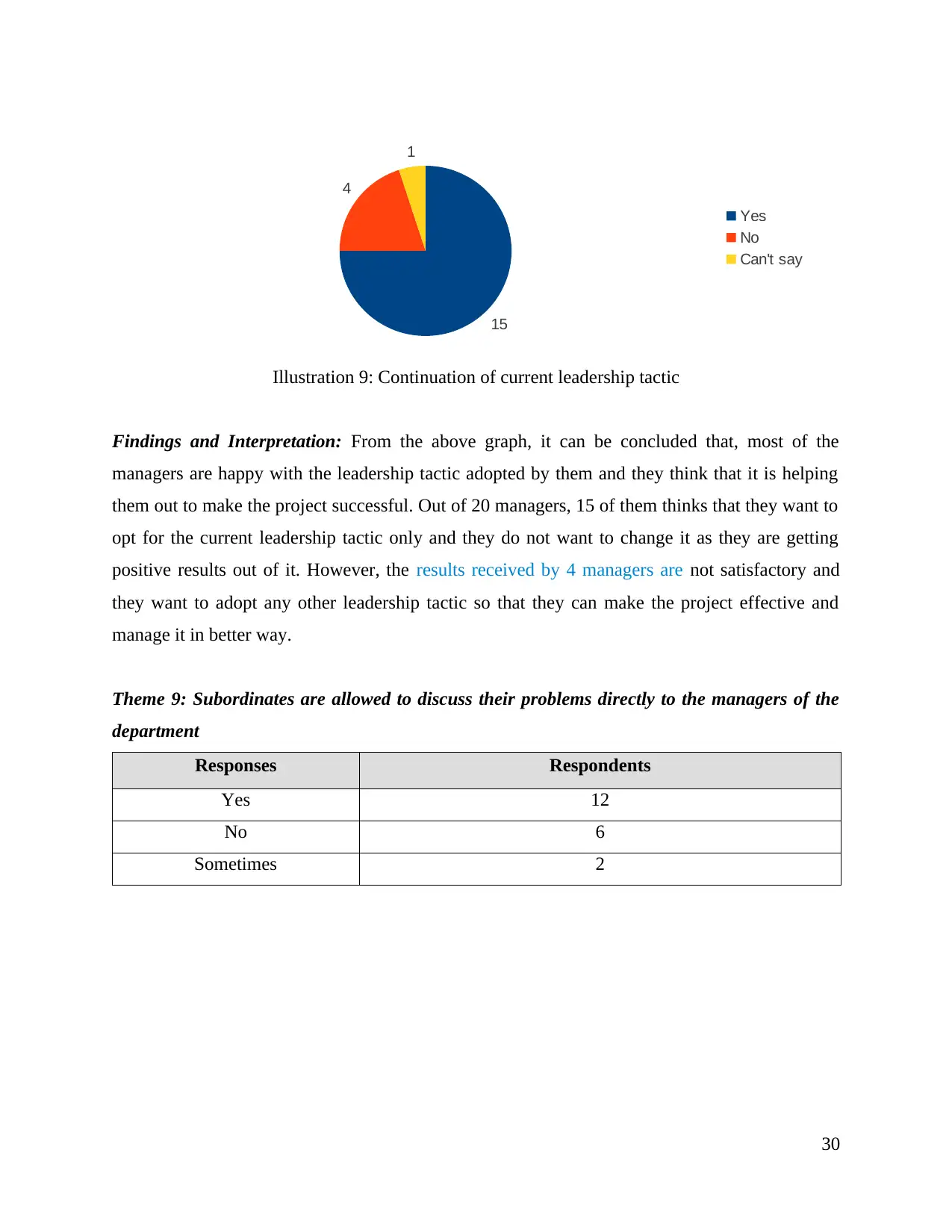
Findings and Interpretation: From the above graph, it can be concluded that, most of the
managers are happy with the leadership tactic adopted by them and they think that it is helping
them out to make the project successful. Out of 20 managers, 15 of them thinks that they want to
opt for the current leadership tactic only and they do not want to change it as they are getting
positive results out of it. However, the results received by 4 managers are not satisfactory and
they want to adopt any other leadership tactic so that they can make the project effective and
manage it in better way.
Theme 9: Subordinates are allowed to discuss their problems directly to the managers of the
department
Responses Respondents
Yes 12
No 6
Sometimes 2
30
15
4
1
Yes
No
Can't say
Illustration 9: Continuation of current leadership tactic
managers are happy with the leadership tactic adopted by them and they think that it is helping
them out to make the project successful. Out of 20 managers, 15 of them thinks that they want to
opt for the current leadership tactic only and they do not want to change it as they are getting
positive results out of it. However, the results received by 4 managers are not satisfactory and
they want to adopt any other leadership tactic so that they can make the project effective and
manage it in better way.
Theme 9: Subordinates are allowed to discuss their problems directly to the managers of the
department
Responses Respondents
Yes 12
No 6
Sometimes 2
30
15
4
1
Yes
No
Can't say
Illustration 9: Continuation of current leadership tactic
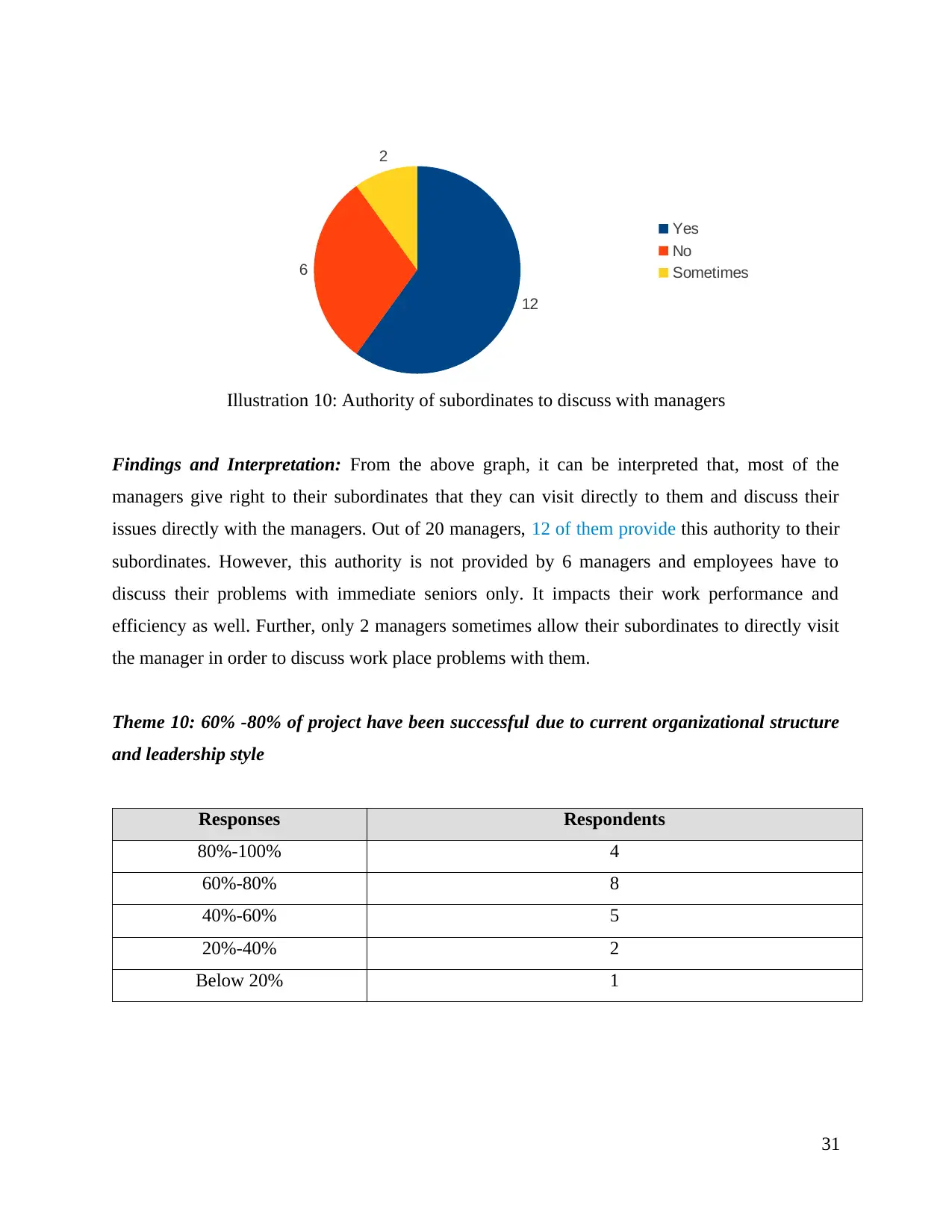
Findings and Interpretation: From the above graph, it can be interpreted that, most of the
managers give right to their subordinates that they can visit directly to them and discuss their
issues directly with the managers. Out of 20 managers, 12 of them provide this authority to their
subordinates. However, this authority is not provided by 6 managers and employees have to
discuss their problems with immediate seniors only. It impacts their work performance and
efficiency as well. Further, only 2 managers sometimes allow their subordinates to directly visit
the manager in order to discuss work place problems with them.
Theme 10: 60% -80% of project have been successful due to current organizational structure
and leadership style
Responses Respondents
80%-100% 4
60%-80% 8
40%-60% 5
20%-40% 2
Below 20% 1
31
12
6
2
Yes
No
Sometimes
Illustration 10: Authority of subordinates to discuss with managers
managers give right to their subordinates that they can visit directly to them and discuss their
issues directly with the managers. Out of 20 managers, 12 of them provide this authority to their
subordinates. However, this authority is not provided by 6 managers and employees have to
discuss their problems with immediate seniors only. It impacts their work performance and
efficiency as well. Further, only 2 managers sometimes allow their subordinates to directly visit
the manager in order to discuss work place problems with them.
Theme 10: 60% -80% of project have been successful due to current organizational structure
and leadership style
Responses Respondents
80%-100% 4
60%-80% 8
40%-60% 5
20%-40% 2
Below 20% 1
31
12
6
2
Yes
No
Sometimes
Illustration 10: Authority of subordinates to discuss with managers
Paraphrase This Document
Need a fresh take? Get an instant paraphrase of this document with our AI Paraphraser
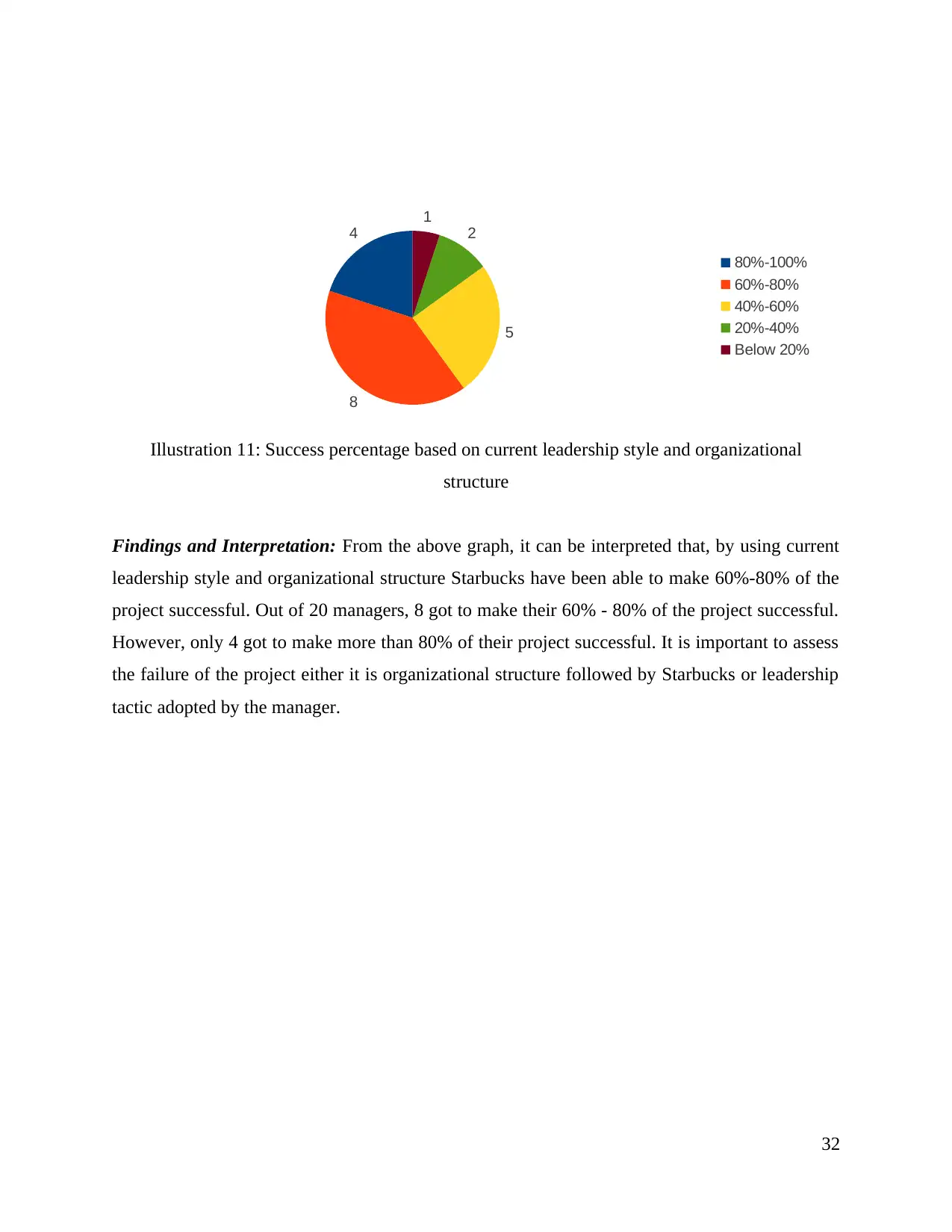
Findings and Interpretation: From the above graph, it can be interpreted that, by using current
leadership style and organizational structure Starbucks have been able to make 60%-80% of the
project successful. Out of 20 managers, 8 got to make their 60% - 80% of the project successful.
However, only 4 got to make more than 80% of their project successful. It is important to assess
the failure of the project either it is organizational structure followed by Starbucks or leadership
tactic adopted by the manager.
32
4
8
5
2
1
80%-100%
60%-80%
40%-60%
20%-40%
Below 20%
Illustration 11: Success percentage based on current leadership style and organizational
structure
leadership style and organizational structure Starbucks have been able to make 60%-80% of the
project successful. Out of 20 managers, 8 got to make their 60% - 80% of the project successful.
However, only 4 got to make more than 80% of their project successful. It is important to assess
the failure of the project either it is organizational structure followed by Starbucks or leadership
tactic adopted by the manager.
32
4
8
5
2
1
80%-100%
60%-80%
40%-60%
20%-40%
Below 20%
Illustration 11: Success percentage based on current leadership style and organizational
structure

CHAPTER 5
DISCUSSION OF THE FINDINGS
Theme 1: Structure of the organization has direct impact on project management
There is a direct impact of organizational structure followed by the company. It helps in
reducing communication problems, conflicts resolution and team building. Organizational
structure of the entity is decided based on the work carried out by them and size of the company
as well (Chen and Chang, 2012). For instance, if the company is running on small scale then it is
effective that it opt for functional structure. It required less number of people and work can be
managed effectively in small company. However, if the company is operating at large scale like
Starbucks then it is important that it follows divisional or matrix organizational structure rather
than opting for functional structure. It helps in better implementation of plan and project can be
completed in effective manner. Appropriate organizational structure helps in making optimum
utilization of resources available with the company. However, in contrast to this, literature
review suggests that matrix structure is a complicated structure and should be adopted by
multinational companies having their establishment all around the world. Prudent decision will
reduce the cost for the company as well as for the end consumers as well.
Theme 2: Firms must analyse the structure before carrying out any project
It is important that the entity analyse the organizational structure before opting for any
other project. Better organizational structure helps in effective implementation of plan and
generate higher profits to the company as well. Further the enterprise can make optimum
utilization of resources (Jenkins and Dillon, 2012). There may be a reason that the structure
which was effective in one project may not be appropriate for the other one as well. Proper
analysis helps in resolving this problem. Managers of the Starbucks also think the same and
advises the company to check the structure before implementing any plan. However, in contrast
to this, literature review suggested that it is tedious job to switch from one structure to another. It
gives rise to develop an altogether new team structure and defining roles and responsibilities to
them. It can be a time taking process for the managers and for the employees as well.
Theme 3: There is no need to change the current structure to make the projects successful
The current structure followed by Starbucks is Matrix organisational structure which
states that there is a grid in reporting relationship in comparison to the other traditional structure.
It is important to understand that the company should have effective plan to implement its
33
DISCUSSION OF THE FINDINGS
Theme 1: Structure of the organization has direct impact on project management
There is a direct impact of organizational structure followed by the company. It helps in
reducing communication problems, conflicts resolution and team building. Organizational
structure of the entity is decided based on the work carried out by them and size of the company
as well (Chen and Chang, 2012). For instance, if the company is running on small scale then it is
effective that it opt for functional structure. It required less number of people and work can be
managed effectively in small company. However, if the company is operating at large scale like
Starbucks then it is important that it follows divisional or matrix organizational structure rather
than opting for functional structure. It helps in better implementation of plan and project can be
completed in effective manner. Appropriate organizational structure helps in making optimum
utilization of resources available with the company. However, in contrast to this, literature
review suggests that matrix structure is a complicated structure and should be adopted by
multinational companies having their establishment all around the world. Prudent decision will
reduce the cost for the company as well as for the end consumers as well.
Theme 2: Firms must analyse the structure before carrying out any project
It is important that the entity analyse the organizational structure before opting for any
other project. Better organizational structure helps in effective implementation of plan and
generate higher profits to the company as well. Further the enterprise can make optimum
utilization of resources (Jenkins and Dillon, 2012). There may be a reason that the structure
which was effective in one project may not be appropriate for the other one as well. Proper
analysis helps in resolving this problem. Managers of the Starbucks also think the same and
advises the company to check the structure before implementing any plan. However, in contrast
to this, literature review suggested that it is tedious job to switch from one structure to another. It
gives rise to develop an altogether new team structure and defining roles and responsibilities to
them. It can be a time taking process for the managers and for the employees as well.
Theme 3: There is no need to change the current structure to make the projects successful
The current structure followed by Starbucks is Matrix organisational structure which
states that there is a grid in reporting relationship in comparison to the other traditional structure.
It is important to understand that the company should have effective plan to implement its
33
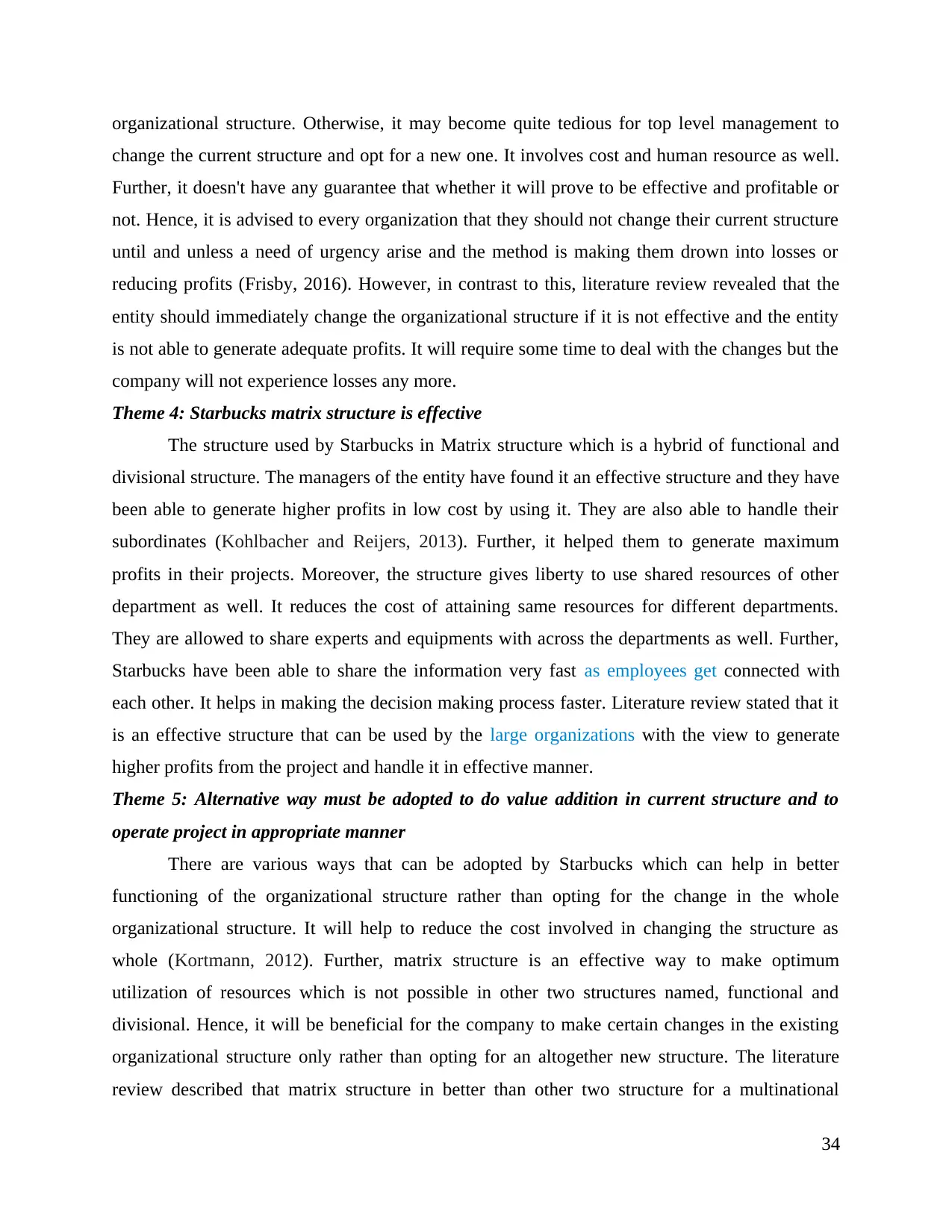
organizational structure. Otherwise, it may become quite tedious for top level management to
change the current structure and opt for a new one. It involves cost and human resource as well.
Further, it doesn't have any guarantee that whether it will prove to be effective and profitable or
not. Hence, it is advised to every organization that they should not change their current structure
until and unless a need of urgency arise and the method is making them drown into losses or
reducing profits (Frisby, 2016). However, in contrast to this, literature review revealed that the
entity should immediately change the organizational structure if it is not effective and the entity
is not able to generate adequate profits. It will require some time to deal with the changes but the
company will not experience losses any more.
Theme 4: Starbucks matrix structure is effective
The structure used by Starbucks in Matrix structure which is a hybrid of functional and
divisional structure. The managers of the entity have found it an effective structure and they have
been able to generate higher profits in low cost by using it. They are also able to handle their
subordinates (Kohlbacher and Reijers, 2013). Further, it helped them to generate maximum
profits in their projects. Moreover, the structure gives liberty to use shared resources of other
department as well. It reduces the cost of attaining same resources for different departments.
They are allowed to share experts and equipments with across the departments as well. Further,
Starbucks have been able to share the information very fast as employees get connected with
each other. It helps in making the decision making process faster. Literature review stated that it
is an effective structure that can be used by the large organizations with the view to generate
higher profits from the project and handle it in effective manner.
Theme 5: Alternative way must be adopted to do value addition in current structure and to
operate project in appropriate manner
There are various ways that can be adopted by Starbucks which can help in better
functioning of the organizational structure rather than opting for the change in the whole
organizational structure. It will help to reduce the cost involved in changing the structure as
whole (Kortmann, 2012). Further, matrix structure is an effective way to make optimum
utilization of resources which is not possible in other two structures named, functional and
divisional. Hence, it will be beneficial for the company to make certain changes in the existing
organizational structure only rather than opting for an altogether new structure. The literature
review described that matrix structure in better than other two structure for a multinational
34
change the current structure and opt for a new one. It involves cost and human resource as well.
Further, it doesn't have any guarantee that whether it will prove to be effective and profitable or
not. Hence, it is advised to every organization that they should not change their current structure
until and unless a need of urgency arise and the method is making them drown into losses or
reducing profits (Frisby, 2016). However, in contrast to this, literature review revealed that the
entity should immediately change the organizational structure if it is not effective and the entity
is not able to generate adequate profits. It will require some time to deal with the changes but the
company will not experience losses any more.
Theme 4: Starbucks matrix structure is effective
The structure used by Starbucks in Matrix structure which is a hybrid of functional and
divisional structure. The managers of the entity have found it an effective structure and they have
been able to generate higher profits in low cost by using it. They are also able to handle their
subordinates (Kohlbacher and Reijers, 2013). Further, it helped them to generate maximum
profits in their projects. Moreover, the structure gives liberty to use shared resources of other
department as well. It reduces the cost of attaining same resources for different departments.
They are allowed to share experts and equipments with across the departments as well. Further,
Starbucks have been able to share the information very fast as employees get connected with
each other. It helps in making the decision making process faster. Literature review stated that it
is an effective structure that can be used by the large organizations with the view to generate
higher profits from the project and handle it in effective manner.
Theme 5: Alternative way must be adopted to do value addition in current structure and to
operate project in appropriate manner
There are various ways that can be adopted by Starbucks which can help in better
functioning of the organizational structure rather than opting for the change in the whole
organizational structure. It will help to reduce the cost involved in changing the structure as
whole (Kortmann, 2012). Further, matrix structure is an effective way to make optimum
utilization of resources which is not possible in other two structures named, functional and
divisional. Hence, it will be beneficial for the company to make certain changes in the existing
organizational structure only rather than opting for an altogether new structure. The literature
review described that matrix structure in better than other two structure for a multinational
34
Secure Best Marks with AI Grader
Need help grading? Try our AI Grader for instant feedback on your assignments.
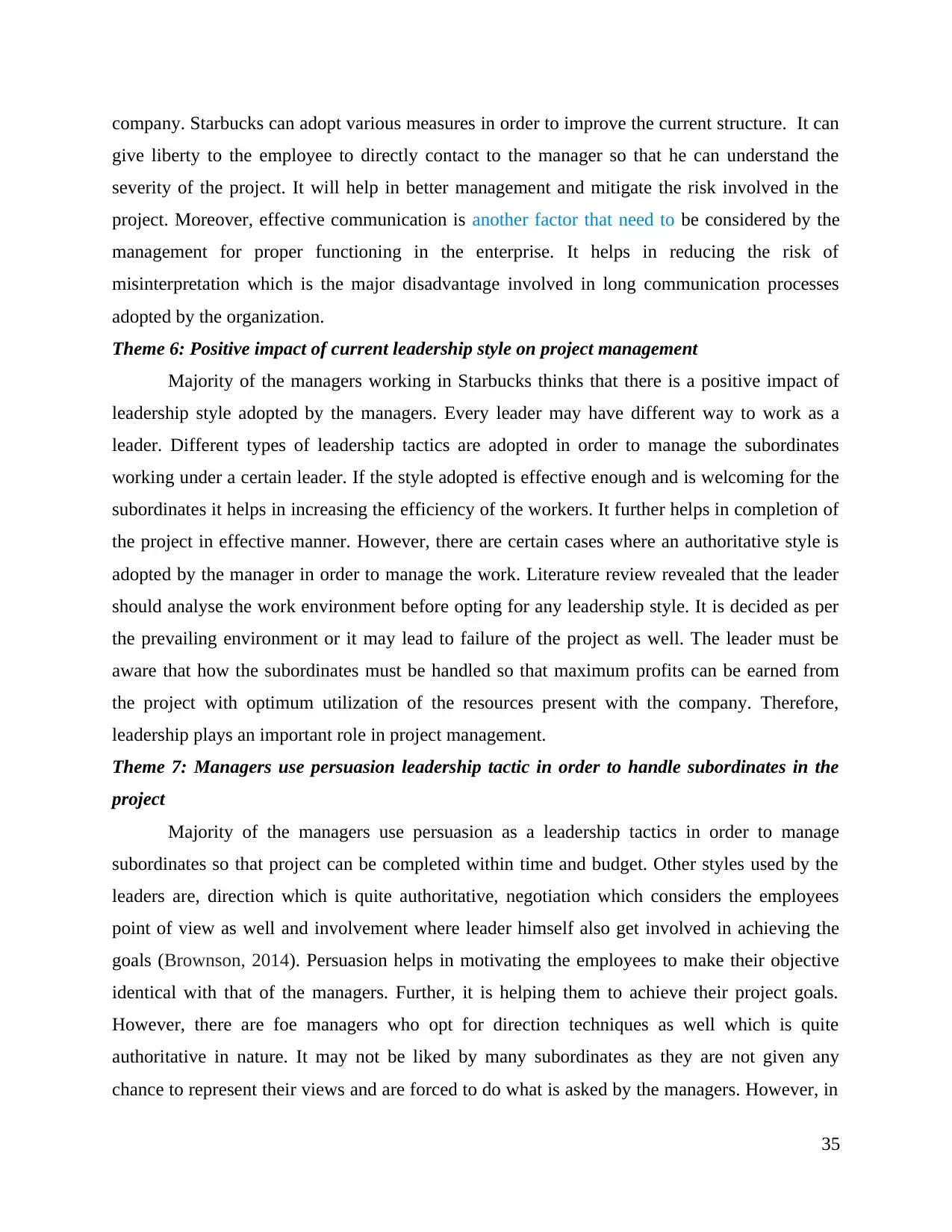
company. Starbucks can adopt various measures in order to improve the current structure. It can
give liberty to the employee to directly contact to the manager so that he can understand the
severity of the project. It will help in better management and mitigate the risk involved in the
project. Moreover, effective communication is another factor that need to be considered by the
management for proper functioning in the enterprise. It helps in reducing the risk of
misinterpretation which is the major disadvantage involved in long communication processes
adopted by the organization.
Theme 6: Positive impact of current leadership style on project management
Majority of the managers working in Starbucks thinks that there is a positive impact of
leadership style adopted by the managers. Every leader may have different way to work as a
leader. Different types of leadership tactics are adopted in order to manage the subordinates
working under a certain leader. If the style adopted is effective enough and is welcoming for the
subordinates it helps in increasing the efficiency of the workers. It further helps in completion of
the project in effective manner. However, there are certain cases where an authoritative style is
adopted by the manager in order to manage the work. Literature review revealed that the leader
should analyse the work environment before opting for any leadership style. It is decided as per
the prevailing environment or it may lead to failure of the project as well. The leader must be
aware that how the subordinates must be handled so that maximum profits can be earned from
the project with optimum utilization of the resources present with the company. Therefore,
leadership plays an important role in project management.
Theme 7: Managers use persuasion leadership tactic in order to handle subordinates in the
project
Majority of the managers use persuasion as a leadership tactics in order to manage
subordinates so that project can be completed within time and budget. Other styles used by the
leaders are, direction which is quite authoritative, negotiation which considers the employees
point of view as well and involvement where leader himself also get involved in achieving the
goals (Brownson, 2014). Persuasion helps in motivating the employees to make their objective
identical with that of the managers. Further, it is helping them to achieve their project goals.
However, there are foe managers who opt for direction techniques as well which is quite
authoritative in nature. It may not be liked by many subordinates as they are not given any
chance to represent their views and are forced to do what is asked by the managers. However, in
35
give liberty to the employee to directly contact to the manager so that he can understand the
severity of the project. It will help in better management and mitigate the risk involved in the
project. Moreover, effective communication is another factor that need to be considered by the
management for proper functioning in the enterprise. It helps in reducing the risk of
misinterpretation which is the major disadvantage involved in long communication processes
adopted by the organization.
Theme 6: Positive impact of current leadership style on project management
Majority of the managers working in Starbucks thinks that there is a positive impact of
leadership style adopted by the managers. Every leader may have different way to work as a
leader. Different types of leadership tactics are adopted in order to manage the subordinates
working under a certain leader. If the style adopted is effective enough and is welcoming for the
subordinates it helps in increasing the efficiency of the workers. It further helps in completion of
the project in effective manner. However, there are certain cases where an authoritative style is
adopted by the manager in order to manage the work. Literature review revealed that the leader
should analyse the work environment before opting for any leadership style. It is decided as per
the prevailing environment or it may lead to failure of the project as well. The leader must be
aware that how the subordinates must be handled so that maximum profits can be earned from
the project with optimum utilization of the resources present with the company. Therefore,
leadership plays an important role in project management.
Theme 7: Managers use persuasion leadership tactic in order to handle subordinates in the
project
Majority of the managers use persuasion as a leadership tactics in order to manage
subordinates so that project can be completed within time and budget. Other styles used by the
leaders are, direction which is quite authoritative, negotiation which considers the employees
point of view as well and involvement where leader himself also get involved in achieving the
goals (Brownson, 2014). Persuasion helps in motivating the employees to make their objective
identical with that of the managers. Further, it is helping them to achieve their project goals.
However, there are foe managers who opt for direction techniques as well which is quite
authoritative in nature. It may not be liked by many subordinates as they are not given any
chance to represent their views and are forced to do what is asked by the managers. However, in
35
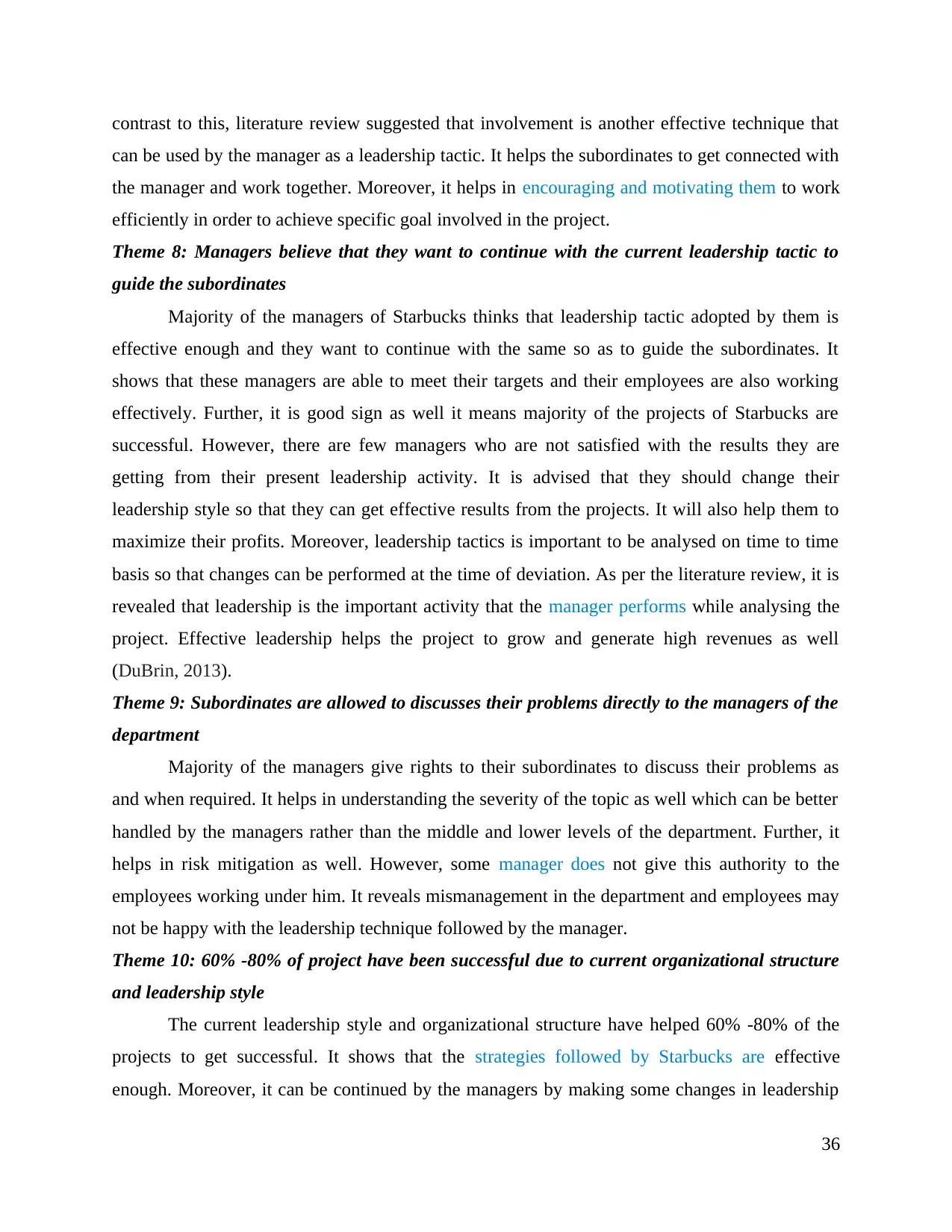
contrast to this, literature review suggested that involvement is another effective technique that
can be used by the manager as a leadership tactic. It helps the subordinates to get connected with
the manager and work together. Moreover, it helps in encouraging and motivating them to work
efficiently in order to achieve specific goal involved in the project.
Theme 8: Managers believe that they want to continue with the current leadership tactic to
guide the subordinates
Majority of the managers of Starbucks thinks that leadership tactic adopted by them is
effective enough and they want to continue with the same so as to guide the subordinates. It
shows that these managers are able to meet their targets and their employees are also working
effectively. Further, it is good sign as well it means majority of the projects of Starbucks are
successful. However, there are few managers who are not satisfied with the results they are
getting from their present leadership activity. It is advised that they should change their
leadership style so that they can get effective results from the projects. It will also help them to
maximize their profits. Moreover, leadership tactics is important to be analysed on time to time
basis so that changes can be performed at the time of deviation. As per the literature review, it is
revealed that leadership is the important activity that the manager performs while analysing the
project. Effective leadership helps the project to grow and generate high revenues as well
(DuBrin, 2013).
Theme 9: Subordinates are allowed to discusses their problems directly to the managers of the
department
Majority of the managers give rights to their subordinates to discuss their problems as
and when required. It helps in understanding the severity of the topic as well which can be better
handled by the managers rather than the middle and lower levels of the department. Further, it
helps in risk mitigation as well. However, some manager does not give this authority to the
employees working under him. It reveals mismanagement in the department and employees may
not be happy with the leadership technique followed by the manager.
Theme 10: 60% -80% of project have been successful due to current organizational structure
and leadership style
The current leadership style and organizational structure have helped 60% -80% of the
projects to get successful. It shows that the strategies followed by Starbucks are effective
enough. Moreover, it can be continued by the managers by making some changes in leadership
36
can be used by the manager as a leadership tactic. It helps the subordinates to get connected with
the manager and work together. Moreover, it helps in encouraging and motivating them to work
efficiently in order to achieve specific goal involved in the project.
Theme 8: Managers believe that they want to continue with the current leadership tactic to
guide the subordinates
Majority of the managers of Starbucks thinks that leadership tactic adopted by them is
effective enough and they want to continue with the same so as to guide the subordinates. It
shows that these managers are able to meet their targets and their employees are also working
effectively. Further, it is good sign as well it means majority of the projects of Starbucks are
successful. However, there are few managers who are not satisfied with the results they are
getting from their present leadership activity. It is advised that they should change their
leadership style so that they can get effective results from the projects. It will also help them to
maximize their profits. Moreover, leadership tactics is important to be analysed on time to time
basis so that changes can be performed at the time of deviation. As per the literature review, it is
revealed that leadership is the important activity that the manager performs while analysing the
project. Effective leadership helps the project to grow and generate high revenues as well
(DuBrin, 2013).
Theme 9: Subordinates are allowed to discusses their problems directly to the managers of the
department
Majority of the managers give rights to their subordinates to discuss their problems as
and when required. It helps in understanding the severity of the topic as well which can be better
handled by the managers rather than the middle and lower levels of the department. Further, it
helps in risk mitigation as well. However, some manager does not give this authority to the
employees working under him. It reveals mismanagement in the department and employees may
not be happy with the leadership technique followed by the manager.
Theme 10: 60% -80% of project have been successful due to current organizational structure
and leadership style
The current leadership style and organizational structure have helped 60% -80% of the
projects to get successful. It shows that the strategies followed by Starbucks are effective
enough. Moreover, it can be continued by the managers by making some changes in leadership
36
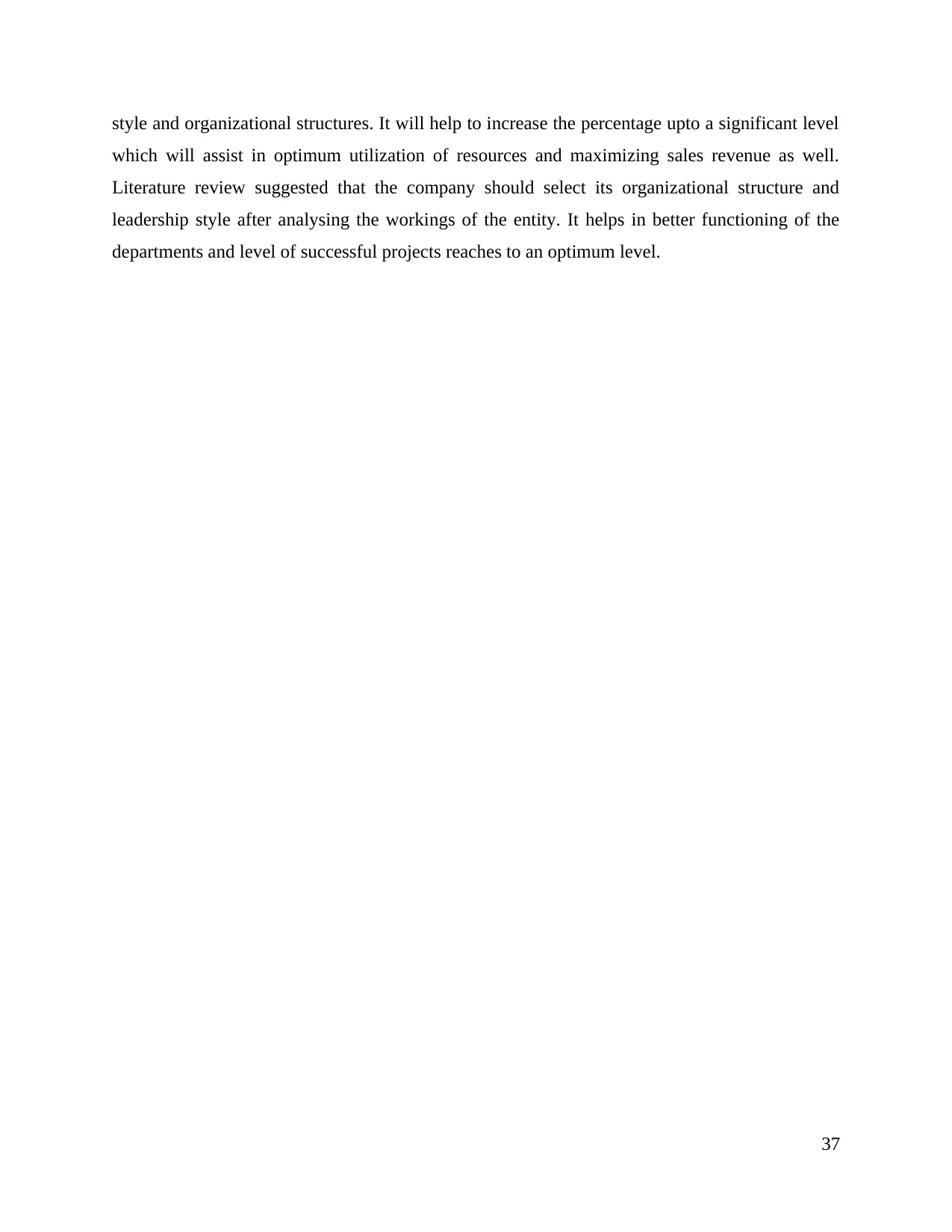
style and organizational structures. It will help to increase the percentage upto a significant level
which will assist in optimum utilization of resources and maximizing sales revenue as well.
Literature review suggested that the company should select its organizational structure and
leadership style after analysing the workings of the entity. It helps in better functioning of the
departments and level of successful projects reaches to an optimum level.
37
which will assist in optimum utilization of resources and maximizing sales revenue as well.
Literature review suggested that the company should select its organizational structure and
leadership style after analysing the workings of the entity. It helps in better functioning of the
departments and level of successful projects reaches to an optimum level.
37
Paraphrase This Document
Need a fresh take? Get an instant paraphrase of this document with our AI Paraphraser
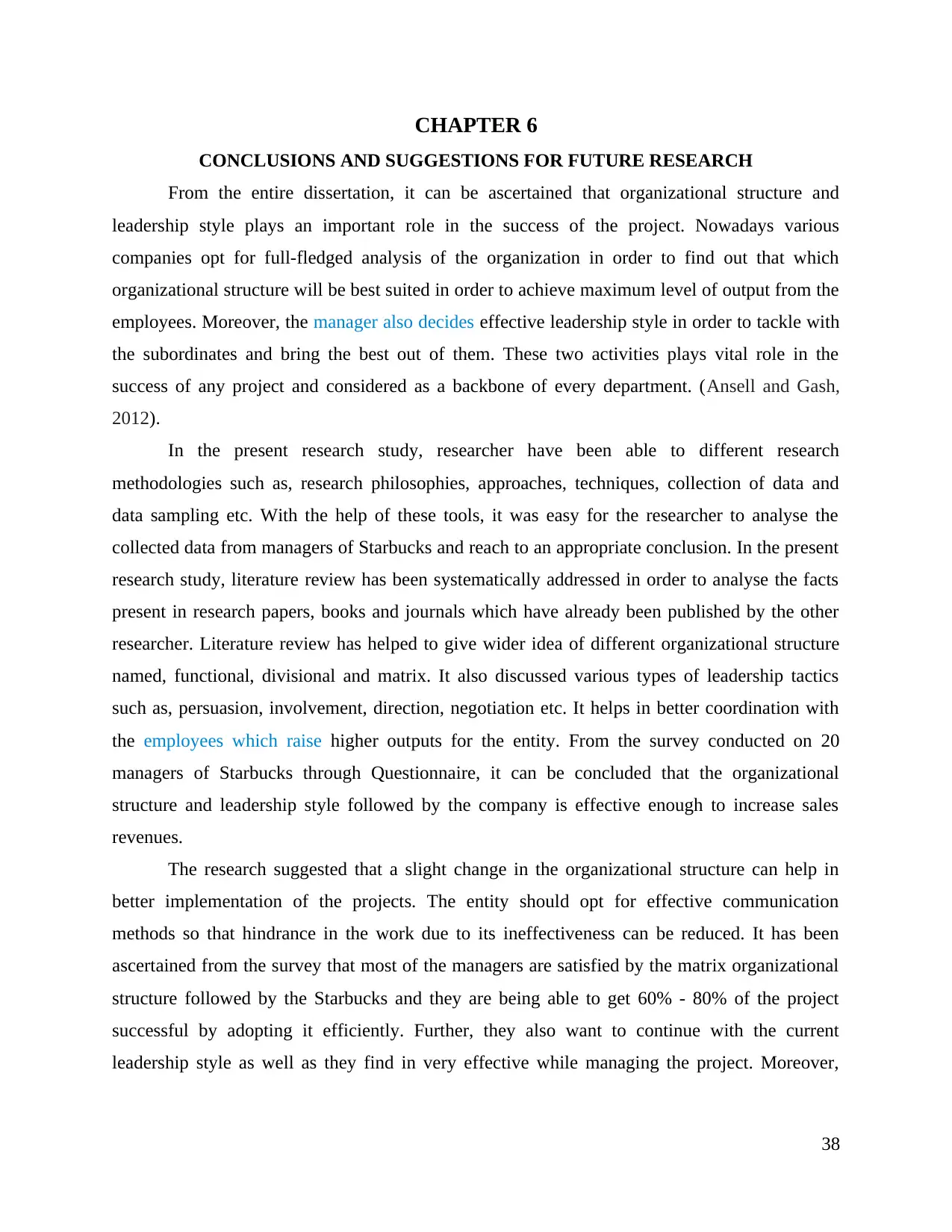
CHAPTER 6
CONCLUSIONS AND SUGGESTIONS FOR FUTURE RESEARCH
From the entire dissertation, it can be ascertained that organizational structure and
leadership style plays an important role in the success of the project. Nowadays various
companies opt for full-fledged analysis of the organization in order to find out that which
organizational structure will be best suited in order to achieve maximum level of output from the
employees. Moreover, the manager also decides effective leadership style in order to tackle with
the subordinates and bring the best out of them. These two activities plays vital role in the
success of any project and considered as a backbone of every department. (Ansell and Gash,
2012).
In the present research study, researcher have been able to different research
methodologies such as, research philosophies, approaches, techniques, collection of data and
data sampling etc. With the help of these tools, it was easy for the researcher to analyse the
collected data from managers of Starbucks and reach to an appropriate conclusion. In the present
research study, literature review has been systematically addressed in order to analyse the facts
present in research papers, books and journals which have already been published by the other
researcher. Literature review has helped to give wider idea of different organizational structure
named, functional, divisional and matrix. It also discussed various types of leadership tactics
such as, persuasion, involvement, direction, negotiation etc. It helps in better coordination with
the employees which raise higher outputs for the entity. From the survey conducted on 20
managers of Starbucks through Questionnaire, it can be concluded that the organizational
structure and leadership style followed by the company is effective enough to increase sales
revenues.
The research suggested that a slight change in the organizational structure can help in
better implementation of the projects. The entity should opt for effective communication
methods so that hindrance in the work due to its ineffectiveness can be reduced. It has been
ascertained from the survey that most of the managers are satisfied by the matrix organizational
structure followed by the Starbucks and they are being able to get 60% - 80% of the project
successful by adopting it efficiently. Further, they also want to continue with the current
leadership style as well as they find in very effective while managing the project. Moreover,
38
CONCLUSIONS AND SUGGESTIONS FOR FUTURE RESEARCH
From the entire dissertation, it can be ascertained that organizational structure and
leadership style plays an important role in the success of the project. Nowadays various
companies opt for full-fledged analysis of the organization in order to find out that which
organizational structure will be best suited in order to achieve maximum level of output from the
employees. Moreover, the manager also decides effective leadership style in order to tackle with
the subordinates and bring the best out of them. These two activities plays vital role in the
success of any project and considered as a backbone of every department. (Ansell and Gash,
2012).
In the present research study, researcher have been able to different research
methodologies such as, research philosophies, approaches, techniques, collection of data and
data sampling etc. With the help of these tools, it was easy for the researcher to analyse the
collected data from managers of Starbucks and reach to an appropriate conclusion. In the present
research study, literature review has been systematically addressed in order to analyse the facts
present in research papers, books and journals which have already been published by the other
researcher. Literature review has helped to give wider idea of different organizational structure
named, functional, divisional and matrix. It also discussed various types of leadership tactics
such as, persuasion, involvement, direction, negotiation etc. It helps in better coordination with
the employees which raise higher outputs for the entity. From the survey conducted on 20
managers of Starbucks through Questionnaire, it can be concluded that the organizational
structure and leadership style followed by the company is effective enough to increase sales
revenues.
The research suggested that a slight change in the organizational structure can help in
better implementation of the projects. The entity should opt for effective communication
methods so that hindrance in the work due to its ineffectiveness can be reduced. It has been
ascertained from the survey that most of the managers are satisfied by the matrix organizational
structure followed by the Starbucks and they are being able to get 60% - 80% of the project
successful by adopting it efficiently. Further, they also want to continue with the current
leadership style as well as they find in very effective while managing the project. Moreover,
38

appointing knowledgable staff will help in effective completion of the project and in lesser time
as well.
It is advised that the company should make minor changes in ts strategy in order to
significantly increase the success percentage of the projects. It will help the entity to make
optimum utilization of resources and expect profits to the maximum. Further, it is also important
for Starbucks to give the authority to the employees to contact managers in case of severity. It
helps to mitigate the risk involved in the project which may not be identified by the immediate
senior of the employees. The focus of every organization is to generate business and earn
maximum profits which can only be achieved if the internal management of the company is
effective. Moreover, it helps in reducing employee turnover ratio as well. Starbucks have opted
for Matrix structure which is best suited for multinational large corporations. It is suggested that
the company should continue using it after making slight changes in its workings.
Project management is important to be conducted at the work place. There are various
issues that are involved in it which can drown a company onto losses. Hence, it is important to
use effective project management techniques in order to reduce the losses to the minimum
(Spisak and et.al., 2012). A separate research can be further conducted which will help in
identifying the issues involved in project management and what steps can be taken by the
management to reduce it. It will help the entity to take better steps of project management and
mitigate the risks involved in it.
Further, the researcher can conduct research on what type of leadership style is most
effective in managing the project and its impact on the working of the employee. It helps in
suggesting effective leadership style to the company which ultimately increases the effectiveness
of the employees as well.
The researcher can also conduct research on different types of organizational structure
adopted by the organizations and its impact on project management (Berger and Meng, 2014). A
comparative study of different companies of same sector can be conducted in order to find the
best structure. It will help to adopt the best of all organizational structures which will increase
the effectiveness and efficiency of the enterprise.
39
as well.
It is advised that the company should make minor changes in ts strategy in order to
significantly increase the success percentage of the projects. It will help the entity to make
optimum utilization of resources and expect profits to the maximum. Further, it is also important
for Starbucks to give the authority to the employees to contact managers in case of severity. It
helps to mitigate the risk involved in the project which may not be identified by the immediate
senior of the employees. The focus of every organization is to generate business and earn
maximum profits which can only be achieved if the internal management of the company is
effective. Moreover, it helps in reducing employee turnover ratio as well. Starbucks have opted
for Matrix structure which is best suited for multinational large corporations. It is suggested that
the company should continue using it after making slight changes in its workings.
Project management is important to be conducted at the work place. There are various
issues that are involved in it which can drown a company onto losses. Hence, it is important to
use effective project management techniques in order to reduce the losses to the minimum
(Spisak and et.al., 2012). A separate research can be further conducted which will help in
identifying the issues involved in project management and what steps can be taken by the
management to reduce it. It will help the entity to take better steps of project management and
mitigate the risks involved in it.
Further, the researcher can conduct research on what type of leadership style is most
effective in managing the project and its impact on the working of the employee. It helps in
suggesting effective leadership style to the company which ultimately increases the effectiveness
of the employees as well.
The researcher can also conduct research on different types of organizational structure
adopted by the organizations and its impact on project management (Berger and Meng, 2014). A
comparative study of different companies of same sector can be conducted in order to find the
best structure. It will help to adopt the best of all organizational structures which will increase
the effectiveness and efficiency of the enterprise.
39
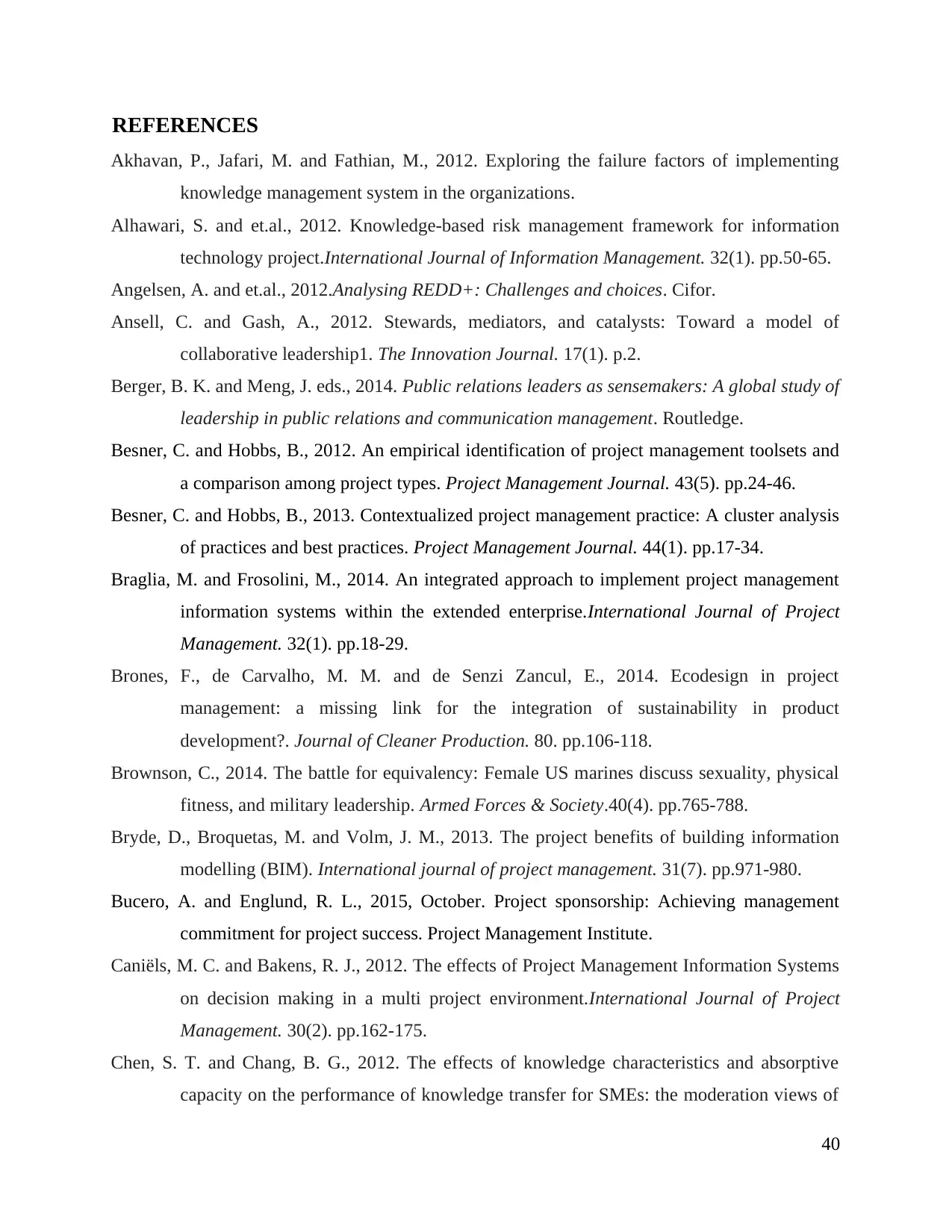
REFERENCES
Akhavan, P., Jafari, M. and Fathian, M., 2012. Exploring the failure factors of implementing
knowledge management system in the organizations.
Alhawari, S. and et.al., 2012. Knowledge-based risk management framework for information
technology project.International Journal of Information Management. 32(1). pp.50-65.
Angelsen, A. and et.al., 2012.Analysing REDD+: Challenges and choices. Cifor.
Ansell, C. and Gash, A., 2012. Stewards, mediators, and catalysts: Toward a model of
collaborative leadership1. The Innovation Journal. 17(1). p.2.
Berger, B. K. and Meng, J. eds., 2014. Public relations leaders as sensemakers: A global study of
leadership in public relations and communication management. Routledge.
Besner, C. and Hobbs, B., 2012. An empirical identification of project management toolsets and
a comparison among project types. Project Management Journal. 43(5). pp.24-46.
Besner, C. and Hobbs, B., 2013. Contextualized project management practice: A cluster analysis
of practices and best practices. Project Management Journal. 44(1). pp.17-34.
Braglia, M. and Frosolini, M., 2014. An integrated approach to implement project management
information systems within the extended enterprise.International Journal of Project
Management. 32(1). pp.18-29.
Brones, F., de Carvalho, M. M. and de Senzi Zancul, E., 2014. Ecodesign in project
management: a missing link for the integration of sustainability in product
development?. Journal of Cleaner Production. 80. pp.106-118.
Brownson, C., 2014. The battle for equivalency: Female US marines discuss sexuality, physical
fitness, and military leadership. Armed Forces & Society.40(4). pp.765-788.
Bryde, D., Broquetas, M. and Volm, J. M., 2013. The project benefits of building information
modelling (BIM). International journal of project management. 31(7). pp.971-980.
Bucero, A. and Englund, R. L., 2015, October. Project sponsorship: Achieving management
commitment for project success. Project Management Institute.
Caniëls, M. C. and Bakens, R. J., 2012. The effects of Project Management Information Systems
on decision making in a multi project environment.International Journal of Project
Management. 30(2). pp.162-175.
Chen, S. T. and Chang, B. G., 2012. The effects of knowledge characteristics and absorptive
capacity on the performance of knowledge transfer for SMEs: the moderation views of
40
Akhavan, P., Jafari, M. and Fathian, M., 2012. Exploring the failure factors of implementing
knowledge management system in the organizations.
Alhawari, S. and et.al., 2012. Knowledge-based risk management framework for information
technology project.International Journal of Information Management. 32(1). pp.50-65.
Angelsen, A. and et.al., 2012.Analysing REDD+: Challenges and choices. Cifor.
Ansell, C. and Gash, A., 2012. Stewards, mediators, and catalysts: Toward a model of
collaborative leadership1. The Innovation Journal. 17(1). p.2.
Berger, B. K. and Meng, J. eds., 2014. Public relations leaders as sensemakers: A global study of
leadership in public relations and communication management. Routledge.
Besner, C. and Hobbs, B., 2012. An empirical identification of project management toolsets and
a comparison among project types. Project Management Journal. 43(5). pp.24-46.
Besner, C. and Hobbs, B., 2013. Contextualized project management practice: A cluster analysis
of practices and best practices. Project Management Journal. 44(1). pp.17-34.
Braglia, M. and Frosolini, M., 2014. An integrated approach to implement project management
information systems within the extended enterprise.International Journal of Project
Management. 32(1). pp.18-29.
Brones, F., de Carvalho, M. M. and de Senzi Zancul, E., 2014. Ecodesign in project
management: a missing link for the integration of sustainability in product
development?. Journal of Cleaner Production. 80. pp.106-118.
Brownson, C., 2014. The battle for equivalency: Female US marines discuss sexuality, physical
fitness, and military leadership. Armed Forces & Society.40(4). pp.765-788.
Bryde, D., Broquetas, M. and Volm, J. M., 2013. The project benefits of building information
modelling (BIM). International journal of project management. 31(7). pp.971-980.
Bucero, A. and Englund, R. L., 2015, October. Project sponsorship: Achieving management
commitment for project success. Project Management Institute.
Caniëls, M. C. and Bakens, R. J., 2012. The effects of Project Management Information Systems
on decision making in a multi project environment.International Journal of Project
Management. 30(2). pp.162-175.
Chen, S. T. and Chang, B. G., 2012. The effects of knowledge characteristics and absorptive
capacity on the performance of knowledge transfer for SMEs: the moderation views of
40
Secure Best Marks with AI Grader
Need help grading? Try our AI Grader for instant feedback on your assignments.
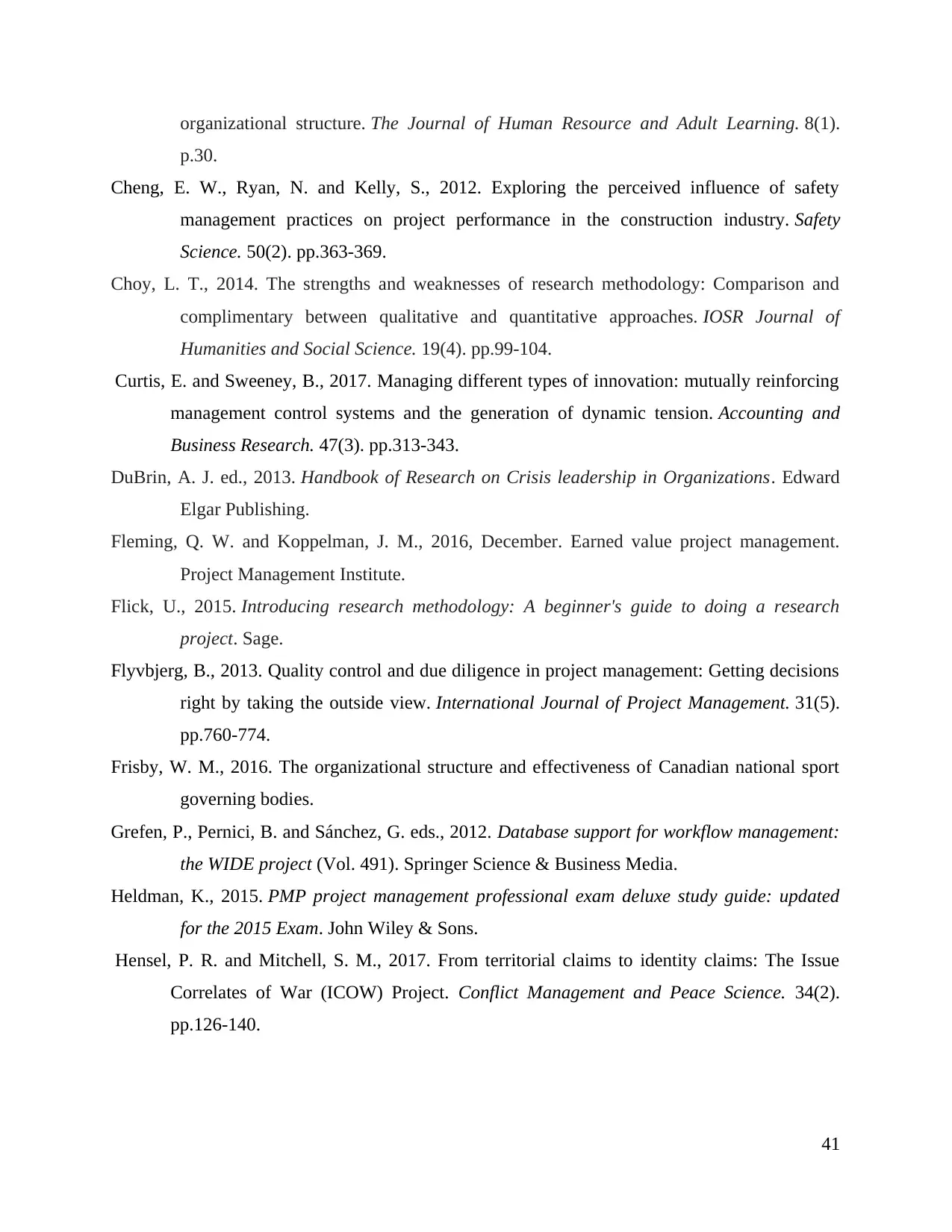
organizational structure. The Journal of Human Resource and Adult Learning. 8(1).
p.30.
Cheng, E. W., Ryan, N. and Kelly, S., 2012. Exploring the perceived influence of safety
management practices on project performance in the construction industry. Safety
Science. 50(2). pp.363-369.
Choy, L. T., 2014. The strengths and weaknesses of research methodology: Comparison and
complimentary between qualitative and quantitative approaches. IOSR Journal of
Humanities and Social Science. 19(4). pp.99-104.
Curtis, E. and Sweeney, B., 2017. Managing different types of innovation: mutually reinforcing
management control systems and the generation of dynamic tension. Accounting and
Business Research. 47(3). pp.313-343.
DuBrin, A. J. ed., 2013. Handbook of Research on Crisis leadership in Organizations. Edward
Elgar Publishing.
Fleming, Q. W. and Koppelman, J. M., 2016, December. Earned value project management.
Project Management Institute.
Flick, U., 2015. Introducing research methodology: A beginner's guide to doing a research
project. Sage.
Flyvbjerg, B., 2013. Quality control and due diligence in project management: Getting decisions
right by taking the outside view. International Journal of Project Management. 31(5).
pp.760-774.
Frisby, W. M., 2016. The organizational structure and effectiveness of Canadian national sport
governing bodies.
Grefen, P., Pernici, B. and Sánchez, G. eds., 2012. Database support for workflow management:
the WIDE project (Vol. 491). Springer Science & Business Media.
Heldman, K., 2015. PMP project management professional exam deluxe study guide: updated
for the 2015 Exam. John Wiley & Sons.
Hensel, P. R. and Mitchell, S. M., 2017. From territorial claims to identity claims: The Issue
Correlates of War (ICOW) Project. Conflict Management and Peace Science. 34(2).
pp.126-140.
41
p.30.
Cheng, E. W., Ryan, N. and Kelly, S., 2012. Exploring the perceived influence of safety
management practices on project performance in the construction industry. Safety
Science. 50(2). pp.363-369.
Choy, L. T., 2014. The strengths and weaknesses of research methodology: Comparison and
complimentary between qualitative and quantitative approaches. IOSR Journal of
Humanities and Social Science. 19(4). pp.99-104.
Curtis, E. and Sweeney, B., 2017. Managing different types of innovation: mutually reinforcing
management control systems and the generation of dynamic tension. Accounting and
Business Research. 47(3). pp.313-343.
DuBrin, A. J. ed., 2013. Handbook of Research on Crisis leadership in Organizations. Edward
Elgar Publishing.
Fleming, Q. W. and Koppelman, J. M., 2016, December. Earned value project management.
Project Management Institute.
Flick, U., 2015. Introducing research methodology: A beginner's guide to doing a research
project. Sage.
Flyvbjerg, B., 2013. Quality control and due diligence in project management: Getting decisions
right by taking the outside view. International Journal of Project Management. 31(5).
pp.760-774.
Frisby, W. M., 2016. The organizational structure and effectiveness of Canadian national sport
governing bodies.
Grefen, P., Pernici, B. and Sánchez, G. eds., 2012. Database support for workflow management:
the WIDE project (Vol. 491). Springer Science & Business Media.
Heldman, K., 2015. PMP project management professional exam deluxe study guide: updated
for the 2015 Exam. John Wiley & Sons.
Hensel, P. R. and Mitchell, S. M., 2017. From territorial claims to identity claims: The Issue
Correlates of War (ICOW) Project. Conflict Management and Peace Science. 34(2).
pp.126-140.
41
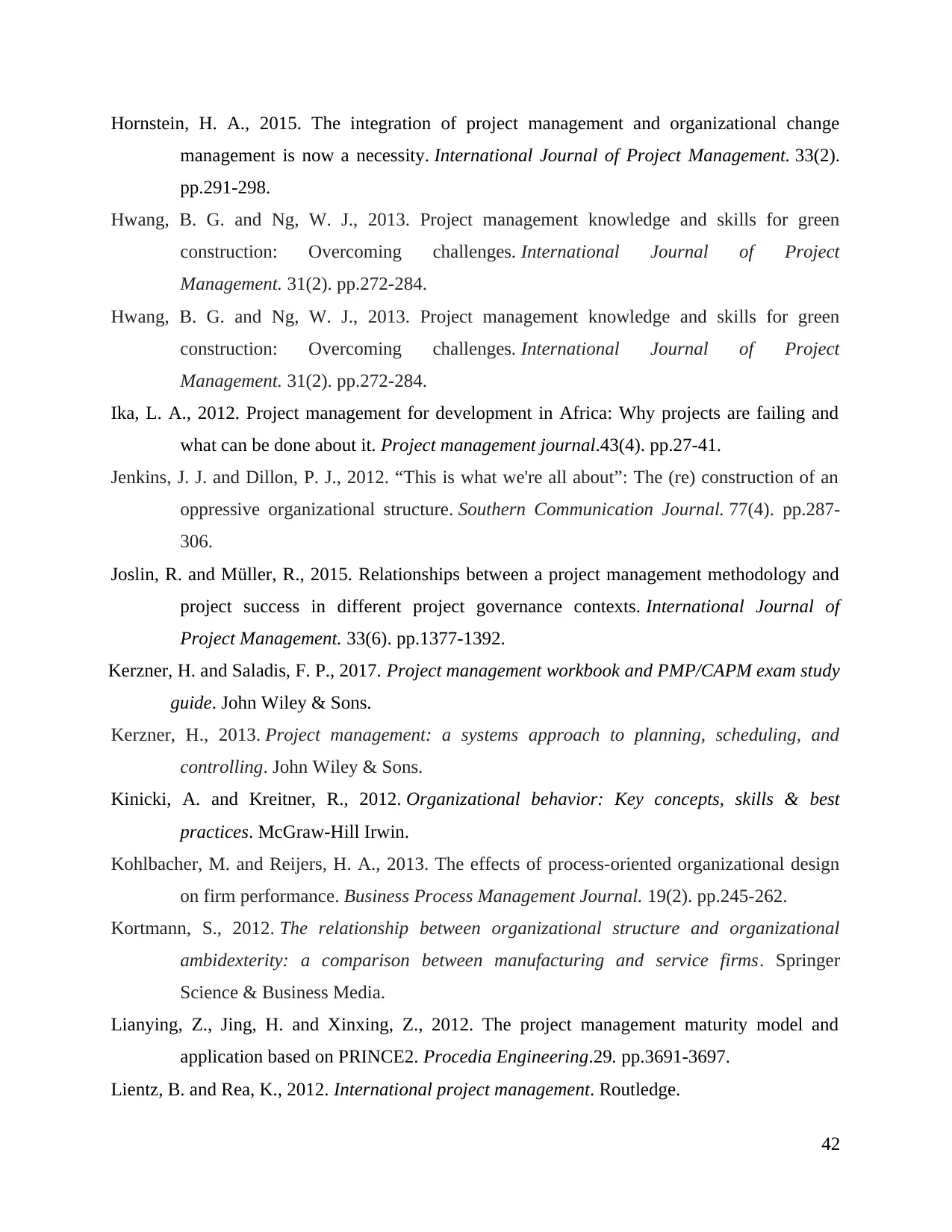
Hornstein, H. A., 2015. The integration of project management and organizational change
management is now a necessity. International Journal of Project Management. 33(2).
pp.291-298.
Hwang, B. G. and Ng, W. J., 2013. Project management knowledge and skills for green
construction: Overcoming challenges. International Journal of Project
Management. 31(2). pp.272-284.
Hwang, B. G. and Ng, W. J., 2013. Project management knowledge and skills for green
construction: Overcoming challenges. International Journal of Project
Management. 31(2). pp.272-284.
Ika, L. A., 2012. Project management for development in Africa: Why projects are failing and
what can be done about it. Project management journal.43(4). pp.27-41.
Jenkins, J. J. and Dillon, P. J., 2012. “This is what we're all about”: The (re) construction of an
oppressive organizational structure. Southern Communication Journal. 77(4). pp.287-
306.
Joslin, R. and Müller, R., 2015. Relationships between a project management methodology and
project success in different project governance contexts. International Journal of
Project Management. 33(6). pp.1377-1392.
Kerzner, H. and Saladis, F. P., 2017. Project management workbook and PMP/CAPM exam study
guide. John Wiley & Sons.
Kerzner, H., 2013. Project management: a systems approach to planning, scheduling, and
controlling. John Wiley & Sons.
Kinicki, A. and Kreitner, R., 2012. Organizational behavior: Key concepts, skills & best
practices. McGraw-Hill Irwin.
Kohlbacher, M. and Reijers, H. A., 2013. The effects of process-oriented organizational design
on firm performance. Business Process Management Journal. 19(2). pp.245-262.
Kortmann, S., 2012. The relationship between organizational structure and organizational
ambidexterity: a comparison between manufacturing and service firms. Springer
Science & Business Media.
Lianying, Z., Jing, H. and Xinxing, Z., 2012. The project management maturity model and
application based on PRINCE2. Procedia Engineering.29. pp.3691-3697.
Lientz, B. and Rea, K., 2012. International project management. Routledge.
42
management is now a necessity. International Journal of Project Management. 33(2).
pp.291-298.
Hwang, B. G. and Ng, W. J., 2013. Project management knowledge and skills for green
construction: Overcoming challenges. International Journal of Project
Management. 31(2). pp.272-284.
Hwang, B. G. and Ng, W. J., 2013. Project management knowledge and skills for green
construction: Overcoming challenges. International Journal of Project
Management. 31(2). pp.272-284.
Ika, L. A., 2012. Project management for development in Africa: Why projects are failing and
what can be done about it. Project management journal.43(4). pp.27-41.
Jenkins, J. J. and Dillon, P. J., 2012. “This is what we're all about”: The (re) construction of an
oppressive organizational structure. Southern Communication Journal. 77(4). pp.287-
306.
Joslin, R. and Müller, R., 2015. Relationships between a project management methodology and
project success in different project governance contexts. International Journal of
Project Management. 33(6). pp.1377-1392.
Kerzner, H. and Saladis, F. P., 2017. Project management workbook and PMP/CAPM exam study
guide. John Wiley & Sons.
Kerzner, H., 2013. Project management: a systems approach to planning, scheduling, and
controlling. John Wiley & Sons.
Kinicki, A. and Kreitner, R., 2012. Organizational behavior: Key concepts, skills & best
practices. McGraw-Hill Irwin.
Kohlbacher, M. and Reijers, H. A., 2013. The effects of process-oriented organizational design
on firm performance. Business Process Management Journal. 19(2). pp.245-262.
Kortmann, S., 2012. The relationship between organizational structure and organizational
ambidexterity: a comparison between manufacturing and service firms. Springer
Science & Business Media.
Lianying, Z., Jing, H. and Xinxing, Z., 2012. The project management maturity model and
application based on PRINCE2. Procedia Engineering.29. pp.3691-3697.
Lientz, B. and Rea, K., 2012. International project management. Routledge.
42
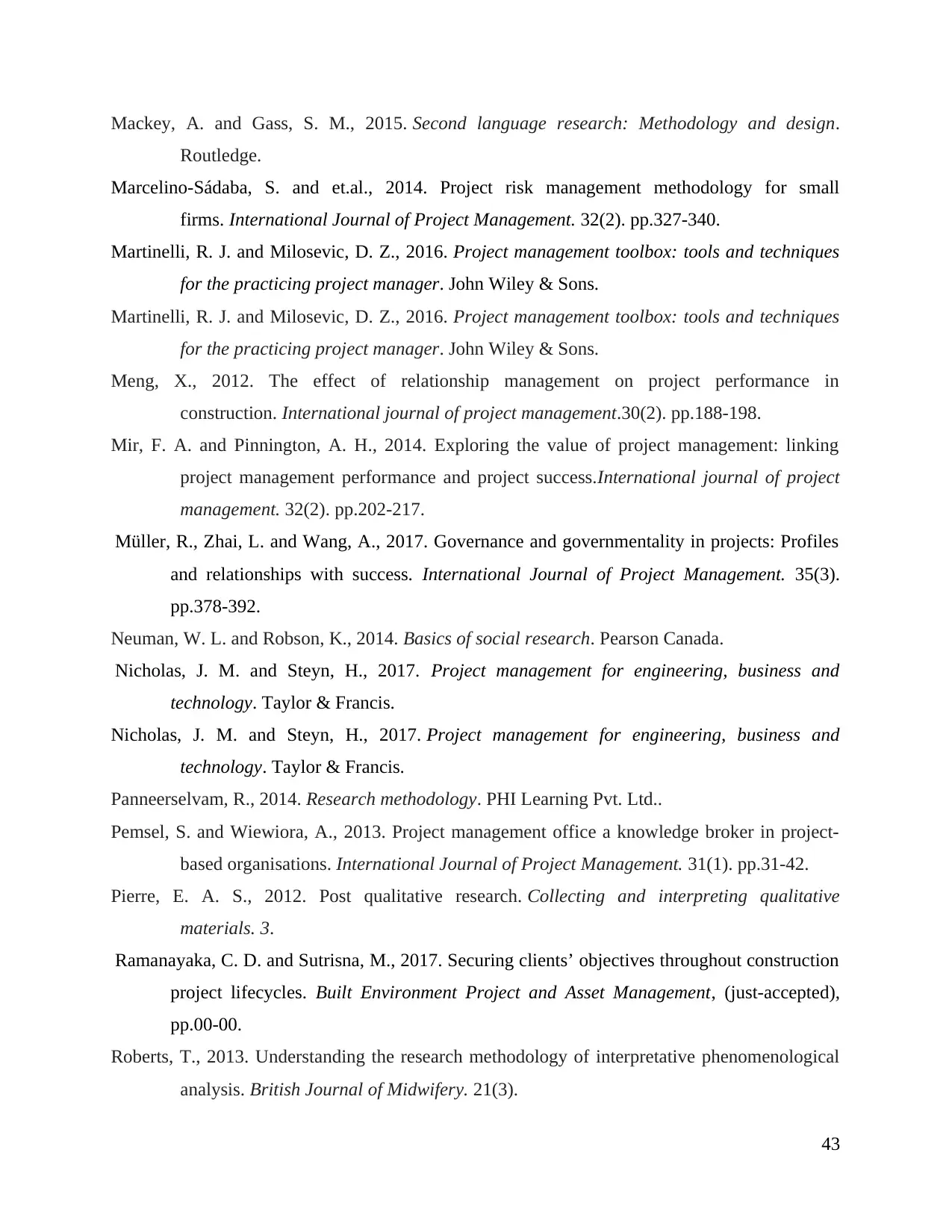
Mackey, A. and Gass, S. M., 2015. Second language research: Methodology and design.
Routledge.
Marcelino-Sádaba, S. and et.al., 2014. Project risk management methodology for small
firms. International Journal of Project Management. 32(2). pp.327-340.
Martinelli, R. J. and Milosevic, D. Z., 2016. Project management toolbox: tools and techniques
for the practicing project manager. John Wiley & Sons.
Martinelli, R. J. and Milosevic, D. Z., 2016. Project management toolbox: tools and techniques
for the practicing project manager. John Wiley & Sons.
Meng, X., 2012. The effect of relationship management on project performance in
construction. International journal of project management.30(2). pp.188-198.
Mir, F. A. and Pinnington, A. H., 2014. Exploring the value of project management: linking
project management performance and project success.International journal of project
management. 32(2). pp.202-217.
Müller, R., Zhai, L. and Wang, A., 2017. Governance and governmentality in projects: Profiles
and relationships with success. International Journal of Project Management. 35(3).
pp.378-392.
Neuman, W. L. and Robson, K., 2014. Basics of social research. Pearson Canada.
Nicholas, J. M. and Steyn, H., 2017. Project management for engineering, business and
technology. Taylor & Francis.
Nicholas, J. M. and Steyn, H., 2017. Project management for engineering, business and
technology. Taylor & Francis.
Panneerselvam, R., 2014. Research methodology. PHI Learning Pvt. Ltd..
Pemsel, S. and Wiewiora, A., 2013. Project management office a knowledge broker in project-
based organisations. International Journal of Project Management. 31(1). pp.31-42.
Pierre, E. A. S., 2012. Post qualitative research. Collecting and interpreting qualitative
materials. 3.
Ramanayaka, C. D. and Sutrisna, M., 2017. Securing clients’ objectives throughout construction
project lifecycles. Built Environment Project and Asset Management, (just-accepted),
pp.00-00.
Roberts, T., 2013. Understanding the research methodology of interpretative phenomenological
analysis. British Journal of Midwifery. 21(3).
43
Routledge.
Marcelino-Sádaba, S. and et.al., 2014. Project risk management methodology for small
firms. International Journal of Project Management. 32(2). pp.327-340.
Martinelli, R. J. and Milosevic, D. Z., 2016. Project management toolbox: tools and techniques
for the practicing project manager. John Wiley & Sons.
Martinelli, R. J. and Milosevic, D. Z., 2016. Project management toolbox: tools and techniques
for the practicing project manager. John Wiley & Sons.
Meng, X., 2012. The effect of relationship management on project performance in
construction. International journal of project management.30(2). pp.188-198.
Mir, F. A. and Pinnington, A. H., 2014. Exploring the value of project management: linking
project management performance and project success.International journal of project
management. 32(2). pp.202-217.
Müller, R., Zhai, L. and Wang, A., 2017. Governance and governmentality in projects: Profiles
and relationships with success. International Journal of Project Management. 35(3).
pp.378-392.
Neuman, W. L. and Robson, K., 2014. Basics of social research. Pearson Canada.
Nicholas, J. M. and Steyn, H., 2017. Project management for engineering, business and
technology. Taylor & Francis.
Nicholas, J. M. and Steyn, H., 2017. Project management for engineering, business and
technology. Taylor & Francis.
Panneerselvam, R., 2014. Research methodology. PHI Learning Pvt. Ltd..
Pemsel, S. and Wiewiora, A., 2013. Project management office a knowledge broker in project-
based organisations. International Journal of Project Management. 31(1). pp.31-42.
Pierre, E. A. S., 2012. Post qualitative research. Collecting and interpreting qualitative
materials. 3.
Ramanayaka, C. D. and Sutrisna, M., 2017. Securing clients’ objectives throughout construction
project lifecycles. Built Environment Project and Asset Management, (just-accepted),
pp.00-00.
Roberts, T., 2013. Understanding the research methodology of interpretative phenomenological
analysis. British Journal of Midwifery. 21(3).
43
Paraphrase This Document
Need a fresh take? Get an instant paraphrase of this document with our AI Paraphraser
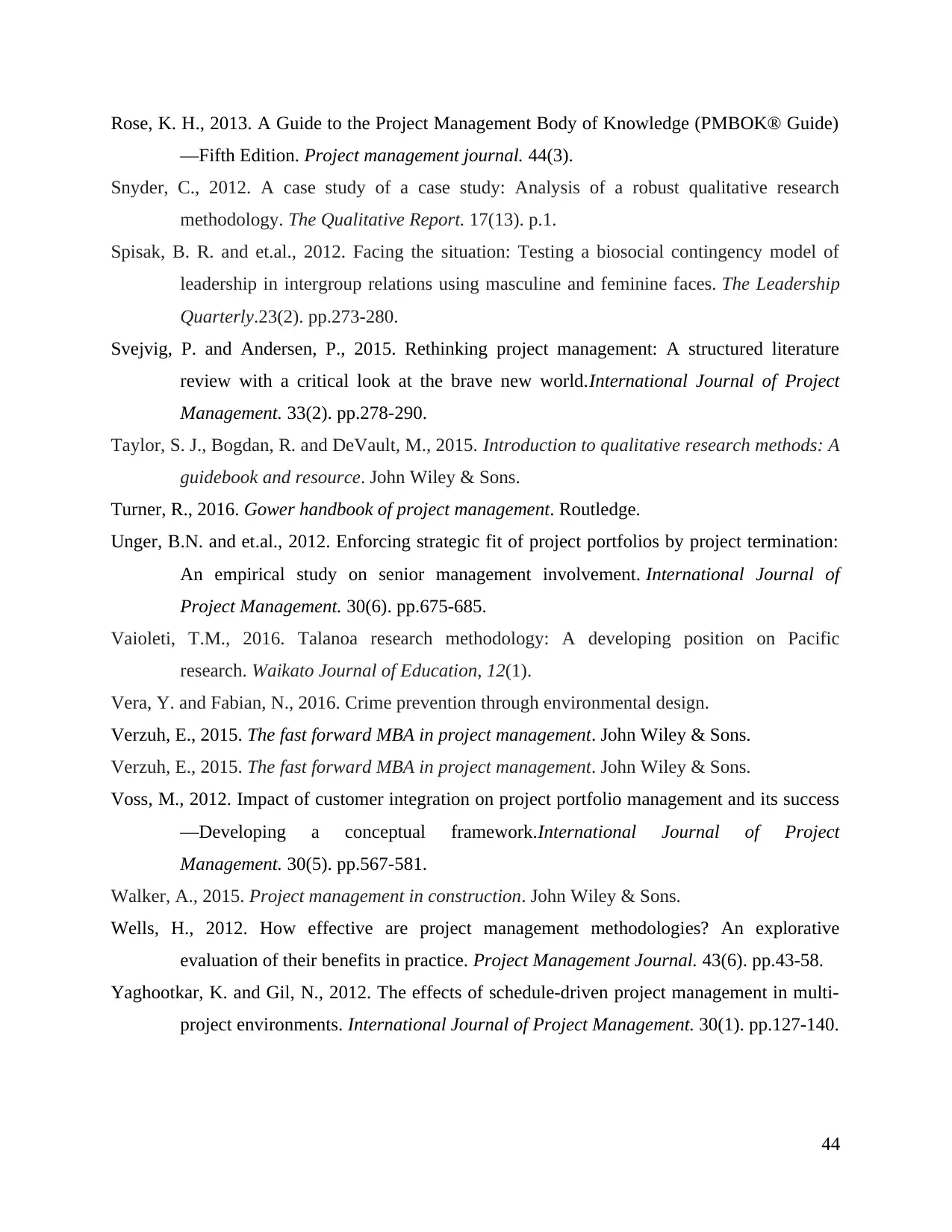
Rose, K. H., 2013. A Guide to the Project Management Body of Knowledge (PMBOK® Guide)
—Fifth Edition. Project management journal. 44(3).
Snyder, C., 2012. A case study of a case study: Analysis of a robust qualitative research
methodology. The Qualitative Report. 17(13). p.1.
Spisak, B. R. and et.al., 2012. Facing the situation: Testing a biosocial contingency model of
leadership in intergroup relations using masculine and feminine faces. The Leadership
Quarterly.23(2). pp.273-280.
Svejvig, P. and Andersen, P., 2015. Rethinking project management: A structured literature
review with a critical look at the brave new world.International Journal of Project
Management. 33(2). pp.278-290.
Taylor, S. J., Bogdan, R. and DeVault, M., 2015. Introduction to qualitative research methods: A
guidebook and resource. John Wiley & Sons.
Turner, R., 2016. Gower handbook of project management. Routledge.
Unger, B.N. and et.al., 2012. Enforcing strategic fit of project portfolios by project termination:
An empirical study on senior management involvement. International Journal of
Project Management. 30(6). pp.675-685.
Vaioleti, T.M., 2016. Talanoa research methodology: A developing position on Pacific
research. Waikato Journal of Education, 12(1).
Vera, Y. and Fabian, N., 2016. Crime prevention through environmental design.
Verzuh, E., 2015. The fast forward MBA in project management. John Wiley & Sons.
Verzuh, E., 2015. The fast forward MBA in project management. John Wiley & Sons.
Voss, M., 2012. Impact of customer integration on project portfolio management and its success
—Developing a conceptual framework.International Journal of Project
Management. 30(5). pp.567-581.
Walker, A., 2015. Project management in construction. John Wiley & Sons.
Wells, H., 2012. How effective are project management methodologies? An explorative
evaluation of their benefits in practice. Project Management Journal. 43(6). pp.43-58.
Yaghootkar, K. and Gil, N., 2012. The effects of schedule-driven project management in multi-
project environments. International Journal of Project Management. 30(1). pp.127-140.
44
—Fifth Edition. Project management journal. 44(3).
Snyder, C., 2012. A case study of a case study: Analysis of a robust qualitative research
methodology. The Qualitative Report. 17(13). p.1.
Spisak, B. R. and et.al., 2012. Facing the situation: Testing a biosocial contingency model of
leadership in intergroup relations using masculine and feminine faces. The Leadership
Quarterly.23(2). pp.273-280.
Svejvig, P. and Andersen, P., 2015. Rethinking project management: A structured literature
review with a critical look at the brave new world.International Journal of Project
Management. 33(2). pp.278-290.
Taylor, S. J., Bogdan, R. and DeVault, M., 2015. Introduction to qualitative research methods: A
guidebook and resource. John Wiley & Sons.
Turner, R., 2016. Gower handbook of project management. Routledge.
Unger, B.N. and et.al., 2012. Enforcing strategic fit of project portfolios by project termination:
An empirical study on senior management involvement. International Journal of
Project Management. 30(6). pp.675-685.
Vaioleti, T.M., 2016. Talanoa research methodology: A developing position on Pacific
research. Waikato Journal of Education, 12(1).
Vera, Y. and Fabian, N., 2016. Crime prevention through environmental design.
Verzuh, E., 2015. The fast forward MBA in project management. John Wiley & Sons.
Verzuh, E., 2015. The fast forward MBA in project management. John Wiley & Sons.
Voss, M., 2012. Impact of customer integration on project portfolio management and its success
—Developing a conceptual framework.International Journal of Project
Management. 30(5). pp.567-581.
Walker, A., 2015. Project management in construction. John Wiley & Sons.
Wells, H., 2012. How effective are project management methodologies? An explorative
evaluation of their benefits in practice. Project Management Journal. 43(6). pp.43-58.
Yaghootkar, K. and Gil, N., 2012. The effects of schedule-driven project management in multi-
project environments. International Journal of Project Management. 30(1). pp.127-140.
44
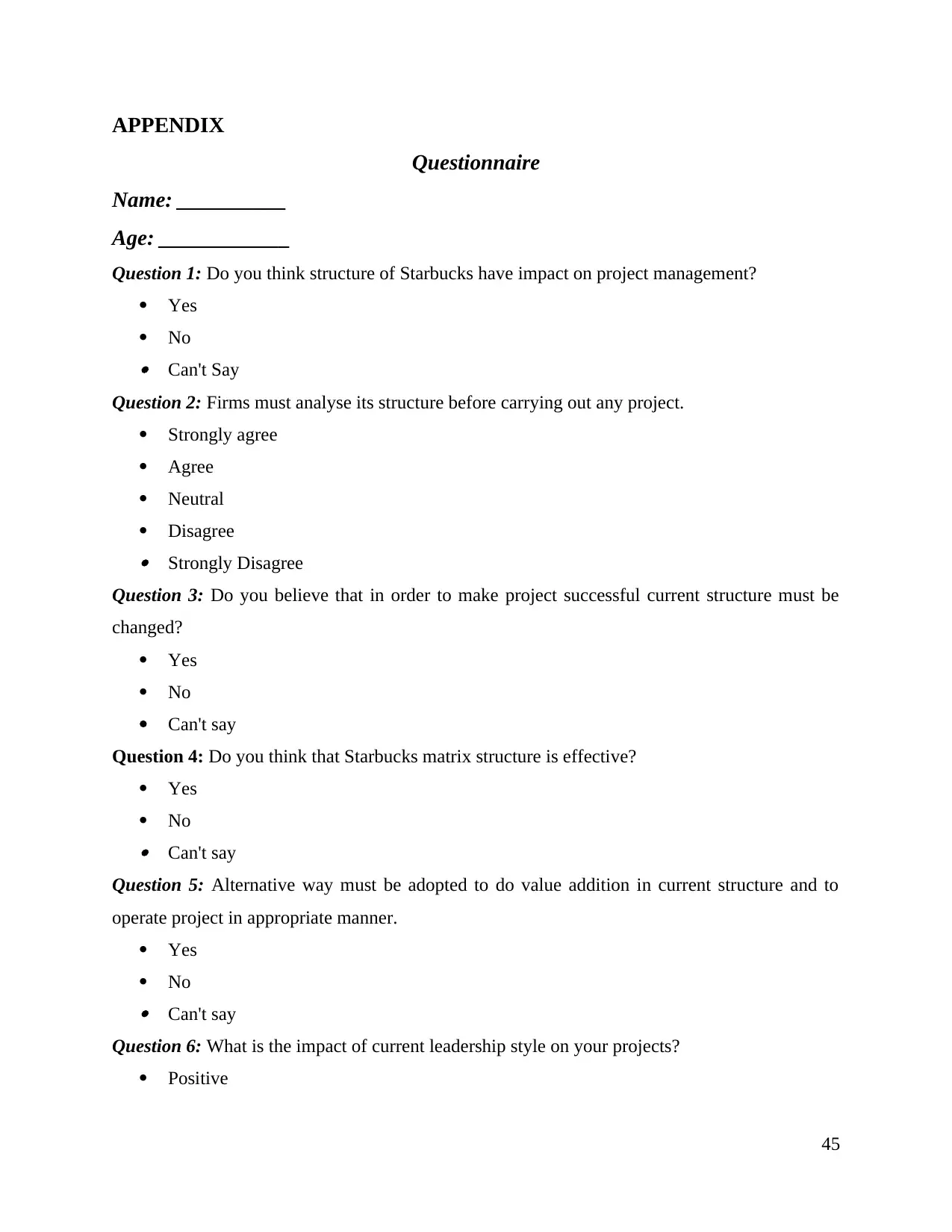
APPENDIX
Questionnaire
Name: __________
Age: ____________
Question 1: Do you think structure of Starbucks have impact on project management?
Yes
No Can't Say
Question 2: Firms must analyse its structure before carrying out any project.
Strongly agree
Agree
Neutral
Disagree Strongly Disagree
Question 3: Do you believe that in order to make project successful current structure must be
changed?
Yes
No
Can't say
Question 4: Do you think that Starbucks matrix structure is effective?
Yes
No Can't say
Question 5: Alternative way must be adopted to do value addition in current structure and to
operate project in appropriate manner.
Yes
No Can't say
Question 6: What is the impact of current leadership style on your projects?
Positive
45
Questionnaire
Name: __________
Age: ____________
Question 1: Do you think structure of Starbucks have impact on project management?
Yes
No Can't Say
Question 2: Firms must analyse its structure before carrying out any project.
Strongly agree
Agree
Neutral
Disagree Strongly Disagree
Question 3: Do you believe that in order to make project successful current structure must be
changed?
Yes
No
Can't say
Question 4: Do you think that Starbucks matrix structure is effective?
Yes
No Can't say
Question 5: Alternative way must be adopted to do value addition in current structure and to
operate project in appropriate manner.
Yes
No Can't say
Question 6: What is the impact of current leadership style on your projects?
Positive
45
1 out of 51
Related Documents
Your All-in-One AI-Powered Toolkit for Academic Success.
+13062052269
info@desklib.com
Available 24*7 on WhatsApp / Email
![[object Object]](/_next/static/media/star-bottom.7253800d.svg)
Unlock your academic potential
© 2024 | Zucol Services PVT LTD | All rights reserved.





